- Skip to primary navigation
- Skip to main content
- Skip to primary sidebar
- Skip to footer
Yacht Cruising Lifestyle
Everything fun you can do from your yacht

Choosing the Best Dinghy for Your Boat
January 7, 2021 by Travis Turgeon 5 Comments
At anchor, a dinghy boat serves as your lifeline to everything from leisurely excursions to provisioning trips. Every captain or crew will use their dinghy differently, so it’s essential to consider what features and functions are important to you.
Do you plan to explore remote areas away from anchor? Do you plan to fish, snorkel, or dive from the dinghy? How many people will you need to carry at once? Every aspect should play into your decision.
Below, we cover the following to help you choose a dinghy that’s right for your boat:
- Key Factors to Consider
- Types of Dinghies
- Outboard Motors
General Information and Tips
What should i consider before buying a dinghy for my boat.
Make the following considerations before purchasing a dinghy for your boat:
- DInghy Storage
- Carrying Capacity
- Use of the Vessel
Dinghy Storage
Storage should be a defining factor when purchasing a dinghy for your boat. There are several common ways to store a dinghy, but not all storage is suitable for every vessel. A rigid dinghy will need enough space to be tied on the deck or at the back of the boat, while you can stow an inflatable dinghy in lockers or lazarettes.
Regardless of where you choose to keep your dinghy on the boat, it should be in a location that does not reduce drag, restrict access to important areas, or prevent easy access for storage and use.
The most common options are:
- Dinghy Davits
- On-Deck
- Locker
Davits: Permanently installed at the stern of the boat, davits are used to store, deploy, and retrieve your dinghy from the water. Davit storage is standard for any dinghy that’s too heavy to manually lift in and out of the water. Although storage on dinghy davits is convenient, it poses a risk when sailing through heavy seas. Large waves and wind can cause the dinghy to flood while in transit, and the weight can damage the stern of the boat or the davits.
On-Deck: Some people choose to tie the dinghy upside-down at the bow, stern, or side of the boat. For this to be an option, you need sufficient unused space on the deck, and you need to be sure that the dinghy is not interfering with any important pathway or area on the boat.
Swim-Step: Boats with an elevated swim-step can accommodate a dinghy at the boat’s stern as long as it’s elevated far enough out of the water. Keep the dinghy tied aerodynamically and tilted so that it doesn’t fill with water.
Locker: Roll-up inflatable dinghies are easily deployed and retrieved from the water by hand, and they can be deflated and stored in a locker anywhere onboard.
Towed: For nearshore journeys in calm conditions, you can easily pull the dinghy behind your boat. Be careful, though, as high speeds and choppy seas can cause a dinghy to flip in the water.
Dinghy Carrying Capacity
If you’re sailing with multiple crew or passengers, you will want a dinghy that can carry the same amount of people. Making numerous trips from ship to shore will not only cost you time, but it will also run up fuel costs. Further, you’ll want extra room for luggage, provisions, recreational gear, and anything else that may find its way onto your boat.
The handling in your dinghy can become problematic when loaded beyond capacity, so use caution – especially in rough seas. Safety should always be a top priority, so the goal is to aim for the biggest dinghy you can get without sacrificing too much storage space.
Dinghy Material
Rigid dinghies are most commonly made of fiberglass or aluminum, but you can opt for a more classic wooden design as well. The material will partially dictate where the dinghy can be stored and the need for equipment such as dinghy davits. While fiberglass hulls are cheaper than aluminum, they also come with the burden of a heavier weight. Alternatively, aluminum hulls will outlast their fiberglass counterparts, but for a higher price. Overall, rigid dinghies can withstand wear-and-tear better than inflatables, although routine maintenance is required.
Inflatable dinghies are kept afloat using tubes surrounding the boat’s hull, commonly made of either PVC or CSE. CSE, or “Hypalon,” is a synthetic rubber material that is highly resistant to chemicals, UV light, extreme temperatures, and abrasion. CSE is a lot like PVC, but it’s lighter and has more UV and water-resistant properties. It’s also more abrasion resistant, making it ideal for taking to shore. CSE offers a longer service life and a more extended warranty, although again at a higher cost. The most common complaint you’ll hear about CSE is the rate at which the air escapes from the tubes. On average, CSE tubes lose about 15% of their air within 24 hours, while PVC loses under 7%.
PVC is an excellent alternative to the more durable CSE, as the material still offers a reasonable service life at a lower cost. PVC is also much lighter, more convenient to fold, and easier to clean than CSE. The biggest potential problem with PVC is simple neglect and lack of maintenance. If cared for properly, modern PVC materials can last long enough to justify not paying the higher costs for CSE.
For some excellent tips on maintaining your inflatable dinghy, check out Sail Magazine’s Tender Choices article , here.
How You’ll Use The Dinghy
The last factor to consider is how you intend to use the vessel. Will you be traveling long distances from anchor? Exploring remote locations? How many people do you need to transport? Do you need special features to accommodate scuba diving and fishing? You should do as much research as you can to ensure that you’re buying a tender that suits your needs while staying within your budget. Below, we discuss the difference between each type of dinghy – and who each is best suited for.
Types of Dinghies
Choosing the right type of dinghy for you and your boat will require some careful thought. Your dinghy is your primary source of transportation between journeys, and you’ll want to make sure that your purchase is fitting for your immediate and future needs.
The three most common types of dinghies are:
Rigid Boats
Inflatable boats, rigid inflatable boats (rib).
Hard-body (rigid) dinghies are among the simplest styles of tender, and they come in a variety of shapes, sizes, and materials. Rigid dinghies are sufficient for those who don’t need to travel long distances or through rough conditions. However, more and more people are moving to inflatables or semi-inflatables for their wide range of abilities when needed.
When considering if a rigid dinghy is right for you, think hard about the material each is built with. For the hull specifically, the materials will affect the price, durability, and cosmetics of the vessel, as well as the weight and ability to transport. Most rigid dinghies are constructed with fiberglass, aluminum, or wood and have a lower carrying capacity than inflatables. They also have less stability when entering, exiting, and moving through the water.
Advantages:
- Easily Propelled
- Puncture Resistant
- Outboard Compatible
- Low-Cost Option
- UV Resistant
Disadvantages:
- Easily Scratched and Blemished
- Adequate Storage Space Required
More popular than rigid dinghies and less popular than RIB’s, inflatables offer a good middle ground for those looking to compromise between cost and functionality. The large PVC or Polyurethane tubes in the front and sides of the boat are more stable than rigid vessels and allow for a higher carrying capacity due to their buoyancy. Compare those benefits with the low costs of materials, and it’s easy to see why inflatables are so popular.
There are numerous variations of Inflatable dinghies, with the most common being:
- Soft Bottom Roll-Up
- Rigid Floor with Soft Bottom
- Soft Bottom with Rigid Transom
Dinghies with soft bottom have the widest variance in configuration. Some have rigid transoms where an outboard motor can be mounted. Some have rigid, removable floors, and some have an inflatable keel that increases the vessel’s stability and planing abilities. Other than the lower-end inflatables, though, almost all will have stable floors and a captain’s seat. Rowing is difficult in rough conditions, so inflatables are most commonly used with a 5-10 horsepower outboard.
Roll-up inflatables are easily stored, don’t take up much space, and are the lightest of all inflatable options. They also have the least to offer in functionality, and since most don’t have a rigid transom, they must be rowed by hand. Unless you only plan to use the vessel in calm conditions, you should consider dinghies with hard floors and transoms.
Soft bottom dinghies with rigid floors and transoms are more ideal, as they can be used efficiently in a wider variety of situations. The ability to mount an outboard allows you to use the vessel in harsher conditions and travel greater distances. The rigid floors allow you to use the vessel for fishing, diving, provisioning, and more without sacrificing stability and comfort.
- Lightest Option
- Easily Compacted and Stored
- Easily Damaged and Punctured
- Consistent Maintenance Required
- Low Efficiency
The RIB design is a cross between a soft bottom and rigid hull and gives you the most bang for your buck in the water. The hard-bodied hull makes for a stable and damage-resistant body, while the inflatable tubes add optimal stability. The RIB design is so efficient that it’s even used by the US Military and Coast Guard. The tradeoff you make with a RIB is portability and storage, as the hull can not be taken apart or broken down. However, this can be overlooked by carefully choosing a RIB that’s right for your boat. If you’re looking to outfit your boat for scuba diving , a RIB should be pretty much your only consideration for a tender.
Rigid Inflatable Dinghies are the most popular type of dinghy for cruising sailors, and it’s easy to see why. RIBs used as dinghies are commonly between 10 and 15-feet long, with anything larger being reserved for massive yachts with dinghy garages or excess storage space. RIBs are typically stored on davits or lashed upside down somewhere on the deck of the boat. For shorter trips near shore and in calm conditions, you can tow the RIB behind the boat.
Typically, RIBs are available with either aluminum or fiberglass hulls. Aluminum is lighter and stronger than fiberglass, although you should expect to see a price tag that matches those benefits.
- Optimal Speed, Handling, and Stability Rugged
- Limited Storage Options
Outboard Dinghy Motors
After choosing the dinghy that’s right for you and your vessel, you’ll need to select an outboard to fit. You’ll want something powerful enough to make the dinghy plane at full capacity but also light enough to transfer to and from the dinghy‘s transom. Before making a decision, check with the manufacturer to determine the recommended power output for your intended use.
Generally speaking, fully inflatable dinghies that measure around 10-feet in length support a 5-8 horsepower outboard, which is sufficient for the basics. For a more capable inflatable, look for a 10-25 horsepower outboard. Just be cautious, as too much power can flip a lightweight dinghy.
Similarly, a 10-foot RIB will support a heavier engine, such as a 10-15 horsepower outboard that provides enough power for the boat to plane while carrying more than one passenger. For more capability, look for an outboard in the 20-50 horsepower range.
Either way, you’ll need to decide your dinghy’s primary purpose and buy an outboard to support it.
If it’s simply used for trips to shore in calm conditions, a lower-powered outboard will likely be sufficient. The more power you can apply, the more capable your dinghy will become. Further, the maximum power output of the engine should always exceed the recommendations for operating the dinghy at full capacity. If you have a powerful outboard, you won’t have to worry as much about overworking the engine when the boat is full.
When determining which motor is right for you, keep in mind the storage and transportation options you have. If you need to lift the dinghy and outboard out of the water manually, it might be safe to say that the lighter the outboard’s weight, the better. If your back can handle the extra weight, though, the 4-stroke engines are far better suited for things like water sports and rough surface conditions.
Dinghy Excursion Checklist
- Check inflation levels and make sure there is no water inside the boat. If there is, look for leaks or damage.
- Ensure the boat is free of all loose lines, flags, or anything that could get caught in the boat propeller.
- Check to make sure the outboard is appropriately and securely mounted to the transom.
- Quickly test both the forward and reverse gears to make sure everything is working as it should.
- Test the lights on the dinghy, even if it’s still light out.
- Check for paddles, lifejackets, first-aid kits, and dinghy repair kits.
Operating the Dinghy
- When operating the dinghy alone, clip the emergency motor stop to your clothing. If you fall overboard, your motor will stop.
- Be cautious when using a powerful outboard. Too much power can cause a lightweight inflatable to flip or overturn.
- Bring the dinghy upwind when returning to your boat for a more controlled approach.
- Always use both front and rear-facing lights when operating the dinghy after dark.
- When towing the dinghy behind your boat, experiment with the length of the tow rope to find the smoothest pull.
- If there is any surf present, do not attempt to beach your dinghy.
- Use a dinghy anchor if there are large tide changes, waves, or swells present.
- Keep a dinghy repair kit on board at all times in case of small punctures or tears.
- Dinghy covers reduce UV light exposure and prolong the life of the dinghy by up to five years.
- Cosmetically, CSE doesn’t wear down for about 10 years. PVC begins to look rough after only a few.
- Consider where you intend to use your dinghy. Will it be in locations with high swells, rocky shores, and cold water? If so, consider a more rugged and damage-resistant material.
- Before purchasing a dinghy, visit a few boat shows, and read user reviews. You want to be comfortable making a purchase, and having first-hand resources to chat with is the best way to feel confident about your decision.
- Keep your dinghy insured separately in case of incidents that happen away from your yacht.
- Dinghies and their outboard motors are common targets of theft, so be sure to lock up both whenever possible.
When choosing a dinghy for your cruising lifestyle, it’s important to know exactly how to buy a new or used boat and what considerations should be prioritized.
Join the #BoatLife community and contribute to our new forum! Get a new conversation started, or use your experience to address existing posts.
If you found this article helpful, please leave a comment below, share it on social media, and subscribe to our email list.
For direct questions and comments, shoot me an email at [email protected]
Sharing is caring!
Reader Interactions
July 3, 2021 at 10:26 am
I have one for my canoe, my dinghy, and my power boat So, the next time you see a 5 year old boat in Seabridge marina in Ventura California, that looks brand new, it’s my boat.
July 30, 2021 at 8:17 am
It is a great article and quite intresting to read too thanks for sharing such good information with us.
August 1, 2021 at 4:15 pm
Thanks for reading, Cassey. We’re always here to help – don’t hesitate to reach out with any questions or comments!
December 14, 2021 at 2:08 pm
Travis – My name is Mark and I am a member of the Great Lakes Cruising Club. We’ve been around since 1934, we have 2,500 US & Canadian members and we are a volunteer driven organization. For the last twelve years we have operated an on-line school, the GLCCSchool.com. Annually we present 35-40 webinars and have an attendance of around 900 people. We really liked your article on dinghies and are wondering if you would consider turning that into a presentation for our school. If you have the slightest interest please check us out and send me an email so we can explore this further. Thanks.
January 23, 2022 at 2:27 pm
Thank you for all of the applicable information. I appreciate how the differences of each type of boat were well defined. This article was extremely helpful.
Leave a Reply Cancel reply
Your email address will not be published. Required fields are marked *
Save my name, email, and website in this browser for the next time I comment.
MB #20512 PO BOX 480 Sevenoaks Kent TN13 9JY
Tel: +44 56 0386 9163
Keep In Touch
Thank you for reading.
Join our online crew and find more about the #boatlife
- New Sailboats
- Sailboats 21-30ft
- Sailboats 31-35ft
- Sailboats 36-40ft
- Sailboats Over 40ft
- Sailboats Under 21feet
- used_sailboats
- Apps and Computer Programs
- Communications
- Fishfinders
- Handheld Electronics
- Plotters MFDS Rradar
- Wind, Speed & Depth Instruments
- Anchoring Mooring
- Running Rigging
- Sails Canvas
- Standing Rigging
- Diesel Engines
- Off Grid Energy
- Cleaning Waxing
- DIY Projects
- Repair, Tools & Materials
- Spare Parts
- Tools & Gadgets
- Cabin Comfort
- Ventilation
- Footwear Apparel
- Foul Weather Gear
- Mailport & PS Advisor
- Inside Practical Sailor Blog
- Activate My Web Access
- Reset Password
- Customer Service

- Free Newsletter

Tartan 30: An Affordable Classic

Ericson 34-2 Finds Sweet Spot

How to Sell Your Boat

Cal 2-46: A Venerable Lapworth Design Brought Up to Date

Solar Panels: Go Rigid If You have the Space…

Leaping Into Lithium

The Importance of Sea State in Weather Planning

Do-it-yourself Electrical System Survey and Inspection

When Should We Retire Dyneema Stays and Running Rigging?

Rethinking MOB Prevention

Top-notch Wind Indicators

The Everlasting Multihull Trampoline

What Your Boat and the Baltimore Super Container Ship May Have…

Check Your Shorepower System for Hidden Dangers

DIY survey of boat solar and wind turbine systems

What’s Involved in Setting Up a Lithium Battery System?

Waste Not is the Rule. But How Do We Get There?

The Scraper-only Approach to Bottom Paint Removal

How to Handle the Head

The Day Sailor’s First-Aid Kit

Choosing and Securing Seat Cushions

Cockpit Drains on Race Boats

Re-sealing the Seams on Waterproof Fabrics

Safer Sailing: Add Leg Loops to Your Harness

Waxing and Polishing Your Boat

Reducing Engine Room Noise

Tricks and Tips to Forming Do-it-yourself Rigging Terminals

Marine Toilet Maintenance Tips

Learning to Live with Plastic Boat Bits
- Sailboat Reviews
Practical Sailor Reviews Seven Performance-Sailing Dinghies
Agile, fun boats like the classic sunfish and new hobie bravo keep the smile in summer sailing..
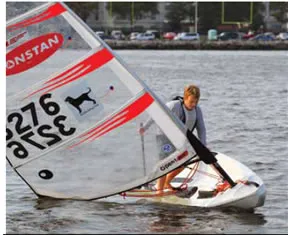
Photos by Ralph Naranjo
Messing around in small boats is a global theme-one thats embraced by pond-bound pram sailors, river riders, lake voyagers, and all of us who call salt water home. The purpose of this sailing dinghy profile is to highlight seven very interesting little sailboats. Some are new designs, and others have stood the test of time, but all are currently being manufactured, and each drives home just how much fun sailing close to the water can be.
This isn’t a shootout among anorexic speedsters or a report on the best tender that doubles as a sailing dinghy. Its a look at perennials like the Optimist, Sunfish, and Laser-legendary competitors that have helped spawn some of the best sailors in the world. But its also a look at three of the newest entries in the dinghy-sailing circle: Bics Open, Hobies Bravo, and Laser Performances Bug. These agile, new sailing dinghies are chock full of fun and boat-handling features to inspire kids of all ages to go sailing.
Well also take a look at Chesapeake Light Crafts kit approach to getting started-one that offers meaningful lessons and tangible rewards well before the boat ever hits the water.
Scale down an Open 60, add sail technology long favored by windsurfers, and put it into play in a tough thermo-formed hull, and you have the makings for a new kind of watercraft. The result is a very interesting blend of performance and reliability that targets adolescent interest. When all is said and done, Bics boat is more akin to a sit-down windsurfer than a traditional Blue Jay. And like all good boats, its vying for attention not just based on performance, construction quality, and style, but just as importantly, on the price tag stuck to the hull.
The Open Bics light weight and wide, flat stern section means that even small chop can be surfed; and bursts of planing on a reach add a zing factor to dinghy sailing. The Open Bic is already an International Sailing Federation (ISAF)-sanctioned class, and fleets are developing around the US. Another bonus: Its an easily portable boat that can be carried like a windsurfer, adding excitement to a Sunday picnic at the beach.
The thermo-formed polyethylene hull is a modified hard-chine design with lots of beam aft. Sailed flat, the boat is agile enough to surf wavelets, and with a shape thats ergonomically friendly to hiking, the ensuing heel on the upwind leg puts just the right amount of chine into the water. In light air, careful control of heel can significantly reduce wetted surface.
The design team that developed the Open Bic saw it as a transition bridge from Optimist sailing to a more performance-oriented dinghy. An interesting innovation is that the Open Bic can be sailed with an Optimists rig and blades. This buy the hull only approach can be a significant incentive for parents with children outgrowing their Opti as fast as their boat shoes. However it wont be long before the kids want the fully turbo-charged feel delivered with the Open Bics well-shaped 4.5-square-meters rig, sail, and nicely foiled blades.
Bottom line: The Open Bic is fast, agile, and buckets of fun for kids uninspired by sailing in the slow lane.
Just when you think that Hobie Cat Co. has covered whats possible in beach-cat innovation, their design/engineering crew comes up with a new twist that reinvents the wheel. The Hobie Bravo is a good case in point.
In a recent visit to Backyard Boats ( www.backyardboats.com ) in Annapolis, Md., we got a good look at the Bravo. Nearly as narrow as a monohull but still quite stable, this quick-to-launch beach cat packs plenty of get-up-and-go. Its a simple to sail, entry-level boat that fast tracks learning the steer, sheet, and hike trilogy. The boat features a single, midline rudder and roto-molded hulls. The shape of the hulls provides enough lateral plane to allow a crew to make headway to windward.
The narrow (4 feet), 12-foot Bravo uses crew weight and hiking straps to add to the righting moment once the breeze is up. Whats done with webbing on larger cats has been converted to a shallow, rigid deck well on the Bravo. It does raise the weight of the boat to 195 pounds, but it offers comfortable seating plus room for cushions and a cooler. Kids or grown ups can have a Tom Sawyer-Huck Finn type of adventure aboard this fun little sailing machine. Or the family on a beach picnic can set it up and take turns speed reaching along a sandy shoreline.
The furling mast supports a roachy sail with slightly slanted vertical battens, helping to shape the boomless mainsail. The result is convenient sail handling, decent performance, and superior safety. Theres no boom to clobber the crew, and the roller-furled sail and mast are easily stepped in the tripod-like receiver. This interesting set of struts raises the top bearing point of the mast step and spreads rig loads out to the hulls. The furling mainsail offers the ability to reef, a big plus in a building breeze or when teaching children to sail.
Like all of the boats in the Hobie lineup, theres a wide range of specialty parts and fittings that make the boats fast to rig and easy to handle. The kick-up rudder is hung on gudgeons mounted in the center of stern, and just as rig loads have been effectively spread via the tripod step, the energy radiating from the large rudder is spread athwartships via a contoured deck element.
Bottom line: The boat is quick to rig, easy to launch, and responsive to beginners-more experienced sailors will have just as much fun power reaching when the breeze is up.

A pocket-sized club trainer, the Bug is an evolution of the kids trainer/club racer that leverages lessons learned in Optis, Dyers, and Sabots. It pulls together the logic of a stable hull shape and simple-to-sail rig, and puts it all in a cost-effective package.
Lending to its success is designer Jo Richardss ergonomic, roto-molded hull, a fabrication that is as close to zero maintenance as a boat can get. The straight out-of-the-mold polyethylene skin gets a few decals, and theres no wood to refinish or gelcoat to wax. These tough, abrasion-resistant hulls have a bumper boat tolerance thats a big plus when it comes to kids learning to sail. Best of all, owners can start with a learn-to-sail rig and upgrade to a more performance-oriented mast and sail package (41 or 56 square feet) that kicks performance into the fast lane.
Oars and an outboard motor bracket can be added to turn the little sailboat into a dual-purpose dinghy. Even the bow painters means of attachment makes sense-no projecting hardware ready to knick the topsides of unintended contacts. Instead, theres a recessed hole in the stem allowing a line to be lead through and a knot used to keep the painter in place.
Bottom line: Aimed at club programs and families look for boats that can be transported on the car top, the Bug is easy to rig and definitely kid friendly. The fact that its manufacturer, Laser Performance, is an international interest and a major player in the performance dinghy industry means that this boat and its parts will be around for a while.
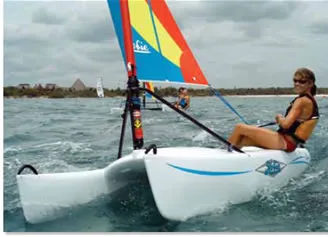
Photo courtesy of Hobie Cat Co.
Eastport Pram
Chesapeake Light Craft expedites boatbuilding for do-it-yourselfers looking to take their garage-built boats for a sail. The company pre-cuts parts, packs kits with all the materials, epoxy, and paint youll need, and leads homebuilders through a thoroughly detailed stitch-and-glue approach to assembly. Kits are available in various stages of completeness, ranging from plans only to the full package, including sail, hardware, running rigging, and paint.
The Eastport Pram is just shy of 8 feet, and the marine plywood and epoxy construction delivers a boat that weighs in, sans sailing rig, at just 62 pounds. Lighter than the comparatively sized Bug, this stiff, durable dinghy, rows like a real boat and sails comfortably with one or two aboard. In keeping with other good tender attributes, the Pram behaves under tow and is equally amicable when propelled by a small outboard or tacked up an estuary under sail.
Kit boatbuilding continues to have a niche following. Theres also an added-value feature worth noting: On one hand, the builder receives a box of pieces and the result of his or her endeavor leads to an aesthetic and utilitarian dinghy. In addition, the DIY skills the builder develops will be useful in other epoxy bonding, brightwork, or mono-urethane application projects. Such talents will benefit many other boat maintenance endeavors.
Whats hard to quantify is the sense of accomplishment derived from sailing a boat that you have built yourself. When the project is tackled in tandem with a child, spouse, or friend, the memories and the boat will last.
Bottom line: With neither sidedecks or a sealed hull, this is not a boat thats easy to recover from a capsize. So once the kids favor on-the-edge sailing in a building breeze, a non swamping, easier-righting boat is probably a better option. The Pram can then be put to use by their appreciative parents or grandparents.
Never in their wildest dreams did Bruce Kirby and Ian Bruce imagine that the Weekender (the Lasers original name) was destined to become an Olympic class sailboat and one of the most popular springboards for top-tier sailors in the world today. Originally envisioned as a car-topper for weekend campers, the cat-rigged, low freeboard sailing dinghy morphed from its original roots into a boat favored by college competitors and revered by generations of agile sailors of all ages. Even frostbiting winter sailors have locked onto the Laser.
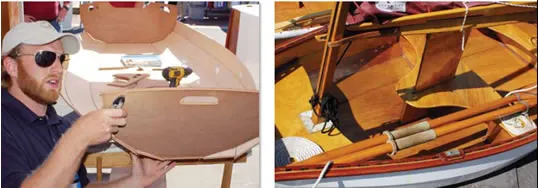
Designed in 1969, the Lasers first few years were anything but smooth sailing. Popularity grew quickly, but along with the limelight came plenty of consternation. Dubbed a surfboard not a sailboat by a growing cross-section of the yachting elite-many parents warned junior sailors to steer as clear of Lasers as they did sex, drugs and rock-n-roll. The campaign failed, and junior sailors in yacht club programs around the country fell into the grip of the new one-design dinghy-discovering the sailboats proclivity to plane.
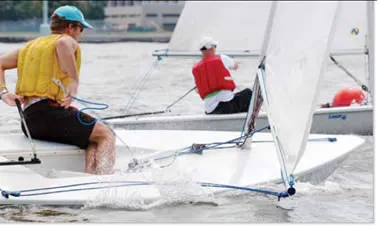
Dyer Dhows languished in boat sheds across the country as a new theme in sailing took hold. Dubbed fast is fun by sailor/engineer Bill Lee, the young Merlin of Santa Cruz, Calif., took the theme to big-boat sailing, merging California culture with the Laser logic of light displacement and planing hull shapes.
Best of all, the Laser embraced the ideal of a tightly controlled one-design class that put people on the water in identical boats and left winning and losing races up to sailing skill and tactics rather than a boats performance edge. For decades, the boat has been the single-handed sailors choice among junior sailing programs, and with the addition of the Radial, 4.7 and M rigs, smaller competitors have also found the boat to be a great sailing platform. Today, theres some lawyer saber-rattling over the sale of the design rights, but the boat remains more popular than ever.
The sleeved sail, two-part spar, daggerboard, and kick-up rudder make the boat a quick-to-rig and fast-to-get underway dinghy. Light-air efficiency is good for a one-design sailboat, but this means that as the breeze builds, the non-reefable sail can become a handful in a hurry. In fact, the boats Dr. Jekyll-and-Mr. Hyde demeanor is what builds talent among Laser practitioners. The big boys block the mainsail and blast off for the layline, while lighter sailors heavy-weather tactics include more nuanced de-powering and feathering. In light air, the tables turn, and the winner is often the sailor who planes quickest on the reaches. The old guards surfboard slam may have held some credence after all.
Bottom line: The Laser is a timeless classic thats easily transported and is built for performance. Its well suited to adrenaline-seeking teens as well as the more fit adult crowd.
Designed in 1947 by Floridian Clark Mills, the utilitarian Optimist could be made out of two sheets of plywood-and from its inception, the Optimist was meant to link kids with the water. Slipping into obscurity in the U.S., the little pram found fertile ground to grow in northern Europe. With just a few tweaks, the Scandinavians took Millss lines and parlayed them into whats become the favored junior sailing trainer for kids from Detroit to Timbuktu. Statistics show that there are about 30 builders worldwide putting out approximately 4,000 boats each year. With about 130,000 boats class registered and an estimated 300,000 total hulls built (amateur and pro), theres plenty of reasons to get excited about an Opti.
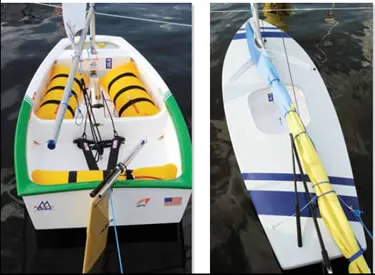
The example weve chosen is the USA-built McLaughlin boat, both a demonstration of high-quality FRP construction and modern manufacturing techniques. Its also a boat that can be purchased in a range of performance-inducing iterations-upgrades designated as club, intermediate, advanced, and professional versions. Like all performance sailboats, stiffness and strength-to-weight ratio is important. But class rules include a minimum weight, so the most competitive hulls meet the mandatory lower limit but use good engineering and building technique to reinforce the daggerboard slot and mast step and produce overall stiffness.
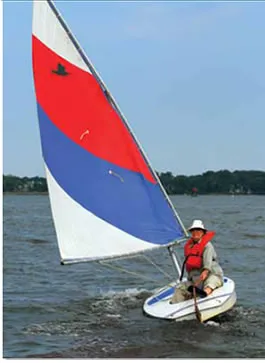
The low mast height and high aspect ratio sprit sail is very versatile, affording young (and small, 65 to 130 pounds) sailors a wide window of decent performance. The flat bottom, slab-sided hull is responsive to crew weight-driven trim changes, and the better the sailor, the more agile they become. Light-air performance is all about minimizing wetted surface and maximizing sail area projection. When the breeze starts to kick up, the sailor becomes the ballast, and the art of hiking, sheet handling, and tiller wiggling come into play.
Under careful adult supervision, two 6- to 8-year-olds can double-hand the friendly little dinghy, or one more-confident child can solo sail it. In fact, introducing kids to sailing with similar proportioned small prams has been a right of passage around for decades. A set of oarlock gudgeons can turn the pram into a functional dinghy thats also adaptable to the smaller Torqeedo outboard (www.torqeedo.com).
McLaughlin also markets a Roto-molded polyethylene version of the Opti and sells DIY kits for those who want to create their own wood version.
Bottom line: The Opti is like a first bicycle without the need for training wheels. The fact that at the last Olympics, over 80 percent of the winning sailors had gotten their start in an Optimist speaks well to the value of messing around in this particular dinghy.

Designed in 1951 by ice boaters Alexander Bryan and Cortland Heyniger, the hard chine Sunfish was the prototype board boat. In 1959, it made the transition into fiberglass, and over the following half-century, more than a quarter-million hulls would hit the water. Simplicity and decent sailing attributes combined with an attractive price to make the Sunfish the most popular one-design dinghy ever raced.
Far more than a platform for racers, these boats are an excellent training tool for sailors of all ages. Also built by Laser Performance, they reflect the fun of summer and put sailors in close contact with the water on which they sail. Its no surprise that the larger fleets coincide with warm water and many see going for a swim to be part and parcel of the low-freeboard experience.
The lateen rig is in keeping with the overall design concept and simplifies rigging. A short stub of a mast is stepped and a single halyard hoists the sail along with tilting V-shaped upper and lower booms.
The total sail area is nearly the same as the Laser, but the halyard hoist versatility of the lateen rig make it a handy beach boat and a little less daunting when the wind begins to build. The clean sail shape on one tack and deformation caused by the mast on the other tack are a slight drawback. The Laser rig is more efficient, but when caught out in a squall, its nice to be able to ease the halyard and dump the sail. Its also handy to be able to leave the boat tethered to a mooring, and the doused sail and short mast make it possible.
Multiple generations of sailors are often found sailing Sunfish, and the boat represents one of the best bargains to be found in the used boat market. When considering a pre owned boat, the potential buyer needs to take a close look at the daggerboard-to-hull junction and mast step, points where previous damage can create hard-to-fix leaks.
Bottom line: The Sunfish is a great beach boat that can turn a hot afternoon into a fun-filled water experience.
There were no losers in this group, and picking winners and runners-up proved a difficult task. The outcome had to be based on assumptions about how these boats would be used. For example, parents with a competitive 9-year-old who swims like a fish, always sprints for the head of the lunch line, and likes to steal bases in Little League probably have an Opti racer in the making. Less competitive junior sailors-future cruisers in the making-will do better learning aboard a Bug. Many newly formed sailing clubs target the boat as their trainer of choice.
The Bravo holds plenty of appeal for those with a lakeside cottage or a favored campground destination. Whether its a solo sail just before sunset or a fun race on Sunday, the quick to set up and put away features are a plus, and for those who feel that two hulls are better-the Bravo will hold plenty of appeal.
Serious competitors can campaign a Laser for life, and whether youre headed for a local district regatta or getting ready for the Olympic trials, the hull, rig, and sail remains identical-sort of like the Monaco Grand Prix being raced in a street legal Mustang.
Bic Opens new little speedster tickled our fancy, and as a trainer/performance boat crossover, it drew a strong nod of approval. Watching the junior sailors smiles as they sailed their Open Bics endorsed our opinion.
And if there is any boat that defines the essence of summer, the Sunfish takes the prize.
- The Art of Building with Thermal-setting Plastics
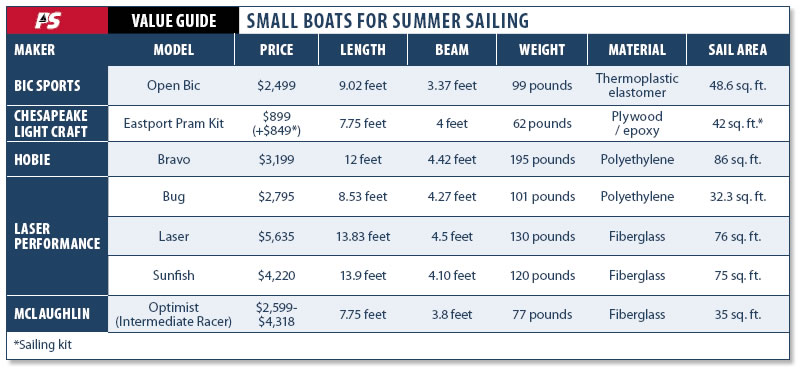
- Youth Safety Gear Top Picks
- Chesapeake Light Craft
- Hobie Cat Co.
- Las er Performance
- McLaughlin Boat Works
RELATED ARTICLES MORE FROM AUTHOR
Leave a reply cancel reply.
Log in to leave a comment
Latest Videos
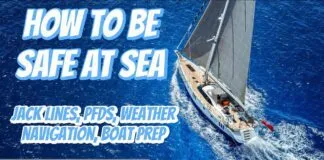
Safety At Sea For You & Your Family – The Joe...

What’s The Best Vinyl Window Cleaner for Your Boat?

40-Footer Boat Tours – With Some Big Surprises! | Boat Tour

Electrical Do’s and Don’ts
- Privacy Policy
- Do Not Sell My Personal Information
- Online Account Activation
- Privacy Manager
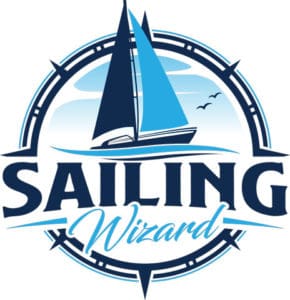
What is The Best Sailing Dinghy for Cruising?
Whether you are a seasoned sailor or completely new to sailing, choosing the right dinghy for your escapades is crucially important. If you begin to look at all of the available sailing dinghies on the market, you will likely be overwhelmed with all the options and unsure which one is truly the best. Let’s take an in-depth look and answer the question: What is the best sailing dinghy for cruising?
One of the best sailing dinghies for both beginners and experts alike, the Wayfarer is perfect for day cruising and multi-day adventures. Wayfarers are also versatile due to their streamlined and stable design. There are also other great options, including Gull and Enterprise dinghies.
In the next few sections, I’ll take a look at some of the most popular and best sailing dinghies so that you can get an idea of what is out there. Let’s get right into it!
Looking for a Sailing Dinghy for Cruising?
If you are looking to purchase a dinghy, there are a lot of options available to you. A few dinghies rise above the rest in terms of maneuverability, quality, design, functionality, and a thousand other factors; however, it is nearly impossible to pick out a single dinghy as the best due to the varying opinions and needs of individual people.
So, while there isn’t a single “best” dinghy that I can recommend to everyone, the ones listed below are absolutely amazing and will work for various crew sizes, needs, and situations.
Now, let’s take a closer look at these five great sailing dinghies and address each one’s pros and cons.
Wayfarer Sailing Dinghy
The Wayfarer is a widely loved dinghy that has quite a reputation as a good and reliable boat. There are many different versions of the Wayfarer, with slight adjustments and design changes throughout the years. While all of the Wayfarers are considered excellent boats, ones closer to the original Mark I design are ideal for sailing due to their extra storage capacity and added stability.
Pros of Cruising in a Wayfarer Sailing Dinghy
Wayfarers are overall great dinghies for a variety of situations and people. They are incredibly versatile, maneuverable, and very enjoyable to sail.
Whether you are entirely new to sailing and just looking into getting your first dinghy, or you have been around the block a few times, a Wayfarer is an excellent choice for many people. Due to its extreme versatility, you can take your Wayfarer out on both day trips and multi-day excursions, and they are even great racing dinghies as well!
Cons of Cruising in a Wayfarer Sailing Dinghy
When considering the cons of owning a Wayfarer, they are relatively few and far between. One thing to keep in mind is you will usually want a crew of at least two people to sail a Wayfarer. Unless you are very competent and know how to sail solo well, a Wayfarer will most likely be too large and heavy to sail and beach if you are alone.
It is also important to note that the newer versions of the Wayfarer are more prone to turtling while sailing than earlier models. If you are just getting into sailing, I would highly suggest that you get a Wayfarer similar to the Mark 1 designed by Ian Proctor.
Gull Sailing Dinghy
First designed by Ian Proctor in 1956, the Gull is a reliable and versatile dinghy that is well-loved by many people. The first iteration of the Gull was made of plywood, as most boats of the time were, and since then has gone through many more versions and is now made of GRP (Glass Reinforced Plastic).
Pros of Cruising in a Gull Sailing Dinghy
Much like the Wayfarer mentioned above, the Gull is a very versatile and excellent dinghy. While the Gull makes a fantastic sailing dinghy, it is a versatile craft that you can fit with an outboard engine or rowlocks for alternate propelling methods.
Another significant aspect of the Gull is its sleek and small design. While you lose some onboard space, the Gull’s smaller hull allows this two-person dinghy to be easily sailed solo if you have a little experience and wish to do so. Overall, the Gull is a very sturdy and reliable dinghy bound to meet all of most sailors’ needs.
Cons of Cruising in a Gull Sailing Dinghy
Gulls are very sturdy dinghies that don’t have too many downsides to them. The only real offputting aspect of the Gull for many sailors is its small size that sometimes doesn’t have as much room as you might like on a multi-day excursion on a dinghy.
The Gull has a pretty small hull, which gives it a lot of maneuverability, but it also results in less space for yourself, crew, passengers, and supplies. The lack of space on the Gull isn’t too big of an issue if you pack lightly, go on excursions that last a few days at a maximum, and have minimal people on board.
Enterprise Sailing Dinghy
Designed in 1956 by Jack Holt, the Enterprise is one of the oldest dinghy classes, yet remains wildly popular to this day due to its appealing design and beginner-friendly handling. Enterprise dinghies are extremely popular and versatile worldwide, being used for sailing, racing, and nearly everything in between.
Pros of Cruising in an Enterprise Sailing Dinghy
The Enterprise is seemingly the perfect blend of size, design, power, and weight. This near-perfect combination of elements has been the primary thing that has made this dinghy class have such a strong following and be so popular for many decades.
While it may take some adjustments and time, Enterprise dinghies are also relatively easy to sail singlehandedly, even though they are meant to be sailed two-up. Overall, Enterprise dinghies are excellent and reliable boats that are great for sailing adventures, whether you have a friend with you or not.
Cons of Cruising in an Enterprise Sailing Dinghy
Enterprise dinghies are considered one of the best options out of the vast array of sailing dinghies out there. However, there is one major thing that can be quite offputting to many sailors about them.
This one flaw of Enterprise dinghies is their stability.
While it isn’t too much for an experienced sailor to handle, Enterprise dinghies do have a noticeable lack of stability when out on the water when compared to similar sailboats. By no means is this a fatal flaw of the design, but rather a characteristic unfamiliar to this type of dingy and usually seen on dinghies meant for racing.
Wanderer Sailing Dinghy
Another design by Ian Proctor that has made this list, the Wanderer is a very light and agile dinghy that is quite popular among new and experienced sailors alike. The Wanderer began as a lighter version of the previously mentioned Wayfarer, but its design has diverged quite a bit and has become unique in its own right since then.
Pros of Cruising in an Wanderer Sailing Dinghy
One of the Wanderer’s greatest strengths is its weight. It is actually relatively light, with a hull weight of 291 pounds, making it pretty easy to launch and maneuver. Additionally, the Wanderer’s weight, or lack thereof, does not significantly impact its stability because it is quite a stable boat that is not prone to turtling.
Overall, the Wanderer is a top-rated and fabulous boat that, while on the lighter side of things, is very stable and reliable.
Cons of Cruising in an Wanderer Sailing Dinghy
While the Wanderer is a great boat for sailing, a potential downside to this dinghy is the need to have multiple crew onboard. While sailing a Wanderer can undoubtedly be done solo, for most sailors, having some extra hands on deck will make sailing the 2-3 person Wanderer dinghy much more pleasant.
Of course, there is absolutely nothing wrong with having a multi-person sailing dinghy – for many it’s the perfect choice – but it does eliminate the possibility of solo sailing, which can be quite relaxing and fun once you are competent and experienced.
James Gerard
Hi, I'm James! I started sailing at a very early age here in the UK, and have enjoyed so many opportunities to sail all over the world. I created this website to share the many sailing tips I've leaned over the years, so that you can also discover the joy of sailing with safety and confidence.
Recent Posts
How to Predict Wind Direction & Speed from a Surface Pressure Chart
Learning how to read a surface pressure chart will allow you to predict the wind speed and direction based on the weather chart. This will help you in planning your next sailing trip.
What Does a Black & Yellow Buoy Mean? (Cardinal Marks Explained)
If you see a black and yellow buoy while you're sailing, don't ignore it. Cardinal Marks are there to help you avoid hidden hazards in the water. This helpful article will help you to identify a...
Yachting World
- Digital Edition

Best sailing tender: get a buzz from your boat or boot
- Toby Hodges
- July 13, 2022
Want some easy, fun sailing this summer? launched from your yacht or car, the latest sailing tender ideas give that instant sailing buzz. Toby Hodges and Sam Fortescue report

While we all crave as much helming pleasure as possible from our cruising yachts, the reality is that after making realistic space, volume and budget compromises, they may not always be that exhilarating on the helm. But once you reach a destination or anchorage, what’s to stop you, your friends or kids getting your hands-on tiller-sailing fix if you can stow the right sailing tender aboard?
You could argue that the development of lightweight, modular or inflatable dinghies in recent years has solved a headache for some yacht owners – now they can go for extra volume, or switch to a multihull perhaps, safe in the knowledge they can get the spray-in-the-face dinghy experience from a tender or toy once anchored.
Stowage space, whether on deck, on davits or in a locker, governs what options are available. In the past the choice has fallen into three categories: a rowing dinghy you can sail, a nesting dinghy, or a sailing inflatable (such as the Tinker Tramp). And while these categories haven’t necessarily changed, the design and technology lately has made the products immeasurably more appealing!
The ability to stow a quick-to-rig toy in the boot or on the roof of the car, has also unlocked the potential to explore a multitude of different sailing waters easily. These designs have brought to sailing what inflatable paddleboards have brought to watersports.
Best sailing tender

For cruising sailors, this could be an ideal solution: a stable, lightweight tender that will sail well too
OC Sailing Tender
This has been at the top of my wishlist for tenders for some time, but now the family-run New Zealand company has come out with a rig for this lightweight composite boat that has just doubled the appeal.
OC Tenders was developed by experienced cruising sailors who were after a dry, stable, maintenance-free tender which is light enough to pull up a beach. A wide hull shape with plumb bow and flat run provides stability and volume and early planing ability, while foam sandwich construction makes it solid (puncture free) and light enough to carry. These also happen to be key elements for many modern performance sailing dinghy designs.
OC Tenders is unveiling a new Sailing Tender version this year, a kit which transforms two of its existing tenders into sailing dinghies. The main difference is a centreboard case which attaches to the thwart with a mast step below, neither of which can be removed, but only add 6kg weight. The rest of the sailing components are stored in bags which fit inside the tender, including a 6m mast in two sections, boom (both in 30% carbon), centreboard, rudder, hiking straps and 7.5m2 sail.
OC has a video of the tender surfing along and another of how easy it is to right it if you capsize. The boats weighs 68kg for the 3.3m or 74kg for the 3.5m, while the sailing components add just 15kg. Both are also available in carbon versions (a NZ$4,000 upgrade). The slight catch may be the cost, and that it’s a small company with low production run and high demand.
Price: OC330 from NZ$23,500 (circa £12,000).
Buy it now from octenders

Reverso Air is quick to get on the plane. Photo: Armand Dayde
Reverso Air
It may be a nesting dinghy, but there’s nothing clinker-built about the Reverso Air. From the outset, the team behind this pocket beast of a boat were focused on performance, and that is what you get in spades. It has been clocked at 16 knots and readily takes to the plane, surfing down anything from harbour chop to long swell.
Reverso is built in Brittany using advanced composite construction. The 3.40m hull is infused in honeycomb sandwich, for stiffness and light weight, and carbon reinforcing is added where the loads are greatest, such as the mast step. The mast itself is a tube of high-modulus carbon fibre weighing just under 3kg, and the sail is 7m2 of high-tech membrane from Incidence.
Part of the stellar performance comes from the hull shape, designed by Charles Bertrand. A broad beam, flat bottom and deep chines provide stability for sailing with kids and a great platform for planing when a gust blows. “It is the lightness of the boat which makes it fast and efficient, allowing it to accelerate quickly,” says founder Antoine Simon. “Also, the quality of the materials, which give a dynamic response and transmit the forces, especially with the rigid hull.”
The boat is designed to take two grown-ups or an adult and two kids, so you can refine your technique in company if you like. Simon says this makes the boat ideal for teaching kids or going out for a solo burn.
Assembly is pretty simple and can take less than two minutes. The hull is composed of four parts, the heaviest of which weighs 16.8kg. The sections clip together along the coaming using stainless-steel levers. Then you add tension along the bottom of the boat using two Dyneema lines with a 1:14 cascade that puts on 600kg of compression.
When disassembled, the parts nest inside each other, fitting readily into the boot of a family car or an SUV. Measuring 1.45m x 0.92m x 0.72m, the folded boat is also designed for easy fixing to a trailer or towing-ball platform behind a car.
Accessories that improve the storage and use of the boat include a bag, (€490); smaller padded bags for the four mast sections, centreboard, tiller and rudder; a mounting mat to protect the boat on rough surfaces (€170); and a folding beach trolley (€490). And there’s a GPS speedometer (€499), specially designed for mounting at the base of the mast.
Price: Reverso Air €8,913 plus €1,090 shipping.
Buy it now from Sailreverso

You don’t have to be a pro to get the AST Foiler skimming the waves. Photo: Sören Hese
Foiling is no longer limited to pros and daredevils. AST’s beautifully designed foiling dinghy makes it possible for almost anyone to experience the exhilaration of flying on water. With a top speed of 25 knots-plus and a really simple control system, it is easy to get airborne.
The key is the mechanical foiling system, which requires no trimming. A foil on each side of the 3.85m hull resembles nothing more than a giant spider’s leg, or a wonky ‘7’. The foils are loose-mounted in such a way that they can cant slightly according to the tack you’re on. When the boat goes about, the leeward foil rises and the new windward foil drops. It requires no electronics or hydraulics – just a bit of elementary physics.
You control the boat using a T-shaped rudder whose foil supports the boat aft and helps keep you balanced while foiling. With foils deployed, the effective beam jumps from 1.58m to 2.10m and the draught from 15cm to 1.10m, giving the boat excellent stability.
AST says the hull will fly from 8 knots of true wind, thanks in part to the lightweight layup, with an overall weight of 55kg. The foils, rudder and mast are all in carbon fibre, while the hull is in a lightweight foam-epoxy sandwich.
With a cool reverse bow, open transom and hiking wings, this boat looks the business. It can support up to 95kg of crew weight, so could in theory take two children. But this is really a solo sailer, designed for thrills and spills. AST offers two different sails, 7.5m2 or 9.5m2.
The foils can be folded flush to the hull for transport., there’s a custom-made aluminium trolley for launching and towing; padded covers for the foils and rudder (€269); and a Velocitek SpeedPuck to measure your speed (€399).
This is not a cheap option… but it is a fun one.
AST also does a non-foiling L12 Lowrider – a 3.82m planing performance dinghy, which weighs just 30kg.
Prices: AST Folier €15,631 inc VAT, L12 Lowrider €8,824 ex VAT.
Buy it now from Ast-yachts

IZIBoat is easy to transport and can be assembled in 15 minutes
IZIBoat germinated from a desire to make sailing easy, fun and accessible to all, by creating a catamaran that is ultra fast to assemble (less than 15 minutes). No tools are needed thanks to a neat plug, lock and tension system. While speeds of 14+ knots are reportedly achievable, it is more aimed at accessible sailing, regardless of age or ability. So it can seat four and is intuitive for new sailors thanks to joystick steering – just tilt the stick the way you want to turn.
The brainchild of François Tissier, who dreamed of a dinghy with ease and stability while living in the South Pacific, it took many years of R&D and 11 prototypes. The beach cat measures 500x62cm, so can easily be stored in a garage and its five components weigh 152kg, so it can be transported on the roof of a car or even towed by a bike or e-bike.
Price: from €8,990.
Buy it now from Iziboat

LiteboatXP 16 can be rowed or sailed – fast
LiteboatXP 16
This is a fun sailing boat that you can row properly for recreation too. The first Liteboat XP was a 20ft model which we tested four years ago and were so impressed with the sailing ability, we jointly gave it a European Yacht of the Year award. It’s also excellent for rowing enthusiasts. For those still sceptical, consider that it’s drawn by in-demand IMOCA designer Sam Manuard.
The new 5m/16ft model is more compact and lighter still (100kg). There’s no cuddy, but it still sports a sliding rowing seat, carbon oars and outriggers and a catboat-style rig with two part carbon mast and a 7.5m2 boom-less sail. But it’s when reaching with the 6m2 gennaker that you’ll really get the buzz. It converts from sailing to rowing mode in under a minute. It’s an efficient explorer that’s blast to sail, will keep you fit and avoids the need for a smelly, noisy outboard.
Price: from €14,500.
Buy it now from Liteboat
Best inflatable sailing tender

The black and yellow Tiwal rocket is designed in Brittany. Photo: Christiane le Port
The original Tiwal 3 is already marking its 10th anniversary, the design having been at the forefront of using drop stitch technology to create a really stiff inflatable. Now the boat has been turbo-charged, tweaked and improved. The result is the Tiwal 3R, with a top speed of 14 knots and a helming position just millimetres off the water.
It comes deflated in two bags weighing around 30kg each (plus a smaller sail bag), and comprises a concave inflatable hull and anodised aluminium ‘exoskeleton’, which transmits the forces from the mast, rudder and daggerboard. It also provides two raised hiking ‘wings’ which allow you to balance the 6m2 or 7m2 sail, tailor-made by North Sails in Xi V2 racing laminate.
The 3R’s performance boost stems from a number of small steps. For instance, the hiking bars have been extended aft so that you can shift weight back when the wind picks up. The aluminium frame is stronger and stiffer for better power transfer, and the hull is a more efficient shape, courtesy of the rail on the stern. The mast and boom are now 90% carbon for lighter weight.
Assembly takes 25 minutes – a little longer than the original Tiwals, because of the additional elements of the frame and control lines, according to founder Emmanuel Bertrand. Experience says there is a bit of fiddly slotting of aluminium tubes together, which can be trickier if sand gets into the joint. The boat is rated for crew up to 200kg, which allows for two adults or one grown-up and two children. Really, though, you want to be sailing this alone at top speed. And with a choice of two sails, you can go out in pretty much any conditions.
Price: from £8,140.
Buy it now from Tiwal
Dutch brand DinghyGo has built a reputation for the reliability of its growing range of sailing inflatables.
They are not performance oriented, but are easy to assemble, have bags of buoyancy and can be stored in two mid-sized bags. The range starts at 2.30m LOA, but the flagship Orca 375 is the latest release, with a 4.8m2 mainsail and a 1.1m2 jib.
The four-piece mast requires three soft stays to keep it aloft, while the foot is anchored through a thwart. With 650kg of payload capacity, you can bring three adults and a heap of camping gear with you.
Price: £4,000.
Buy it now from Dinghygo
Minicat Guppy
The Czech sailor behind the MiniCat brand teamed up with round-the-world sailor Laura Dekker to launch the Guppy.
At 3.00m LOA, it is the smallest boat in the Minicat range, with a capacity for two, but weighs a staggeringly small 26kg itself.
Perched on two big 33cm floats, just a small aluminium frame does the job of supporting the mast and the trampoline. The mast and its 3.9m2 sail is stayed to a short bowsprit, and the whole takes just 15 minutes to put together. Stub keel fins help reduce leeway.
Its light weight makes it eminently portable and easy to stow.
Price: €2,665 ex-VAT.
Buy it now from Minicatamaran
Inflatable Wingfoil
Granted, it can look a bit daft watching middle-aged folk pumping and flapping away while trying to get a giant inflatable wing to lift their mass onto a skinny foil. But once you’ve experienced that feeling of pure flight, silently skimming over the surface, there’s no going back.
Whether for surfing, windsurfing, or even kiting, any solid boards take up valuable locker space. All of which arguably makes an inflatable foil board and an inflatable wing the ultimate in compact sailing fun.
The foils typically disconnect from their masts and pack in protective bags. The inflatable boards can also be used to wingsurf or paddle on in displacement mode. Or try towing one behind a tender – with a foil you only need very small speeds (around 6 knots) and, with practice, you can be surfing a wee wake.
The smaller volume boards better suit surf and wingfoil use and the larger boards are for wing and SUP enthusiasts.
F-One’s Rocket Air is designed around its rigid boards, and range from 75lt (4ft 11in) to 185lt (7ft 11in) and prices from £625-£825.
Buy it now from f-one.world
Naish, meanwhile, has models of its new Hover board from 80-170lt, which have composite carbon plates on the bottom for the foil join for a stiff ride.
Buy it now from Naishfoils
If you enjoyed this….
Yachting World is the world’s leading magazine for bluewater cruisers and offshore sailors. Every month we have inspirational adventures and practical features to help you realise your sailing dreams. Build your knowledge with a subscription delivered to your door. See our latest offers and save at least 30% off the cover price.

Learn the Basics of Dinghy Sailing: A Beginner’s Guide
Alex Morgan
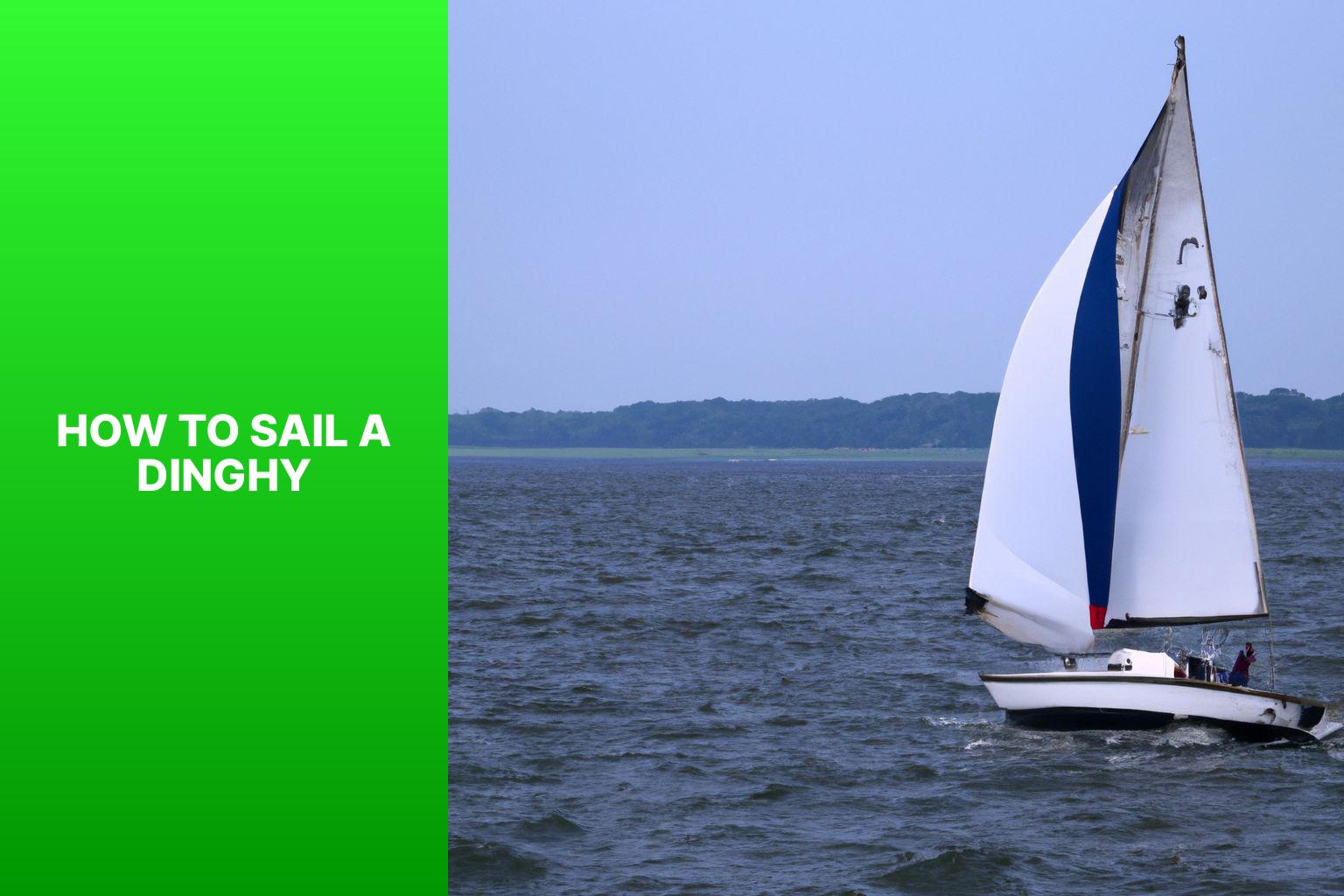
Sailing a dinghy can be an adventurous and rewarding experience, allowing you to navigate the water and harness the power of the wind. Whether you’re a beginner or looking to improve your sailing skills, understanding the fundamentals of sailing a dinghy is essential. In this guide, we will delve into the different aspects of sailing a dinghy to help you get started and sail with confidence.
Sailing dinghies are small sailboats that are designed to be sailed by one or two people. They are versatile and can be used for leisure sailing, racing, or even as a training vessel. Dinghies come in a variety of shapes and sizes, each with its own unique characteristics and sailing capabilities.
Before setting sail, it’s important to choose the right dinghy that matches your skill level, sailing goals, and local weather conditions. Factors to consider include the type of dinghy, hull design, size, and rigging options.
To ensure a safe and enjoyable sailing experience, it’s crucial to have the right equipment on board. This includes sailing gear such as life jackets, wetsuits, and appropriate footwear, as well as safety equipment like a whistle, signaling devices, and a first aid kit.
To effectively sail a dinghy, it’s important to familiarize yourself with its various components. These include the hull, rigging and sails, centerboard or daggerboard, and tiller and rudder. Understanding how these parts work together will help you maneuver the dinghy more efficiently.
Mastering basic sailing techniques is essential for any aspiring dinghy sailor. This involves understanding wind and weather conditions, launching and landing the dinghy, steering and maneuvering, and becoming familiar with different points of sail.
Once you have a solid foundation in basic sailing, you can explore more advanced techniques. These include tacking and gybing, sailing upwind, using sail controls to optimize performance, and adjusting your technique according to different wind conditions.
Safety should always be a top priority while sailing a dinghy. We’ll cover basic safety rules, collision avoidance, right of way rules, and how to respect the environment while out on the water.
Sailing a dinghy is a skill that can be continually improved upon with practice and experience. As you gain more confidence, consider taking lessons, joining a sailing club, or participating in races to further enhance your skills and enjoyment of this exhilarating sport.
Key takeaway:
- Choosing the right dinghy is crucial: Consider factors such as size, stability, and intended use when selecting a dinghy for sailing.
- Master the basic sailing techniques: Understanding wind, launching and landing the dinghy, steering and maneuvering, and knowing the points of sail are essential for successful dinghy sailing.
- Prioritize safety and etiquette: Follow basic safety rules, learn collision avoidance and right of way rules, and respect the environment while sailing a dinghy.
Choosing the Right Dinghy
When it comes to choosing the right dinghy , there are crucial factors to consider. From the size and weight to the sailing conditions you’ll be facing, this section dives into the key elements that will help you make an informed decision. So, before you set sail, let’s explore the essential aspects that can make or break your dinghy sailing experience. Get ready to navigate the waters in style and with confidence!
Factors to Consider
When choosing a dinghy for sailing, there are several factors to consider. You should think about the size and weight of the dinghy. A smaller, lighter dinghy is easier to maneuver and launch, which makes it perfect for beginners or sailors who will be sailing solo.
It’s important to assess your skill level as a sailor. If you are a beginner, you should opt for a dinghy that is stable and forgiving . On the other hand, more experienced sailors may prefer a high-performance dinghy that offers a thrilling sailing experience.
Next, consider the intended use of the dinghy. Will you be using it for racing or cruising? It’s crucial to choose a dinghy that is specifically designed for your intended purpose.
Of course, cost is another important factor to take into account. Dinghies come in a range of prices, so you should choose one that fits within your budget. Remember to factor in the cost of any additional equipment and maintenance.
Another consideration is the availability of spare parts and accessories for the dinghy. It’s advisable to choose a reputable manufacturer that offers a wide range of support and resources.
Think about where and how you will store and transport the dinghy. Assess whether you have enough space at home or if you will need to rely on a boatyard or marina for storage.
A pro tip is to try out different dinghies before making a final decision. This hands-on experience will help you determine which dinghy feels the most comfortable and suits your sailing style.
Essential Equipment for Dinghy Sailing
When it comes to sailing a dinghy, having the right equipment is essential . In this section, we’ll explore the must-have gear for an enjoyable and safe sailing experience. From top-of-the-line sailing gear to crucial safety equipment, we’ll cover everything you need to know to be fully prepared on the water. So, get ready to gear up and sail with confidence in your trusty dinghy !
Sailing Gear
When it comes to sailing gear, every sailor should have these essential items:
Having the right sailing gear is essential for comfort, safety, and enjoyment while on the water. Invest in quality gear and always check its condition before setting sail.
Safety Equipment
When sailing, prioritize safety. Here are essential safety equipment items to consider for dinghy sailing:
- Life Jacket: All sailors must have a properly fitting and Coast Guard-approved life jacket. Wear it at all times while on the water.
- Personal Flotation Device (PFD): Similar to a life jacket, a PFD provides extra buoyancy and is a lightweight option.
- Whistle or Horn: Use these signaling devices for emergencies or to communicate with others on the water.
- Throwable Flotation Device: A buoyant object thrown to someone in distress to assist with their flotation until help arrives.
- First Aid Kit: Keep a well-stocked first aid kit onboard for injuries or medical emergencies while sailing.
- Anchor: Essential for stopping the boat’s drift in case of engine failure or strong currents.
- Fire Extinguisher: Have a fire extinguisher onboard to handle potential fires caused by fuel or electrical problems.
Remember, safety equipment is effective with proper use and regular maintenance. Regularly inspect and replace damaged or expired safety equipment. Familiarize yourself with each item’s use and ensure everyone onboard knows the location and operation of the safety equipment.
Understanding the Parts of a Dinghy
Get ready to set sail as we dive into understanding the different parts of a dinghy. We’ll be exploring the hull , rigging and sails , centreboard or daggerboard , and the tiller and rudder . Each sub-section sheds light on a crucial component of a dinghy, taking you one step closer to mastering the art of sailing. So grab your life jacket and join us on this nautical adventure!
The hull, an integral part of a sailing dinghy, provides both buoyancy and stability . Constructed from materials such as fiberglass , its purpose is to withstand the forces of wind and water.
The performance of a dinghy is greatly influenced by the shape of its hull. For novices or when sailing in calm waters, a flat-bottomed hull offers exceptional stability. Conversely, a V-shaped hull is more adept at slicing through waves, enhancing speed and maneuverability.
To facilitate orientation and communication, a dinghy’s hull is divided into distinct sections: the bow (front), stern (rear), port (left), and starboard (right). These sections help sailors easily identify different areas of the boat and provide precise instructions.
Maintaining the hull’s condition necessitates regular cleaning and inspection. This practice ensures the early detection of any cracks or damage that may compromise the hull’s integrity. Proper storage and transportation are equally vital to prevent unnecessary stress or wear.
When selecting a dinghy, it is crucial to consider both the hull design and the appropriate material that aligns with your specific needs. Whether your purpose is leisurely sailing or competitive racing, seeking guidance from experts or experienced sailors can aid you in making the right hull choice.
Rigging and Sails
The rigging and sails on a dinghy are crucial for supporting and controlling the sails.
The mast , boom , and standing rigging all play a part in this process.
The mast , which is a tall pole, holds up the sails and can be securely attached to the hull of the dinghy.
The boom , on the other hand, is a horizontal pole that extends from the mast and holds the foot of the mainsail.
The standing rigging consists of wires or cables that provide support to the mast and keep it upright.
This includes the forestay , backstay , and shrouds .
The forestay helps in supporting the mast and controlling its movement, while the backstay provides additional support and stability.
The shrouds prevent the mast from leaning too much to one side.
One particular day, John found himself sailing in his dinghy when he suddenly encountered a fierce storm.
The powerful wind and massive waves made it incredibly challenging to control the sails.
It was in this difficult situation that John truly recognized the significance of well-rigged sails.
The proper tension and positioning of the rigging allowed him to swiftly adjust the sails, enabling him to navigate through the turbulent waters.
Thanks to the robust rigging and well-maintained sails, John safely guided his dinghy back to shore.
This experience served as a constant reminder of the crucial role that rigging and sails play in enhancing the performance and safety of a dinghy.
Centreboard or Daggerboard
The centreboard or daggerboard is an essential component of a dinghy, and it plays a crucial role in enhancing its sailing performance. Understanding its significance and how to utilize it effectively can greatly enhance your sailing skills and maneuverability. Here are some key points to consider about the centreboard or daggerboard:
– The centreboard or daggerboard is positioned in the center of the hull and functions as a retractable fin-like structure.
– Its primary function is to prevent the boat from drifting sideways while sailing upwind.
– Depending on the wind conditions and sailing direction, the centreboard or daggerboard can be raised or lowered accordingly.
– By retracting the centreboard or daggerboard , the dinghy can sail in shallow waters without the risk of grounding.
– The size and shape of the centreboard or daggerboard have a significant impact on the boat’s stability and its ability to point into the wind.
– Smaller dinghies typically have centreboards , while high-performance racing boats commonly use daggerboards .
– When sailing upwind, it is advisable to fully lower the centreboard or daggerboard to maximize resistance and minimize leeway.
– Regularly inspecting the centreboard or daggerboard for any damage or signs of wear is essential, as it may affect the boat’s overall performance.
– Having a proper understanding of how to use and adjust the centreboard or daggerboard will contribute to optimizing your dinghy sailing experience.
Considering these aspects and incorporating the centreboard or daggerboard effectively will ensure that you make the most out of this crucial sailing component.
Tiller and Rudder
The tiller and rudder are necessary parts of a sailing dinghy that assist in steering and maneuvering the boat efficiently.
Both the tiller and rudder collaborate to provide control and stability to the sailing dinghy. They enable the helmsman to navigate the boat smoothly, making precise turns and adjustments based on wind and water conditions.
It’s crucial for the helmsman to understand how the tiller and rudder function and how their movements impact the boat’s direction. Mastery of the tiller and rudder requires practice, as different sailing techniques, like tacking and gybing, demand precise control over these components.
Always maintain a firm grip on the tiller while sailing and remain cautious of any obstacles in the water. Proper utilization of the tiller and rudder ensures a safe and enjoyable sailing experience.
Basic Sailing Techniques
Get ready to set sail! In this section, we’ll dive into the basic sailing techniques that will turn you into a skilled dinghy sailor. From understanding wind and weather conditions to mastering the art of launching and landing the dinghy, we’ll cover it all. Get ready to learn about steering and maneuvering techniques, as well as the crucial concept of points of sail. By the end, you’ll have the knowledge and skills you need to confidently navigate the waters with your dinghy.
Getting Familiar with Wind and Weather Conditions
When getting familiar with wind and weather conditions for dinghy sailing, it is important to consider the following key factors.
You need to determine the wind direction in order to make the right maneuvers and select the appropriate course. Assessing the wind speed, which is measured in knots , is crucial. Light winds typically range between 5-10 knots , while stronger winds can exceed 20 knots .
It is also essential to stay informed about the weather conditions, including any changes in wind speed, gusts, or the possibility of storms. Observing cloud formations can provide valuable indications of approaching storms or strong winds.
It is important to take note of the sea state, as choppy or rough seas require extra caution. Considering the temperature is necessary for both comfort and ensuring appropriate clothing or sun protection.
Seeking advice from experienced sailors or locals can provide valuable insights on wind patterns or any peculiar weather conditions. It is crucial to be adaptable and prioritize safety by adjusting your plans based on the changing weather conditions.
Launching and Landing the Dinghy
Prepare the dinghy by securing all equipment and adjusting the rigging. Check the wind direction and current conditions to choose the best spot to launch. Lower the dinghy carefully into the water, making sure it floats freely.
Climb into the dinghy while holding onto the dock or shore. Release the dinghy and use a paddle or oar to push away if needed. Paddle or row to navigate away from obstacles and into open water.
Once a safe distance from shore, raise the sails if applicable, following proper procedures. Adjust the sails and tiller as necessary to control the direction and speed of the dinghy.
When returning to shore, steer the dinghy towards the desired landing spot, considering currents and obstacles. Gradually slow down the dinghy by adjusting the sails and tiller for a smooth approach.
If necessary, lower the sails and use oars or a paddle to maneuver into a suitable landing location. Guide the dinghy towards the shore, being mindful of other boats and people.
Once close enough to the shore, step out of the dinghy onto solid ground. Secure the dinghy to a dock, anchor, or other object to prevent drifting away.
Last summer, I went sailing with friends in a beautiful coastal area. We explored clear waters and enjoyed a warm breeze. One day, we anchored the dinghy near a secluded beach for a swim.
Upon returning, we faced challenges with launching and landing the dinghy due to the wind making it difficult to get back in. With careful maneuvering, we successfully landed the dinghy on the beach. This small victory added to the excitement of our sailing trip.
Launching and landing the dinghy require attention to detail and adaptation to changing conditions. Following safety precautions and being prepared ensures a smooth and enjoyable sailing experience.
Steering and Maneuvering
Steering and maneuvering a dinghy requires specific steps:
1. Hold the tiller firmly with both hands.
2. Push the tiller away from you to execute a left turn.
3. Pull the tiller towards you to execute a right turn.
4. Shift your weight to maintain balance in the boat and facilitate smooth turns.
5. Utilize gentle tiller movements to avoid excessive steering.
To ensure effective steering and maneuvering, it is important to practice and coordinate your actions. Be mindful of the wind direction and make adjustments to your steering accordingly. Take into consideration that the size and weight of the boat can influence its responsiveness to your commands.
Throughout history, dinghies have served a variety of purposes, ranging from transportation to recreational activities. The term “dinghy” stems from the Bengali word “dingi,” which refers to a small boat used for fishing and coastal transportation. These boats have played a significant role in maritime history, particularly in areas with shallow water or limited dock access. Over time, dinghies have evolved into versatile and maneuverable vessels, popular for sailing, racing, and rescue operations. Today, dinghy sailing is not only a recreational pastime but also a competitive sport enjoyed worldwide. To achieve success in sailing a dinghy, it is imperative to master the techniques of steering and maneuvering.
Understanding Points of Sail
The concept of points of sail is key for understanding sailing techniques. Points of sail are the angles at which a boat can sail in relation to the wind. The main points of sail are upwind or close-hauled, reaching, and downwind. Upwind or close-hauled means sailing as close to the wind as possible, with the wind coming from the front. Reaching is when the boat is sailing at an angle to the wind, either on a broad reach or a beam reach. Downwind means sailing with the wind coming from behind the boat, either on a broad reach, running, or dead downwind. Each point of sail requires different sail trim and steering techniques to optimize boat speed and efficiency. When sailing upwind or close-hauled, it’s important to trim the sails in tightly to create a close-hauled sail shape and ensure the boat can sail as close to the wind as possible. When reaching , the sails can be eased out slightly, and the boat can pick up more speed by being slightly off the wind. When sailing downwind , the sails are eased out even more, catching as much wind as possible to propel the boat forward. Understanding points of sail allows sailors to navigate different course directions effectively and make the most of available wind conditions.
Advanced Sailing Techniques
Ready to take your dinghy sailing skills to the next level? In this section, we’ll dive into the exciting world of advanced sailing techniques . From mastering the art of tacking and gybing to fine-tuning your sail controls , we’ll cover it all. Learn how to sail upwind like a pro and navigate through various wind conditions with confidence. Get ready to enhance your sailing prowess and sail with style !
Tacking and Gybing
Tacking and Gybing are important sailing maneuvers for changing direction efficiently.
Tacking is turning the bow of the dinghy through the wind to change its sailing direction. The sailor brings the bow into the wind by turning the tiller towards the wind. As the dinghy passes through the wind, the sail switches sides. Then, the sailor adjusts the sails and steers the dinghy on the new tack. Tacking is used when sailing upwind or changing the boat’s direction.
Gybing is changing the dinghy’s direction while sailing downwind. During a gybe , the stern of the dinghy passes through the wind, causing the sails to switch sides. To gybe , the sailor turns the tiller away from the wind, steering the dinghy downwind. It is crucial to control the movement of the mainsail during a gybe to prevent an accidental gybe, which can result in a sudden shift of the boom and potential injury. Gybing is used to change the direction of the dinghy when sailing with the wind.
Sailing Upwind
Sailing upwind requires specific skills and techniques to navigate against the wind. When sailing upwind, it is important to consider the following key points:
1. Angle of Attack: To optimize forward momentum, adjust the sail angle by pointing the bow slightly off the wind, around 30-45 degrees. This will ensure the best performance while sailing upwind.
2. Trim the Sails: Properly adjusting the sails is crucial for maintaining tension and shape. Make sure to tighten the leech, which is the back edge of the sail, to prevent fluttering. It is also important to ensure that the sails are not over or under trimmed.
3. Weight Distribution: When sailing upwind, position your body weight towards the front of the boat. This will counterbalance the wind pressure and help keep the boat upright, ultimately reducing drag.
4. Use Your Centerboard: To minimize sideways drifting caused by the wind, deploy the centerboard or daggerboard. Adjust the depth of the board based on the prevailing conditions in order to maintain stability and control.
5. Tacking Technique: To maintain momentum when changing direction, use a proper tacking technique. This involves turning the bow through the wind while coordinating the movements of the sail and crew.
Remember, sailing upwind can be challenging, especially in strong winds. Regular practice and gaining experience will enhance your proficiency in handling different wind conditions. Keep refining your skills by experimenting with sail controls and techniques in order to fully master the art of sailing upwind.
Using Sail Controls
Using sail controls is crucial for maneuvering a dinghy and maximizing its performance. Here are the necessary steps to properly utilize the sail controls:
- Adjust the mainsheet: Utilize this control to alter the angle of the mainsail in relation to the wind. Tighten the mainsail to increase power or loosen it to decrease power.
- Operate the boom vang: This control allows you to adjust the tension of the boom, preventing it from rising. Alter it accordingly to control the shape of the mainsail and stabilize the boom.
- Tweak the cunningham: This control enables you to adjust the tension of the luff of the mainsail. Utilize it to flatten the sail and decrease power in stronger winds.
- Manage the outhaul: This control influences the depth of the sail along the foot. Tighten it to flatten the sail or loosen it for more power.
- Utilize the jib sheets: These controls regulate the angle of the jib relative to the wind. Pull them in to trim the jib for enhanced power or let them out to reduce power.
- Engage the jib halyard: This control allows you to adjust the height of the jib. Raise it to increase the power of the sail or lower it to decrease power.
- Operate the jib fairleads: These controls determine the position of the jib sheets. Adjust them to achieve the proper sail shape and optimize performance.
By effectively utilizing these sail controls, you can enhance the performance of your dinghy and maximize your sailing experience.
Sailing in Different Wind Conditions
To effectively sail in different wind conditions, follow these steps:
- Assess the wind direction and strength before setting sail.
- Adjust the sail trim according to the wind direction. Trim the sails tight when facing a headwind and let them out when facing a tailwind .
- Stay alert for wind shifts and gusts. Watch for changes in the water’s surface and the movements of other boats.
- When sailing upwind, trim the sails tightly and steer close to the wind.
- When sailing downwind, use the sails to maximize speed and maintain control.
- Manage the boat’s heel angle by adjusting the sails and the distribution of body weight.
- Understand the concepts of “ tacking ” and “ gybing .” Tack to change direction by turning the boat into the wind, and gybe to turn away from the wind.
- Be prepared for varying wind strengths by adjusting the sail area. Decrease the area in stronger winds and increase it in lighter winds.
By following these steps, you can confidently sail in different wind conditions and adapt your strategy to optimize speed and control.
Sailing Safety and Etiquette
Navigating the open waters on a dinghy can be an exhilarating adventure , but it’s crucial to prioritize safety and respect for fellow sailors and the environment. In this section, we’ll explore the essential guidelines and rules that encompass sailing safety and etiquette . From basic safety rules to collision avoidance and right of way protocols , we’ll ensure you have the knowledge to sail with confidence. Plus, we’ll delve into the importance of respecting the environment, preserving the beauty of our precious marine ecosystems .
Basic Safety Rules
When sailing a dinghy, prioritize safety. Remember these basic safety rules:
- Wear a life jacket or personal flotation device (PFD) at all times.
- Check the weather forecast before sailing and avoid stormy or windy conditions.
- Maintain the dinghy properly, ensuring no loose fittings or leaks.
- Inform someone onshore of your sailing plans, including route and estimated return time.
- Stay alert and watch out for other boats, obstructions, and swimmers.
- Follow buoys and navigational markers to avoid dangerous areas.
- Understand and adhere to right-of-way rules to avoid boat collisions.
- Avoid areas with strong currents, undertows, or rough surf.
- If capsized, stay with the dinghy and try to climb back in. If unable, signal for help.
Pro-tip: Take a sailing safety course for more knowledge on safety procedures, navigation rules, and emergency protocols relevant to dinghy sailing. Preparedness and knowledge are crucial before venturing onto the water.
Collision Avoidance
Collision Avoidance is crucial for the safety of sailors and their boats. Here are some key points:
1. Awareness: Sailors must constantly be aware of their surroundings, including other boats, obstacles, and navigational markers.
2. Right of Way: Understanding the right of way rules defined by the International Regulations for Preventing Collisions at Sea (COLREGS) is crucial. For example, a boat on starboard tack has right of way over a boat on port tack.
3. Communication: Using appropriate signals, such as horn blasts or hand signals, helps communicate intentions to other sailors, especially in busy areas.
4. Predicting Actions: Sailors should anticipate the actions of other boats by observing their course, speed, and relevant signals to avoid potential collisions.
5. Maneuvering: When approaching another boat, it’s important to maintain a safe distance and adjust speed and heading if necessary to avoid a collision. This requires good boat handling skills.
In a true story, two dinghies were sailing closely during a regatta. Both sailors followed the right of way rules and effectively communicated their intentions. As they approached a narrow mark, a collision seemed imminent. One sailor quickly altered course, narrowly avoiding a collision. This incident emphasized the importance of situational awareness, quick thinking, and skilled maneuvering in collision avoidance.
Right of Way Rules
Understanding and following the Right of Way Rules is crucial for safety when sailing a dinghy. These rules prioritize certain situations to avoid collisions and accidents.
1. Sailboats have priority over powered vessels. If you encounter a motorboat while sailing, the motorboat should yield and avoid interfering with your course.
2. When two sailboats approach each other on opposite tacks , the boat on the starboard tack has priority. The boat on the port tack must keep clear and change course to avoid a collision.
3. If two sailboats are on the same tack , the leeward boat should keep clear. The leeward boat is the one positioned downwind and behind the other boat. It is the responsibility of the leeward boat to adjust their course and avoid potential collisions.
4. If two sailboats are on the same tack and overlapped , the windward boat must keep clear. The windward boat is the one positioned upwind and in front of the other boat. It is their responsibility to maintain a safe distance and avoid hindering the progress of the other boat.
Remember, these Right of Way Rules are essential for safety on the water. Understanding and following them will help prevent accidents and create a harmonious sailing environment.
Respecting the Environment
Respecting the environment is crucial when sailing a dinghy. It is important to follow these guidelines to minimize your impact on the ecosystem while enjoying the sport.
1. Dispose of waste properly: Avoid throwing trash or waste overboard. Make sure to carry a designated trash bag and dispose of it responsibly on land.
2. Avoid damaging marine life: It is essential to be mindful of your surroundings and to avoid hitting or disturbing marine animals, such as dolphins, turtles, or birds. Always keep a safe distance and never harm wildlife.
3. Use eco-friendly cleaning products: When it comes to cleaning your dinghy, choose biodegradable and environmentally friendly cleaning products. This practice helps to prevent harmful chemicals from polluting the water.
4. Respect marine protected areas: Take the time to learn about designated marine protected areas and follow their rules and regulations. By avoiding entering restricted zones, you contribute to the preservation of fragile ecosystems.
5. Minimize noise pollution: Keep noise levels low to avoid disturbing marine life and other sailors. It is recommended to avoid loud music, shouting, or unnecessary engine revving.
6. Reduce your carbon footprint: Whenever possible, choose sustainable transportation methods. Consider carpooling, using public transportation, or sailing to your destination in order to reduce carbon emissions.
Pro-tip: Always remember that the environment is a shared resource. Leaving it as pristine as you found it not only contributes to the preservation of marine ecosystems but also promotes sustainable sailing practices.
Some Facts About How To Sail A Dinghy:
- ✅ Balance is an essential control in sailing a dinghy. (Source: Our Team)
- ✅ Sail setting is crucial and involves adjusting the mainsheet to achieve optimal positioning. (Source: Our Team)
- ✅ Boat trim is necessary to keep the dinghy level from front to back, preventing submersion of the bow. (Source: Our Team)
- ✅ The centreboard is used to correct sideways drift, with different positions required depending on the point of sail. (Source: Our Team)
- ✅ Choosing the most appropriate course and compensating for factors like tide and leeway are important in sailing a dinghy efficiently. (Source: Our Team)
Frequently Asked Questions
How do i maintain side to side balance while sailing a dinghy.
To maintain side to side balance while sailing a dinghy, you can lean out or in depending on the wind conditions. Leaning out helps counterbalance the force of the wind and keeps the boat level. Adjusting the mainsheet is also crucial for sail setting to ensure it is not too loose or too tight. The luff of the sail should just stop flapping for optimal positioning.
What is a zigzag course and when should I use it?
A zigzag course, also known as beating or tacking, is used when sailing upwind. It involves sailing in a diagonal pattern, alternating between a close-hauled course and a reaching course. This allows the boat to make progress against the wind direction and reach a desired destination. Use a zigzag course when the wind blows directly towards you or at an angle.
How do I maintain fore and aft boat pitch?
To maintain fore and aft boat pitch, also known as boat trim, you need to keep the boat level from front to back. Different positions are required depending on the point of sail. When the wind is blowing from behind, sitting well back in the boat is necessary to prevent the bow from submerging. Proper boat trim helps prevent the boat from dragging in the water.
What is “Neue Funktionen testen” in the sailing context?
“Neue Funktionen testen” refers to testing new features or updates being developed for sailing equipment or technology. This allows sailors to try out and provide feedback on these new features to improve their sailing experience, such as high-speed sails or advanced navigation systems.
What should I do if the wind dies while sailing a dinghy?
If the wind dies while sailing a dinghy, you can resort to alternative techniques to maintain your course made good. This may include using a paddling technique with oars or a paddle, or even manually towing the boat to a desired destination. It is also important to keep calm and patient, as the wind may pick up again.
How does YouTube work in relation to sailing?
YouTube is an online platform that allows users to upload, share, and view videos, including sailing-related content. Sailors can use YouTube to access a wide range of resources, including tutorials, tips from experienced sailors, and coverage of sailing events. YouTube’s recommendation algorithms also help users discover relevant sailing videos based on their interests and viewing history.
About the author
Leave a Reply Cancel reply
Your email address will not be published. Required fields are marked *
Save my name, email, and website in this browser for the next time I comment.
Latest posts

The history of sailing – from ancient times to modern adventures
History of Sailing Sailing is a time-honored tradition that has evolved over millennia, from its humble beginnings as a means of transportation to a beloved modern-day recreational activity. The history of sailing is a fascinating journey that spans cultures and centuries, rich in innovation and adventure. In this article, we’ll explore the remarkable evolution of…

Sailing Solo: Adventures and Challenges of Single-Handed Sailing
Solo Sailing Sailing has always been a pursuit of freedom, adventure, and self-discovery. While sailing with a crew is a fantastic experience, there’s a unique allure to sailing solo – just you, the wind, and the open sea. Single-handed sailing, as it’s often called, is a journey of self-reliance, resilience, and the ultimate test of…

Sustainable Sailing: Eco-Friendly Practices on the boat
Eco Friendly Sailing Sailing is an exhilarating and timeless way to explore the beauty of the open water, but it’s important to remember that our oceans and environment need our protection. Sustainable sailing, which involves eco-friendly practices and mindful decision-making, allows sailors to enjoy their adventures while minimizing their impact on the environment. In this…
- AROUND THE SAILING WORLD
- BOAT OF THE YEAR
- Email Newsletters
- Best Marine Electronics & Technology
- America’s Cup
- St. Petersburg
- Caribbean Championship
- Boating Safety

2023 Boat of the Year Best Dinghy: Tiwal 3R
- By Dave Reed
- December 16, 2022
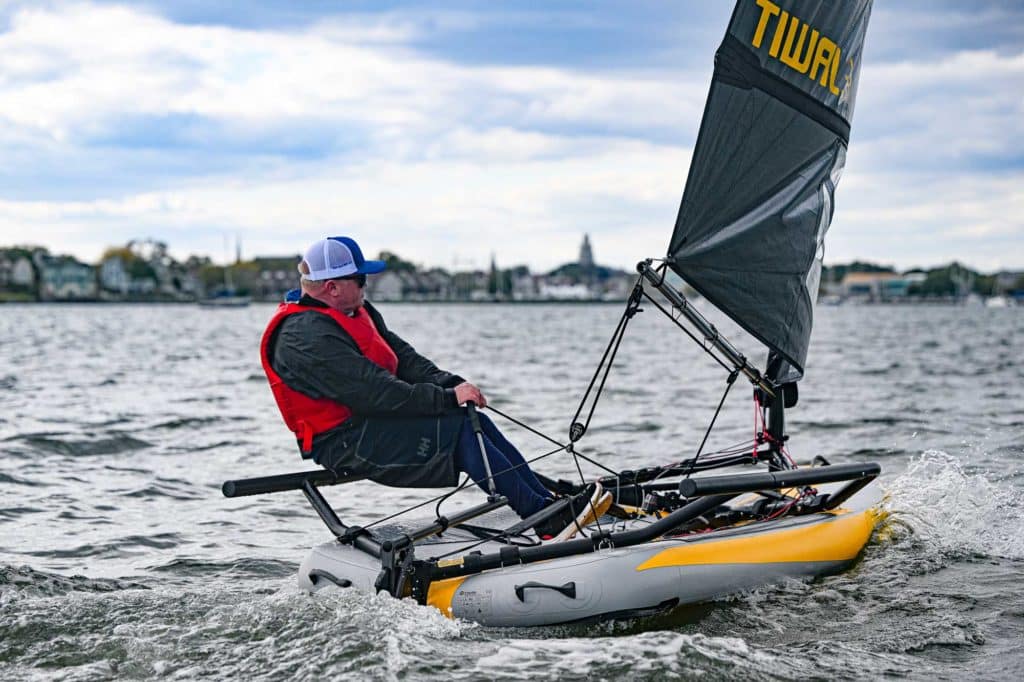
Sailing World Magazine’s annual Boat of the Year tests are conducted in Annapolis, Maryland, following the US Sailboat Show. With independent judges exhaustively inspecting the boats on land and putting them through their paces on the water, this year’s fleet of new performance-sailing boats spanned from small dinghies to high-tech bluewater catamarans. Here’s the best of the best from our 2023 Boat of the Year nominees »
The High-Pressure Ripper
- Tiwal 3R 2023 Best Dinghy
- Stated purpose: Recreational sailing, one-design and rally racing
- Crew: One to two
- Praise for: Performance, comfort, portability
- Est. price as sailed: $8,900
The surest way to grow sailing is to make it easy to get on the water with minimal hassle on a boat that is exhilarating to sail—and that’s exactly what the inflatable and powered-up Tiwal 3R does. Thousands of Tiwal fanatics around the world can’t be wrong; they love their zippy little crafts, and the Tiwal community has grown ever larger since its young French innovators launched the first model a decade ago. The Tiwal 3R is the continuing evolution of a great idea—with even better execution. Tiwal boats keep getting better, and this one is its best yet.
The “R” is for Race, and that’s because after two years of playing and adventure racing on the early-edition Tiwal 3s, keener owners started asking for more. But the engineering required to make Tiwal’s high-pressure inflatable hull and aluminum frame take on greater rig and structural loads that had them stumped for nearly two years, says Emmanuel Bertrand. They kept breaking it until they got it right.
At 10 feet and 121 pounds fully rigged, the magic of the Tiwal 3R is its portability, which would explain why the company says it sells so many in urban areas around the world. The sail, hull, blades, five-part composite spar and boom, and aluminum frame pack into two 5-foot duffel bags. To put it all together at whatever water’s edge takes about 30 minutes; it’s mere minutes if the boat is coming off the car top already pumped and assembled.
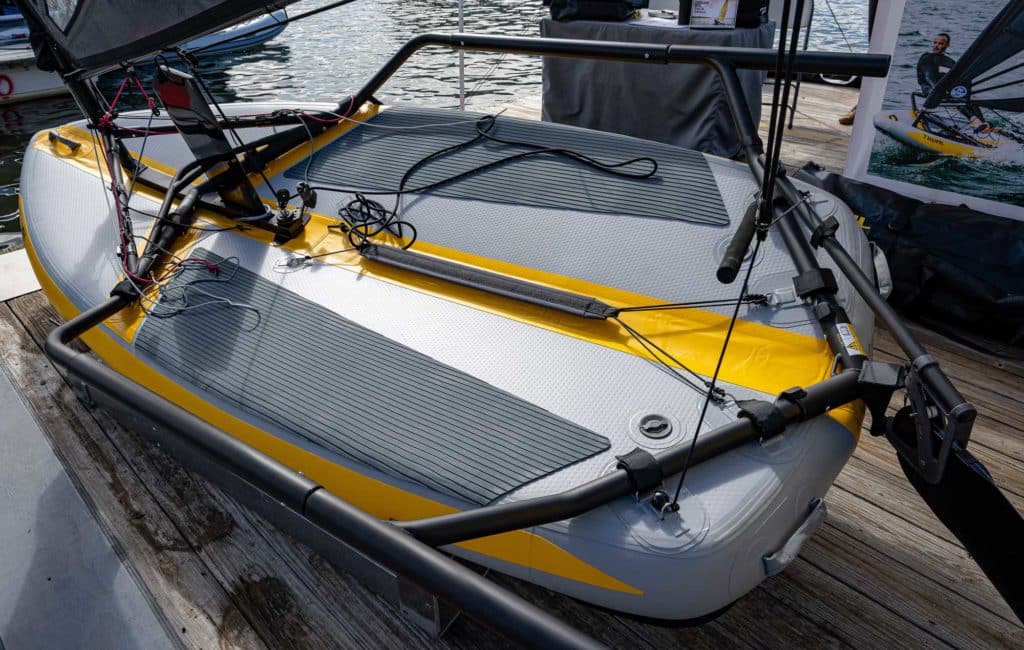
The PVC hull construction is identical to all other Tiwals, but the design for the 3R is a big improvement, with a more pronounced V-shape, a bit more rocker, and a reinforcement plate on the bottom near the transom, which gives it stiffness and a cleaner exit. “It’s difficult to get a hard corner on inflatables,” Stewart says, “so that’s a great solution to give it a nice sharp edge and a cleaner break so the water isn’t bubbling up over the back.”
When I got my weight in the right spot, the boat just took off. It’s quicker than quick. —Chuck Allen
The gust-responsive rig and big sail, built with North Sails racing cloth, is what takes the boat a big step from the recreational sailor’s Tiwal 3 to the racing sailor’s 3R, Powlison says. “This is the same size sail as a Laser, 77 square feet, which is a lot of power. When you get the vang set right, it does make a big difference. It is an effective control that they got right.”
Powlison’s only desire was to be able to get the sail controls to run farther back on the rack, accepting, however, that this would unnecessarily complicate the setup.
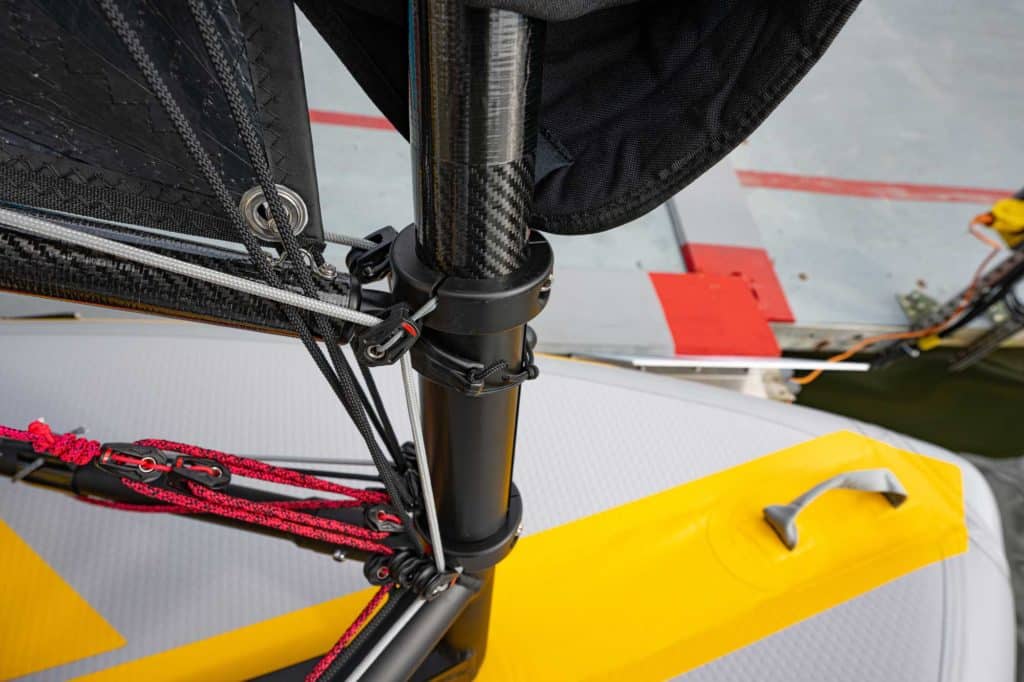
Allen, who’s been a Tiwal fan since the original, is impressed once again. “You definitely get a lot more performance out of this thing,” he says after sailing the boat in 10 to 15 knots and flat water. “I got hit with a puff and was like, dang! This thing’s got some wheels. It’s much faster and stiffer. I’m 170 pounds and was able to stay out on the rack the entire time, even when it got light.”
Stewart’s assessment of the 3R is that it’s built for a slightly more advanced sailor. “This thing is higher tech, with a lot more control lines, so it’s a bit more boat to handle. That being said, I’m a big guy (the manufacturer’s stated maximum load on the wing is 242 pounds), and I was never sitting in water, so it will accommodate a wide range of people.”
Getting the purchase systems for the 4-to-1 cunningham and the two-part vang (all of which are doubled-ended) into the mast collar hardware was an engineering exercise, says creator Marion Excoffon. But the end result is a system of color-coded lines and color-matched Harken blocks that work effectively and smoothly to depower the sail. Once the control systems are assembled, they don’t need to be rerun. When rigging, simply slide the mast into the collar, hook up the mainsheet, attach the rudder, and cast off for a fast and sporty adventure.
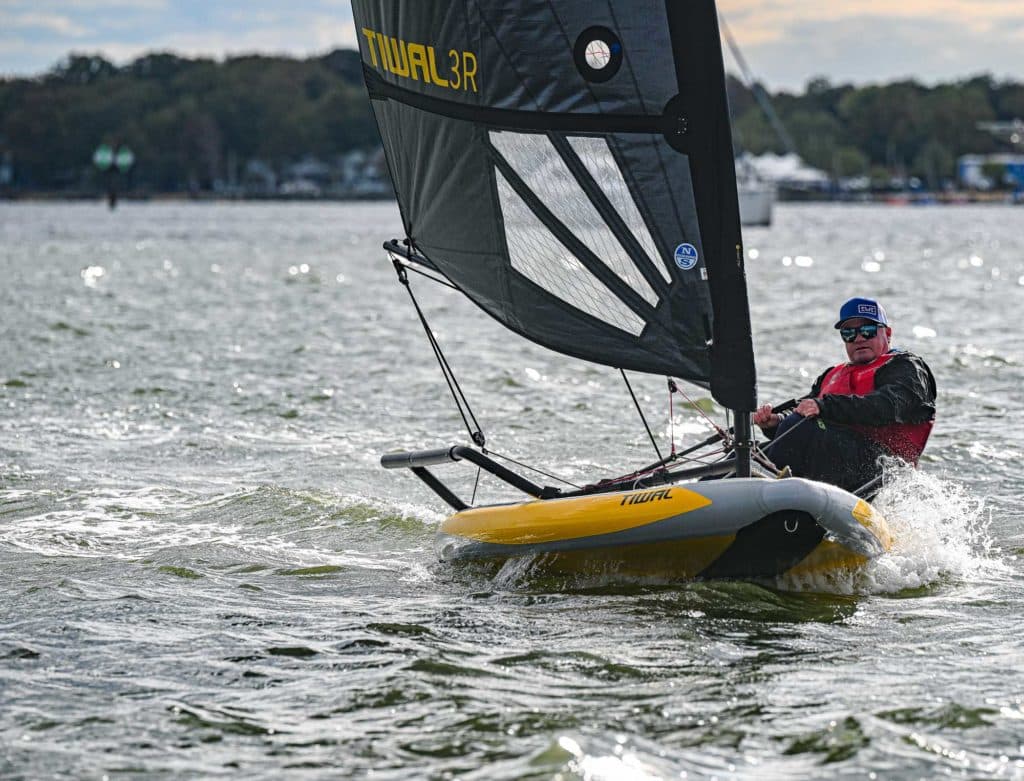
“Every time I got a little puff, the boat zipped right along,” Allen says. “The foils are stiff and shaped well, so the boat goes upwind really nicely. The bow was stiff and wasn’t flopping in the chop. But the best part was reaching around in the big puffs, sitting at the back corner of the rack, with the boat just skimming. When I got my weight in the right spot, the boat just took off. It’s quicker than quick.”
- More: 2023 Boat of the Year , Boat of the Year , Dinghy , Print Winter 2023 , Sailboats
- More Sailboats

Nautor Swan Has A New Pocket Rocket

Pogo Launches its Latest Coastal Rocket

A Deeper Dive Into the Storm 18

2024 Boat of the Year Best Recreational Racer: Z24

Brauer Sails into Hearts, Minds and History

Anticipation and Temptation

America’s Offshore Couple

Jobson All-Star Juniors 2024: The Fast Generation

- Digital Edition
- Customer Service
- Privacy Policy
- Cruising World
- Sailing World
- Salt Water Sportsman
- Sport Fishing
- Wakeboarding

Sailing Dinghy: A Beginner’s Guide to Navigating the Waters 2023
- May 19, 2023
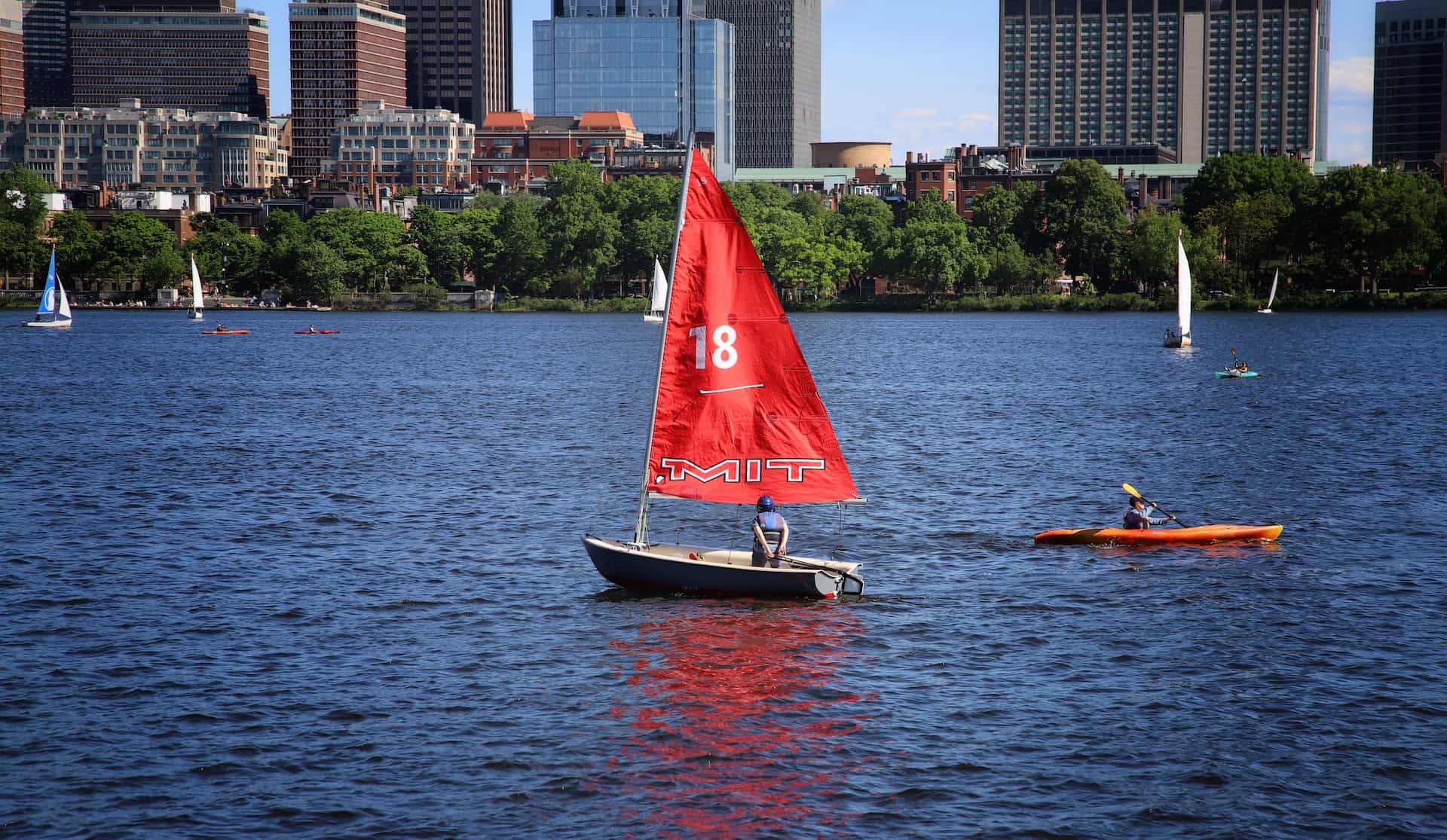
Are you ready to embark on an exhilarating adventure on the water? A Sailing Dinghy offers an excellent opportunity for beginners to dive into the world of sailing. In this beginner’s guide, we will provide you with all the essential information you need to know about sailing dinghies, from choosing the right boat to mastering basic sailing techniques. Get ready to set sail and discover the joy of navigating the waters with a sailing dinghy.
Table of Contents
What is dinghy sailing.
Dinghy sailing is a thrilling and dynamic water sport that involves sailing small, single-masted boats known as dinghies. These compact vessels are designed to be manoeuvrable and responsive, providing an exciting and hands-on experience for sailors of all skill levels. Dinghy sailing allows individuals to harness the power of the wind as they navigate through various bodies of water, including lakes, rivers, and even coastal areas. It offers a unique sense of freedom and adventure, as sailors rely on their skills and the natural elements to propel them forward. Whether you’re a beginner seeking an introduction to the world of sailing or an experienced sailor looking for an exhilarating challenge, dinghy sailing offers endless opportunities for exploration, competition, and pure enjoyment on the water.
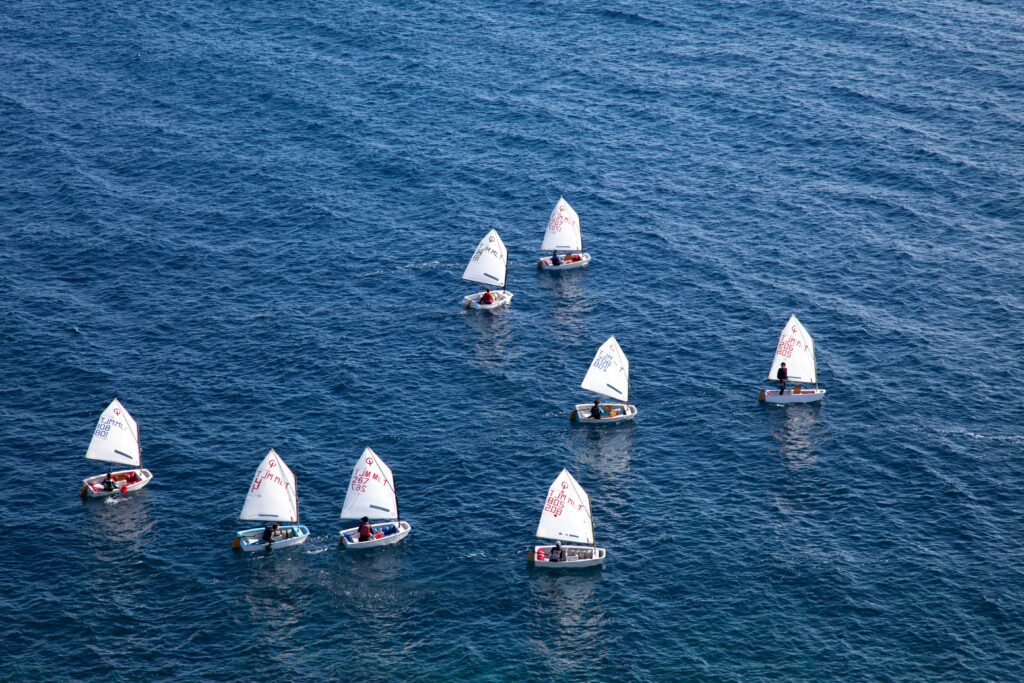
How to learn Dinghy Sailing
To learn dinghy sailing in the UK, there are several resources and qualifications available to help you get started on your sailing journey. One of the most recognized qualifications is the Royal Yachting Association (RYA) Dinghy Sailing Scheme. The RYA offers a range of courses for beginners, including the Start Sailing Level 1 and Level 2 courses, which provide a solid foundation in dinghy sailing skills. These courses cover everything from boat handling and rigging to basic sailing techniques and safety procedures. To find a recognized training centre near you that offers RYA courses, you can visit the RYA’s official website at www.rya.org.uk . Additionally, many sailing clubs and schools across the UK offer dinghy sailing lessons and courses for beginners. It’s always beneficial to learn from qualified instructors who can provide guidance and support as you develop your skills.
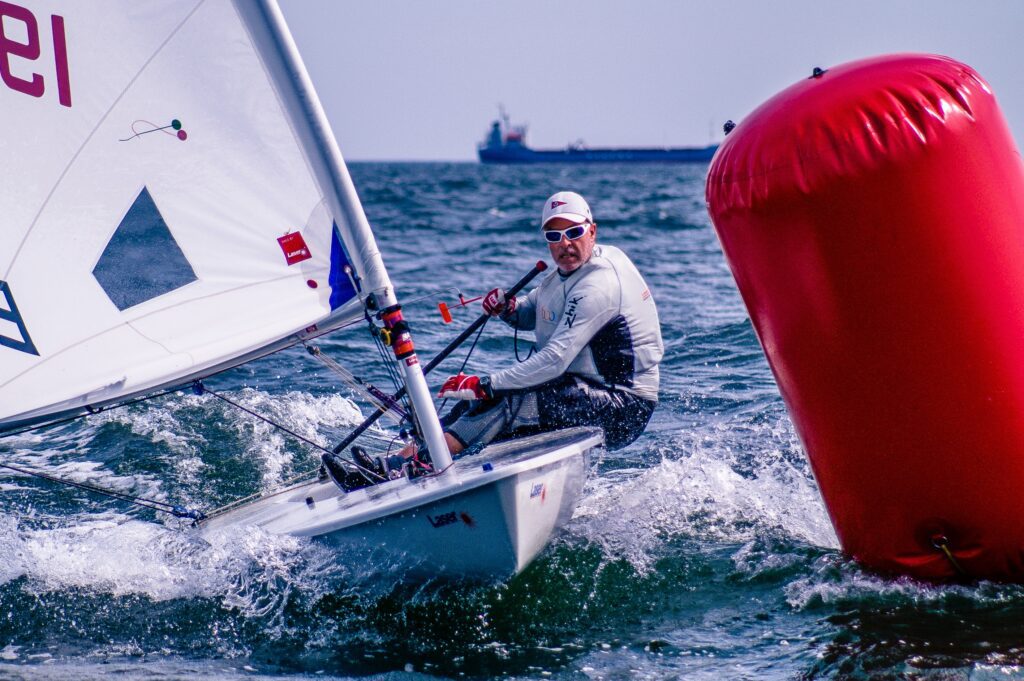
Things to Consider when starting out
Although when attending a course most of the equipment should be provided, if you are ready to start investing in your own equipment here are a few things to consider:
Choosing the Perfect Sailing Dinghy
Selecting the right dinghy is crucial for a beginner’s journey. Here are a few key factors to consider when selecting a beginner sailing dinghy:
1. Stability
Opt for a dinghy that offers stability, allowing you to learn and build confidence in your sailing skills. Look for boats with a wide hull and a low centre of gravity.
As a beginner, it’s recommended to start with a smaller single handed sailing dinghy. Smaller boats are easier to handle and manoeuvre, making it simpler to grasp the basics of sailing.
3. Rigging and Maintenance
Consider the ease of rigging and maintaining the dinghy. Look for boats with simple rigging systems and minimal maintenance requirements, which will allow you to spend more time on the water.
Essential Equipment for Sailing Dinghy
Before setting sail, ensure you have the necessary equipment to stay safe and enjoy your sailing experience:
1. Personal Floatation Device (PFD)
Invest in a comfortable and well-fitting PFD or life jacket that is approved for sailing. Check out our Ultimate Guide to Choosing the Best Life Jacket for Water Sports .
2. Sailing Apparel
Wear appropriate clothing that protects you from the elements. Depending on the weather conditions, consider a wetsuit or a dry suit to keep you comfortable.
3. Safety Gear
Carry a whistle for signalling, a sailing watch to keep track of time and speed, and appropriate footwear with a good grip to prevent slipping on wet surfaces.
Mastering Basic Sailing Techniques
Now that you have your sailing dinghy and equipment ready, it’s time to learn the fundamental sailing techniques:
- Rigging – Familiarize yourself with the various parts of your dinghy and learn how to properly rig the sails, attach the mast, and secure the lines.
- Launching and Landing – Practice launching your dinghy from the shore or a boat ramp, and learn how to land it safely. Pay attention to potential obstacles and other sailors while manoeuvring.
- Steering – Understand the basics of steering your dinghy using the tiller or the helm. Learn how your boat responds to different wind conditions and adjust your steering accordingly.
- Sailing Upwind – Discover the art of sailing against the wind, known as sailing upwind or beating. Learn how to tack, which involves turning the boat through the wind, and find the optimal angle for making progress.
- Sailing Downwind – Master sailing with the wind behind you, known as sailing downwind or running. Practice gybing, which involves turning the boat with the wind coming from behind.
- Capsize Recovery – Learn the essential capsize recovery techniques. Practice self-rescue methods, such as righting the boat, bailing out water, and getting back on board.
Safety Precautions for Sailing Dinghy
Safety should always be a top priority while sailing. Here are some crucial safety measures to adhere to:
- Always wear your PFD or life jacket when on the water.
- Stay updated with the weather forecast and avoid sailing in adverse conditions such as storms or strong winds.
- Sail within your skill level and gradually progress as you gain confidence and experience.
- Inform someone ashore about your sailing plans, including your intended route and estimated return time.
- Be aware of potential hazards, such as rocks, submerged objects, or other watercraft in your vicinity.
- Familiarize yourself with the rules and regulations of the waterways you’ll be sailing in, and ensure you follow them diligently.
Embarking on your sailing journey with a sailing dinghy is an excellent choice for beginners. By selecting the right dinghy, acquiring the necessary equipment, mastering basic sailing techniques, and prioritizing safety, you’ll be well-prepared to navigate the waters and enjoy the incredible experience of sailing. Remember to practice regularly, seek guidance from experienced sailors, and most importantly, have fun as you set sail with your sailing dinghy. Happy sailing and fair winds!
Related Posts
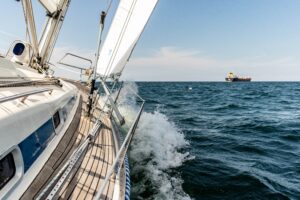
Understanding the Parts of a Sailboat: A Comprehensive Guide to Sailboat Anatomy in 2023
- June 10, 2023

Exploring the Different Types of Sailboats and Their Versatile Uses
- May 20, 2023

Keelboat Sailing 101: A Beginner’s Guide to Navigating the Seas with Stability

Sailing Dinghy: The Ultimate Guide for Beginners
by Emma Sullivan | Jul 13, 2023 | Sailing Adventures
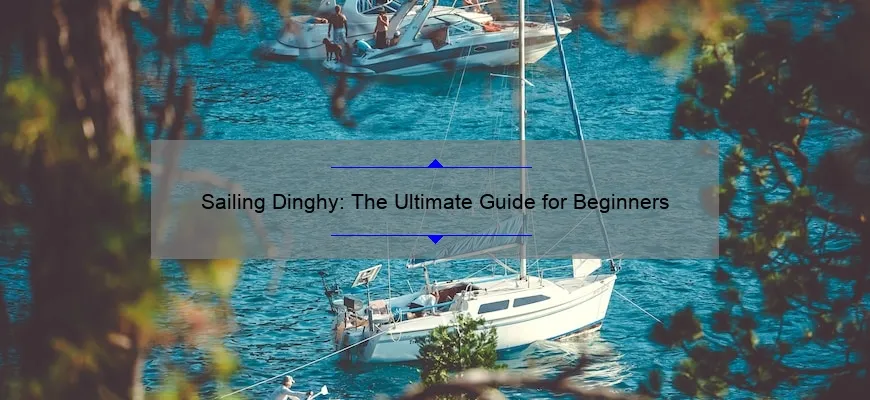
Short answer: Sailing Dinghy
A sailing dinghy is a small, lightweight boat designed for recreational or competitive sailing. It typically has a single mast and sails, and can be sailed by one or two people. Dinghies offer an accessible way to learn and enjoy sailing, with various types available including the popular Laser, Optimist, and Flying Junior models.
How to Choose the Perfect Sailing Dinghy for Your Adventures
Title: Embarking on New Adventures: Expert Tips for Selecting Your Ideal Sailing Dinghy
Introduction: Setting sail on a thrilling adventure with your very own sailing dinghy is an experience that few can resist. Whether you’re an avid sailor seeking the perfect companion or a beginner ready to dive into the captivating world of sailing, choosing the right dinghy is crucial. In this comprehensive guide, we will navigate through the key considerations and share expert insights to help you select the flawless sailing dinghy for your upcoming adventures.
1. Evaluate Your Skill Level: As with any sporting activity, assessing your skill level is paramount when selecting a sailing dinghy. Beginners should opt for forgiving and stable options, such as small catamarans or dinghies equipped with centerboards that offer enhanced stability and ease of control. On the other hand, experienced sailors might feel more comfortable pushing their limits with high-performance racing dinghies designed for speed and maneuverability.
2. Purpose and Intended Use: Consider how you plan to utilize your sailing dinghy. Are you looking to embark on serene leisure cruises? Or are adrenaline-pumping regattas and races more your style? The purpose of usage dictates various factors like size, design, rigging options, and even storage requirements.
– For Recreational Sailing: If relaxation is your primary objective, seek out spacious designs with comfortable seating arrangements suitable for day trips. Dinghies featuring open cockpits allow easy movement while showcasing stability in calmer waters. – Racing Enthusiasts: Aspiring sailors seeking competitive endeavors should gravitate toward lighter-weight designs built specifically for speed and agility. Consider high-performance hulls with advanced rigging systems that maximize control during tight maneuvers.
3. Size Matters: Selecting an appropriate dinghy size is crucial to ensure safety, comfort, and overall performance on the water. – Solo Sailors: Those planning solitary adventures should opt for smaller, single-handed sailing dinghies that offer ease of handling, maneuverability, and quick rigging. – Crew or Family Sailing: For group outings or family escapades, larger dinghies with multiple seating options and spacious interiors are recommended. Look for models designed to accommodate your specific crew size comfortably.
4. Material Considerations: Dinghies can be crafted from a variety of materials, each presenting unique attributes in terms of durability, maintenance, weight, and cost. – Fiberglass: Popular for its reliability and longevity while offering sleek designs and low maintenance requirements. – Wood: A classic choice appreciated for its timeless appeal and natural beauty. Wooden dinghies require greater upkeep but can be extremely rewarding for enthusiasts who enjoy the traditional aesthetic. – Inflatable Dinghies: Versatile and easily transportable options that inflate quickly when needed—ideal for those seeking convenience or frequent exploration in distant locations.
5. Estimating Budget: Understanding the financial investment required is essential before embarking on your purchase journey. Determine your budget based on factors like desired features, boat condition (new vs. pre-owned), accessories required (sails, oars), and ongoing maintenance costs. Exploring both new and used market options may help find the sweet spot between quality and affordability.
Conclusion: Selecting the ideal sailing dinghy requires careful consideration of various factors such as skill level, intended use, size requirements, materials used in construction, and available budget range. Taking these aspects into account will not only pave the way for safe and enjoyable adventures but also ensure a long-lasting relationship with your chosen vessel. So set sail with confidence on your next adventure as you navigate the vast ocean waves with grace aboard your perfect sailing dinghy!
A Step-by-Step Guide to Rigging and Launching a Sailing Dinghy
Rigging and launching a sailing dinghy can be an exciting adventure for those who love the open water. Whether you’re a seasoned sailor or just starting out, properly rigging and launching your dinghy is crucial for a safe and successful outing. In this step-by-step guide, we’ll walk you through everything you need to know to get your sailing dinghy ready for action.
Step 1: Gather Your Gear Before you begin the rigging process, it’s essential to gather all the necessary equipment and gear. This includes sails, mast, boom, rudder, tiller, lines (ropes), lifejackets, and any other required safety equipment. Having everything organized ahead of time will make the rigging process smoother.
Step 2: Prep the Mast Start by inserting the mast into its base on the boat securely. Make sure it is straight and secure before proceeding further. Attach any necessary hardware such as shrouds or stay wires that support the mast’s stability.
Step 3: Connect Boom and Sails Next, attach the boom to the mast using appropriate fittings or hardware. Ensure that it is securely fastened so that it won’t come loose when under sail. Now attach your main sail to both the mast and boom using halyards (lines) or clips provided for this purpose.
Step 4: Install Rudder and Tiller Once your sails are secured in place, proceed to install the rudder onto its pintles (metal fittings) at the back of your dinghy. Make sure it moves freely but with enough resistance while being attached tightly enough to avoid falling off during sailing activities. Attach one end of a tiller extension to the top of your tiller handle before inserting it into its fitting on top of the rudder assembly.
Step 5: Check Lines and Controls Take a moment to ensure all control lines are in proper working order before leaving the dock. These lines include sheets (controls for adjusting sails), halyards (controls for raising and lowering sails), and any other lines specific to your dinghy’s rigging setup.
Step 6: Safety Check Before launching, conduct a thorough safety check. Inspect all the installed equipment to ensure there are no loose fittings or potential hazards. Ensure you have life jackets on board for everyone, alongside essential safety items such as a whistle, flares, and a first aid kit.
Step 7: Launching Your Dinghy Now it’s time to launch your dinghy into the water! Find an appropriate boat ramp or area that provides easy access to the water. Make sure your dinghy is securely attached to a trailer or hoist system before slowly lowering it into the water.
Step 8: Adjust Sails and Prepare for Sailing Once your dinghy is in the water, climb aboard while being mindful of your balance within the vessel. Adjust the sails accordingly by releasing or tightening control lines until they are adequately set for sailing conditions.
Step 9: Give Way to Freedom! Finally, push off from shore or engage your engine if necessary—head out onto open waters with confidence in your newly rigged sailing dinghy!
Rigging and launching a sailing dinghy may seem like a daunting task at first, but with this step-by-step guide, you’ll find yourself confidently setting sail in no time. Remember that practice makes perfect – take every opportunity to hone your skills and learn more about safely navigating on open waters. So grab your gear, embrace the wind in your sails, and enjoy every moment aboard as you embark on exciting nautical adventures!
Exploring the Basics: Understanding the Components of a Sailing Dinghy
Are you eager to embark on your sailing adventures but feeling a bit overwhelmed by the complex world of sailing dinghies? Don’t worry, we’ve got you covered! In this blog post, we’ll break down the essential components of a sailing dinghy, helping you understand their functions and how they contribute to your incredible sailing experience. So grab your life jacket and let’s dive in!
1. Mast and Rigging:
Let’s start at the top with the mast and rigging – the backbone of any sailing dinghy. The mast is a vertical spar that supports the sails, allowing you to harness the power of wind. Rigging comprises various cables, wires, and lines that support and control the shape of the sail. Together, they ensure stability and allow for smooth maneuvering through different conditions.
Ah, yes! The majestic sails that capture the wind’s energy to propel you forward! Sailing dinghies typically have two types of sails – a mainsail and a jib/genoa. The mainsail is attached to the mast while the jib/genoa is mounted on the forestay at the bow. These sails work together to catch wind from different directions, making use of every gust for maximum speed.
Imagine yourself as Captain Jack Sparrow steering your ship – well, meet your trusty companion; The rudder! Located at the stern (back) of your sailing dinghy, it allows you to control direction by adjusting its angle relative to water flow. Be mindful of maintaining proper balance between speed and maneuverability – too much rudder can cause drag!
4. Centerboard or Daggerboard:
Diving beneath your boat’s surface brings us face-to-face with an often overlooked hero –the centerboard or daggerboard! Attached to keel/centerline underneath your boat or inside its hull respectively (depending on design), these retractable fins provide stability, preventing excessive drifting sideways. Lower it when sailing and retract it during beach landings or shallow waters to avoid damage.
The hull, the lower part of your dinghy that sits in the water, plays a vital role in buoyancy, stability, and speed. Most dinghy hulls are made from fiberglass, wood, or composite materials like carbon fiber. Each material has distinct characteristics offering different trade-offs between weight, strength, and cost – be sure to choose wisely!
6. Control Lines:
Ever wondered how those skilled sailors effortlessly perform stunning maneuvers? Well, behind their impressive skills lies an intricate web of control lines! From cunninghams to outhauls, downhauls to vang lines – these ropes help you adjust sail shape, control tension on various parts of your boat’s rigging and achieve optimal performance under different wind conditions.
7. Sailing Instruments:
If you’re aiming for precision and advanced data about your boat’s performance on the water – investing in sailing instruments is a game-changer! From depth sounders and GPS devices to wind indicators and compasses – these handy gadgets provide valuable information helping you navigate with finesse while avoiding unexpected obstacles underwater.
Understanding these essential components will boost your confidence as you embark on your sailing journey. Always remember – safety comes first! Ensure you have appropriate personal protection gear like life jackets and familiarize yourself with local laws and regulations before setting sail.
So there you have it – a comprehensive rundown of the key components that make up a sailing dinghy. Now that you’re equipped with this knowledge, hoist those sails high and embrace the joys of sailing with confidence! Fair winds and smooth seas await brave sailor!
FAQ: Everything You Need to Know About Maintaining and Repairing Your Sailing Dinghy
Welcome sailors! We are here to address all your queries and concerns about maintaining and repairing your beloved sailing dinghy. Whether you are a seasoned sailor or just dipping your toes into the pastime, we have compiled a comprehensive list of frequently asked questions that will provide you with all the necessary information to keep your dinghy in top-notch condition.
1. Why is regular maintenance important for my sailing dinghy?
Regular maintenance is vital for any watercraft, especially for sailing dinghies. Being exposed to the elements, they require special attention to ensure optimal performance and longevity. Routine checks and upkeep will prevent minor issues from turning into major problems while ensuring safety on the open water.
2. What should be included in my regular maintenance routine?
Your routine maintenance should encompass several crucial aspects: – Hull Inspection: Regularly examine your hull for any signs of damage or wear, including cracks or loose fittings. – Cleaning: Remove dirt, grime, and saltwater residues after each use to prevent corrosion and deterioration. – Rigging Inspection: Inspect ropes, lines, and fittings for fraying or weakened areas that may compromise their integrity. – Sail Care: Check for tears, mold growth, or loose stitching on your sails. Prompt repairs or replacements are essential. – Safety Equipment Check: Ensure all safety gear such as life jackets, flares, fire extinguishers are functional and up-to-date.
3. How can I protect my sailing dinghy from degrading due to sun exposure?
The sun’s rays can take a toll on boat finishes over time if not properly protected. To shield your sailing dinghy from this degradation: – Apply UV-resistant wax to the hull regularly. – Invest in a fitted cover designed specifically for such boats when it is not in use. – Store your dinghy in shaded areas whenever possible.
4. What steps should I take if I notice any damage or wear on my dinghy?
It is crucial to address any damages promptly to ensure optimal performance and safety: – For minor cracks or chips, use an appropriate marine-grade epoxy to fill them in. – Consult a professional if you encounter major structural damage or are unsure about repairs needed. – Regularly check the condition of your rigging and replace any frayed or weakened lines promptly.
5. Are there any specialized tools or equipment I should have for maintaining my sailing dinghy?
While basic maintenance can be done with common tools, certain tasks may require specific equipment: – A sail repair kit consisting of adhesive patches, thread, and needles for quick fixes on sails. – An epoxy kit for repairing cracks or chips on the hull. – A tension gauge to ensure proper rigging tension for optimal performance.
Remember to familiarize yourself with these tools’ proper usage before attempting repairs!
Now that you’re armed with knowledge about sailing dinghy maintenance and repair, you can confidently hit the water without worries. Stay safe, take care of your vessel, and enjoy the exhilarating experience of sailing!
Essential Safety Tips for Beginners in Sailing Dinghies
Sailing dinghies offer a thrilling and adventurous experience on the open water. Whether you’re a novice or an experienced sailor, it’s crucial to prioritize safety while embarking on your sailing journey. In this blog post, we’ll provide you with some essential safety tips catered specifically towards beginners in sailing dinghies. So grab your life jacket and let’s dive in!
1. Always wear a life jacket: Safety should always be your number one priority when sailing. Regardless of your swimming abilities, wearing a properly fitted and Coast Guard-approved life jacket is non-negotiable. It provides buoyancy and ensures your safety in case of an unexpected capsize or any other unforeseen circumstance.
2. Get acquainted with the weather forecast: Checking the weather conditions before setting sail is imperative for any sailor, especially beginners. Unfavorable weather can make your sailing experience dangerous and unpredictable. Keep an eye out for strong winds, storms, or changing tides that may affect your journey. Remember, it’s better to stay ashore if the weather seems risky.
3. Learn basic navigation skills: Understanding basic navigation techniques will help you maintain control over your dinghy even if you lose sight of land or landmarks. Familiarize yourself with reading nautical charts to identify potential hazards like shallow waters or submerged rocks within your sailing area. Additionally, learning how to use a compass can assist you in maintaining course direction when visibility is limited.
4. Never sail alone initially: As an inexperienced sailor venturing into the world of dinghy sailing, it’s advisable not to embark on solo trips until you’ve gained confidence and sufficient knowledge about handling various situations on the water. Sailing with a more experienced buddy or joining a beginner-friendly sailing club allows for shared responsibilities and immediate assistance during emergencies.
5. Inform others about your plans: Before heading out on the water, inform someone trustworthy about your planned itinerary – including departure time, expected return, and the sailing area you’ll be exploring. In case of any delays or unforeseen circumstances, this information will enable others to start searching for you if necessary.
6. Know your limits: It’s crucial to acknowledge your own abilities and limitations as a beginner sailor. Be honest with yourself about your swimming skills, knowledge of sailing techniques, and comfort level on the water. Avoid pushing boundaries by attempting challenging maneuvers or heading into unfamiliar territory until you’ve gained sufficient experience and competence.
7. Stay aware of your surroundings: Constant vigilance is essential while sailing in order to avoid potential collisions with other vessels or fixed obstacles such as moored boats, buoys, or rocks. Regularly scan the area around you and maintain situational awareness at all times. Remember, prevention is always better than dealing with an accident afterward!
8. Practice capsizing drills: Capsize recovery skills are vital for any dinghy sailor – even more so for beginners. Learning how to properly right a capsized dinghy and reboard it can save both equipment and lives in emergency situations. Familiarize yourself with these techniques by practicing them under controlled conditions before venturing out into unfamiliar waters.
9. Carry essential safety equipment: Apart from a life jacket, ensure that your dinghy is equipped with necessary safety gear such as a whistle or horn to signal distress, a waterproof flashlight for emergencies during low visibility hours, flares (if required), and a throwable flotation device like a lifebuoy.
10. Take sailing lessons from professionals: Last but not least, investing in formal sailing lessons conducted by certified instructors can be invaluable for acquiring the essential skills needed to become a confident sailor. These experts will guide you through proper boat handling techniques, safety protocols specific to dinghies, and provide insights based on their extensive experience.
By adhering to these essential safety tips tailored towards beginners in sailing dinghies, you’ll be well-prepared to enjoy a safe and enjoyable sailing experience. Remember, it’s better to err on the side of caution when it comes to venturing out into the open water – your safety should always be your top concern. So set sail with confidence, aware of the risks but ready for adventure in your trusty dinghy!
Unleashing the Thrill: Mastering Advanced Techniques in Sailing Dinghy Racing
Do you find yourself yearning for the exhilarating rush of adrenaline, the wind whipping through your hair, and the sense of ultimate freedom that comes from gliding effortlessly across the water? If so, then you’re no stranger to the enchanting world of sailing dinghy racing. But what if we told you there’s a whole new level of excitement waiting to be discovered – one that can only be achieved by mastering advanced techniques?
In this blog post, we are determined to unlock the secrets that will take your sailing skills to unprecedented heights. Prepare to experience an electrifying journey as we delve into the realm of advanced techniques in sailing dinghy racing.
First and foremost, let’s talk about boat handling. While basic maneuvering may have gotten you across the finish line before, it’s time to elevate your game. The art of skillful boat handling lies in precisely trimming sails, adjusting weight distribution, and anticipating changes in wind direction like a seasoned sailor. We’ll guide you through these intricacies with detailed explanations and expert advice so that you can glide effortlessly through choppy waters and leave your competitors trailing behind.
Next up on our quest for mastery is strategy. Sailing dinghy racing isn’t just about who can sail fastest; it’s about making strategic moves that will give you an edge over your rivals. By understanding wind patterns, current flows, and racecourse dynamics like never before, you’ll be able to make split-second decisions that can mean the difference between victory and defeat. Our clever insights will equip you with game-changing strategies that even experienced sailors may not have uncovered.
But let us not neglect the importance of physicality when it comes to dominating on the waves. Sailing dinghies demand strength, agility, and sheer determination from their captains. Our professional guidance will help condition your body for optimal performance while sharing inventive workouts to hone your reflexes and build the endurance required for these high-octane races. After all, being physically fit is not only vital for your own safety but also ensures an unstoppable presence on the water.
As we unlock the mastery of advanced techniques, we invite you to embrace innovation. Unleash your creativity and dare to challenge conventional sailing norms with groundbreaking techniques that will leave everyone in awe. We’ll explore cutting-edge technologies and equipment choices, giving you insider knowledge on how to gain a competitive edge using tools that others haven’t even thought of yet.
Last but not least, we must emphasize the importance of fostering camaraderie within this tight-knit sailing community. Forming alliances and learning from experienced sailors can significantly accelerate your growth as a racer. Our witty anecdotes and stories from seasoned professionals will entertain you while imparting valuable wisdom garnered through years of experience.
So buckle up (or should we say “harness yourself”) for an exhilarating journey into the world of mastering advanced techniques in sailing dinghy racing. With our detailed professional guidance, witty insights, clever strategies, and innovative approaches – there’s no limit to what you can achieve on those waves. Get ready to unleash the thrill like never before!
Recent Posts

- Sailboat Gear and Equipment
- Sailboat Lifestyle
- Sailboat Maintenance
- Sailboat Racing
- Sailboat Tips and Tricks
- Sailboat Types
- Sailing Adventures
- Sailing Destinations
- Sailing Safety
- Sailing Techniques

- Forums New posts Unanswered threads Register Top Posts Email
- What's new New posts New Posts (legacy) Latest activity New media
- Media New media New comments
- Boat Info Downloads Weekly Quiz Topic FAQ 10000boatnames.com
- Classifieds Sell Your Boat Used Gear for Sale
- Parts General Marine Parts Hunter Beneteau Catalina MacGregor Oday
- Help Terms of Use Monday Mail Subscribe Monday Mail Unsubscribe
Best Dinghy for Small Sailboat
- Thread starter SailorElliot
- Start date Jul 19, 2021
- Tags dinghy flicka 20 inflatable dinghy
- Forums for All Owners
- Ask All Sailors
SailorElliot
Hello! I am wondering what the best dinghy is for rowing/motoring to shore on my Flicka 20. I would prefer not to tow. Is a motor necessary, or is it possible to row to the dinghy dock/the shore from a mooring? Thank you!
The one that can fit on your sailboat, light enough for you and/or your crew to handle, large enough for crew and supplies, do you want to get up on plane with a motor AND fits your budget...........do not think there is a best dinghy. I like a low cost, lightweight (52-53 lbs) rollup dinghy like a West Marine PRU-3 for $1000 WEST MARINE PRU-3 Performance Roll-Up Inflatable Boat | West Marine or RU-250 for $700: WEST MARINE RU-250 Roll-Up Inflatable Dinghy | West Marine The need for a motor depends on how far AND how fast you need to go..............If you want a motor there are a lot of factors like weight, do you ant to carry gasoline, etc. I like a lightweight electric motor like a Torqeedo 503 or 1003 Travel 503/1003l - Torqeedo .
Leeward Rail
SailorElliot said: am wondering what the best dinghy is for rowing/motoring to shore on my Flicka 20 Click to expand
SailorElliot said: Is a motor necessary, or is it possible to row to the dinghy dock/the shore from a mooring? Click to expand
Project_Mayhem
Don't over look the value of a beat up old dinghy - They're far less likely to be stolen! The inflatables are more stable which is good when guests are on board and when doing boat repairs from the dinghy. I have a small fiberglass dingy that weighs close to 100lbs. By the end of each season I'm a bit tired of lugging it to the dock multiple times a week. However, it's a load of fun to zip around the marina with a trolling motor
Thank you everyone for responding! I ended up getting an inflatable Intex kayak which works great and is easily stored.
I bought an Intex 5 person inflatable row boat. It works ok getting us from the dock to the mooring. It rows, but because it has a flat bottom, it doesn't track real well. I don't really think I would tow it for any distance because it's so light and could flip, but when we put the boat in this spring my 18 year old son was standing in it as I towed it behind me out to find the mooring. I guess that says something for the stability.
- This site uses cookies to help personalise content, tailor your experience and to keep you logged in if you register. By continuing to use this site, you are consenting to our use of cookies. Accept Learn more…
Better Sailing
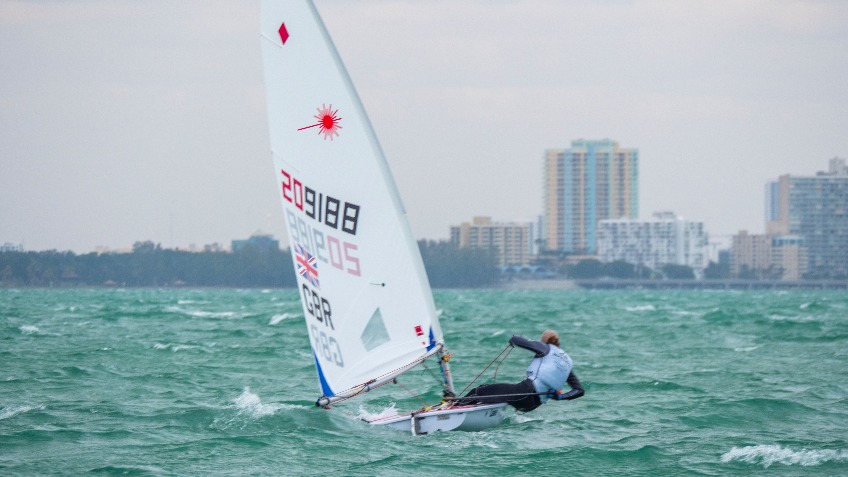
Dinghy Sailing: Beginner’s Guide
Sailing on a Dinghy or Small Boat is a good choice in learning how to sail. This is because Dinghies are simple, easy to maneuver, and very responsive to your actions as well as to Wind conditions. Sailing on a Dinghy will give beginners a sort of training ground – they will learn the basics and understand the different important aspects of the sport.
Learn what this Sailing Variation is all about. The following sections will give you some insights on the various features of Dinghy Sailing:
Dinghies – Types and Classes
Sailing History indicates that Sailing was used for trade and transportation before it became a source of enjoyment. It was in the late 1900s that people began using Small Boats for leisure and sport.
The term ‘Dinghy’ is from India, which means ‘small’. A Dinghy is a small Sailboat designed to accommodate one or two persons and is usually used in recreational Sailing. It is powered by wind, outboard motor, or paddles.
In general, Dinghies are classified according to their purpose. They come in many types and features which suit different conditions.
In this section, know the numerous Dinghy Types and Classes:
Basic Types
- General – Purpose Dinghies : Dinghies under this type are most appropriate when learning the very basics of Sailing. These are usually used for leisure and enjoyment. Wayfarer is an example of a General-Purpose Dinghy. It is less than 16 feet long and is often used for short trips. Other examples include Mirror and Enterprise.
- Skiffs : Considered as the fastest Dinghy Type, a Skiff is a flat-hulled open Dinghy which can accommodate one or two persons. It can be powered using oars or a motor. Examples of Skiffs are Musto Skiff, 49er, Jersey Skiff, and 18ft. Skiff.
- High-Performance Dinghies : Dinghies under this type are fast and are used primarily for Racing.
- Racing Dinghies : As the name suggests, Dinghies under this type are used primarily for Dinghy Racing.
Here are some Classes of Dinghies:
- Laser Radial
- Jersey Skiff
These are the basic Dinghy Types and Classes. Take note that each one has its own features and is designed for a particular purpose.
Dinghies – Care and Maintenance
A Dinghy can be subjected to a lot of elements that can contribute to wear and tear over time. Thus, make the necessary steps to take care of your Dinghy after sailing in order to maintain its good performance every time you go onboard.
There are several things to do as far as proper care and maintenance is concerned. In this section, know some guidelines on how to take good care of your Dinghy:
- Once the Dinghy is ashore, rinse it thoroughly with fresh water.
- After washing the Rudder, Centerboard, and/or Daggerboard, store them in their respective bags.
- Make regular inspections so that damages or problems (if any) will be attended to before they become worse.
- Make sure to run repairs on parts that need to be fixed.
- Lay the Mainsail out on a clean, flat surface.
- Fold the top over onto the body of the Sail. Roll the Sail carefully and make sure that the roll is at right angles with the Leech.
- After rolling the entire Sail, put it in a sail bag.
- You can use a trolley to store your Dinghy. Tie the boat securely on the trolley. Put the detachable items inside the Dinghy. Fit the boat cover over the top and make sure that it is fastened firmly. Secure it under the Hull, Bow, as well as the sidedecks. To prevent your Dinghy from being blown over, tie the Sailboat down to securing points on the ground.
- Put your Dinghy in an area where it can be safe and secure. Dinghies can be left at Dinghy parks in many Sailing Clubs.
These are some tips on how to take care of your Dinghy and keep its good working condition. Regular checks and inspection on the components of your Dinghy can help ensure its good performance every time you go sailing.
Small Sailboat Buying Guide – How to Buy Dinghies
Dinghies and small Keelboats come in a wide range of features. Each is made and designed for a particular purpose to suit the needs of so many fans of Small Boat or Dinghy Sailing. However, there are many models that can be used for other types of Sailing besides the one in which it is designed for.
As a beginner, you need not buy a Dinghy or a Small Keelboat. Buy one when you have already tried different Dinghies and other Sailboats, and if you know by now the Sailing Variation that attracts you most.
In this section, know the different things to consider in buying Small Boats:
- Consider your skill and experience : Obviously, Sailing will be much more fun and a lot safer if your Sailboat is suitable to your skill as well as experience. Many Dinghies and small Keelboats have features that make them a bit more complex compared to other boats of the same type, therefore requiring more techniques. Hence, take your level of skill and know-how into consideration. Make sure that you and your Small Boat are well-matched to each other.
- Decide what Sailing Variation interests you most : Suitability is very important. As mentioned earlier, each Dinghy or Small Keelboat is designed for a particular type of Sailing. Therefore, make up your mind on what sort of Sailing attracts you most.
- Make some research : There are so many information resources available that can give you some ideas on the features of different Small Boats. Magazines and websites related to Sailing are good sources of information that you need.
- Get some advice : Experienced sailors can give you pointers on the advantages and drawbacks of a number of Small Boats. It is likely that they have tried several boats with varying features so they will be helpful in choosing the right Small Boat for you.
Make use of our Small Boat Buying Guide, as these pointers can help you in buying Dinghies. Take your time in the selection process. Look at several types and check the features of each one. Choose the one that suits your needs.
You can also read the “ How to Right a Capsized Sailboat ” article for this essential information if you thinking of starting Dinghy Sailing.
Dinghy Sailing Beginner’s Guide – Conclusion
It is obvious that knowing the essentials of Small Boat Sailing is crucial should you wish to pursue this Sailing Variation. Aside from the fact that you will learn different skills, the more important thing is that the learning process is a fun and exciting experience.
Peter is the editor of Better Sailing. He has sailed for countless hours and has maintained his own boats and sailboats for years. After years of trial and error, he decided to start this website to share the knowledge.
Related Posts

Atlantic vs Pacific: Which is More Dangerous for Sailing?

Why Do Sailboats Lean?

How Does a Boat Sail Upwind? Unveiling the Mechanics of Against the Wind Sailing

How Does Sailing Work? The Physics of Sailing
- Buyer's Guide
- Destinations
- Maintenance
- Sailing Info
Hit enter to search or ESC to close.
- Paddle Board

A Guide to Dinghy Boats
Are you looking for an affordable boat for your fishing trips or watersports? The dinghy offers you the best options for a low-cost, versatile watercraft. There are several dinghy designs to suit any watersports activity.
Typically, dinghies are the best choice for watersports like skiing and diving. However, some models are good for cruising or light sailing, with options for motors or sails. A dinghy can range in size, but most of them are suitable for carrying two to six people.
Dinghies are available in models suiting use in freshwater or saltwater, with inflatables, solid boats, and more options. Is a dinghy the right choice for your boat? Let’s unpack everything you need to know about these watercraft.
What Is a Dinghy Boat?
A dinghy is a small boat, usually and inflatable, and most models are around five to ten feet long. A dinghy is easy to transport, and it offers versatile utility for fishing and watersports. You also have options for motors, sales, or you can use oars to propel the boat.
Dinghies can feature fiberglass construction, or they may use inflatable pontoons, similar to a pontoon boat. The inflatable models typically feature design and construction with Hypalon or PVC. These polymers provide UV resistance, tough resistance against punctures, and easy repairs.
The sides on inflatables also act as seats, allowing fishing directly from all sides of the boat. Dinghies are not really built for speed; they usually come with low-powered trolling motors with a 3-hp to 5-hp output. However, they are ideal for moving through estuaries and lakes, allowing for silent movement so you don’t disturb the fish.
What are the best beginner sailing dinghies?
If you’re just getting into sailing, there are several dinghy options for enjoying your time out on the water. Whether you want to sail solo or with a friend, there is a boat for you.
Training Sailing Dinghies
These models are easy to master, giving beginners the chance to master the complexities of sailboats. They are simple to operate, safe, and offer you the best option for learning to master sailing techniques.
Doublehanded Sailing Dinghies
These models cater to two passengers for handling the sail and rigging. They are great for learners, allowing them to take an experienced sailor out on the water to learn the ropes.
Singlehanded Sailing Dinghies
These models have a design for one person. Typically, they are smaller boats, and you’ll already have to know how to sail. However, they are easy to master, and spending time out on the water will familiarize you with the aspects of sailboats.
These dinghies feature double or triple hulls. They are typically the best choice for racing, and they offer excellent stability in all water conditions.
Different Types of Dinghy Models
As mentioned, there are several models of dinghies for different watersports activities. Here are the most common options; we categorized them into sailing dinghies and inflatable dinghies.
Sailing Dinghies
A sailing dinghy is a small sailboat with no fixed keel and a shallow draft. These models are ideal for sailing in lagoons, estuaries, and lakes, navigating shallow waters. The sailing dinghy typically features a fiberglass design, with an open-plan seating area and a mast. These boats usually accommodate anywhere from one to five passengers.

High-Performance Dinghies
High-performance sailing dinghies are another sail-based model that’s ideal for racing. They are fast and cut through the water with ease. You get excellent maneuverability on the water with a low-profile design and an open-plan deck with a mast. The Fireball, International 505, and Thistle are a few examples of leading racing and high-performance dinghies.
Cruising Dinghies
A cruising dinghy is another sail-based model that’s a great choice for cruising out in calm ocean conditions or inland water bodies. They are a recreational vessel equipped with sails and rudders, and you have more passenger capacity than the other sailing models. As a result, they are the ideal choice for family’s that enjoy the sailing lifestyle.
Cruiser-Racer Dinghies
These models are hybrids that come with a focus on performance and stability. They have the ability to race or to cruise, providing excellent stability in the water. They are a great choice for someone that wants to start sailing competitively, and they also work for fun recreational sailing days on the lake with the family. The GP14 is an example of a cruiser-racer offering high-performance standards and stable cruising.
Classic Dinghies
These boats had an original design featuring wood finishes using materials like plywood and cedar. However, modern dinghies feature fiberglass construction. The classic dinghy sailboat focuses on versatility over sailing performance. The Minto is a great example of a classic dinghy.
Inflatable Dinghies
Inflatables are gaining in popularity thanks to the affordable price tag and versatility offered by the boat. Inflatables are easy to carry, and some might even fit on the back of a truck. Inflatables have side pontoons, and many of them are suitable for diving activities or spearfishing. These dinghies usually feature low-powered trolling motors; they don’t have a design for speed.
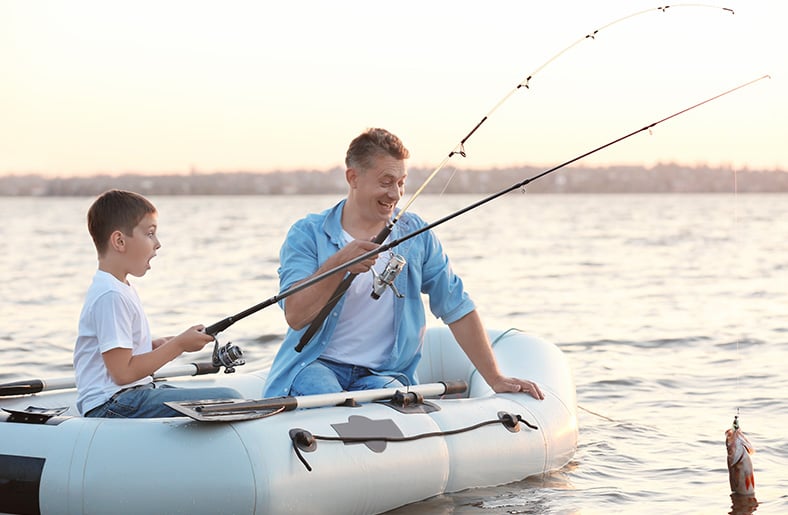
Features and Benefits of Dinghy Boat
Dinghies are versatile and affordable. There are plenty of benefits for choosing this boat beyond just the savings you make over other models.
The dinghy is one of the few boats left that offer a sailing configuration. If you’re into boating on lakes or thinking about sailing competitively, the dinghy is the best choice. Any of the sailing models listed above are a great choice. Pick the boat that offers you the best utility for your sailing needs.
Minimal Noise
Most dinghies are sailing options, so you don’t have to worry about gas fumes from the motor or noise. They offer a serene sailing experience on inland waters. Inflatable models may use a trolling engine for moving through calm, shallow waters when fishing. The low noise and churn produced by the motors won’t scare off the fish. You also have options for poling and oars for moving around without engines.
Trailerable
Dinghies are compact boats with sailing and inflatable models offering you easy trailering. Some of the smaller inflatables can fit in the back of a panel van or on the load bed of your single-cab truck. They offer you easy transport between lakes and estuaries, with a lightweight design that’s easy to launch and trailer.
Options for Inflatables or Fiberglass
As mentioned, the dinghy comes in sailing and inflatable options. Some fiberglass models also feature a wood finish on the deck for an added aesthetic that looks like a classic dinghy.
Ideal as an Excursion Boat for Yachts
Many superyachts use inflatable dinghies allowing the passengers to reach the shore. Yachts can’t enter shallow water, and the dinghy makes the ideal transfer boat for reaching the coast from open water. Most of these models feature low-powered motors.
No Need for Registration
Larger vessels require registration before you can take them out on the water. However, dinghies are small, and they don’t need any registration or licensing before you can take them out on the water. As long as the boat doesn’t have a fixed motor and is less than eight feet in length, you don’t have to worry about doing the paperwork. Regulations differ between California and Florida, so check with your local authorities before taking your boat to the lake or slip.
Lightweight
The dinghy is a lightweight boat. The fiberglass and inflatable models offer you a lightweight watercraft that’s easy to launch and pull from the water. They are also easy to repair, with basic fiberglass or polymer patching.
Easy to Maneuver
The dinghy is a super-maneuverable boat. The sailing models are easy to tack in the wind, allowing for sharp turning radiuses and easy maneuverability on the water.
Complete sailing systems
Most sailing dinghies come with options for sail systems. If you want to learn the art of sailing or teach your kids about sailboats, the dinghy is the ideal starter vessel.
Suitable for use in Shallow Waters
The dinghy usually has a high draft and a shallow keel, allowing for sailing in shallow water, such as lakes. These boats won’t run aground, and the low hull design allows for less friction on the water, increasing speed and performance.
Save on Fuel
Sailing dinghies don’t have motors, so you save on fuel costs for your boating trips. Those inflatable models with trolling motors have low-capacity engines, and they are economical with fuel consumption.
Disadvantages of Dinghy Boat
The dinghy is a great choice for your first boat, especially if you want to tackle the art of sailing. However, they do come with some drawbacks.
Minimal Power and Small Motors
Since most models are sailboats, they rely on the wind for performance. Sure, some models can reach high speeds when the winds are right, but they lack a speed boat’s torque and on-demand power. Even those dinghy models relying on trolling motors don’t move very fast.
Limited Standing Room
The sailing dinghy doesn’t offer you any standing room. Sure, you can stand on the deck, but you’ll have to duck and manage the sail, and that could mean the boat tosses you overboard. The small size of the dinghy also means that you’ll unbalance the vessel if you stand on the deck.
Limited Seating
Dinghies are small boats designed for one to five passengers. Sure, you get bigger models, but these dinghies are more like proper sailboats. The seating may also be somewhat uncomfortable, as most models rely on a cast fiberglass deck with molded seats and no cushions.
No Crossover Function
Most dinghies are for sailing, and they don’t offer you crossover functions for fishing and watersports. It’s impossible to tow a skier, and the sail gets in the way of angling. The inflatable models are okay for fishing in shallow waters or inland water bodies, but the seating setup isn’t comfortable. The low-power trolling motors available for inflatable models don’t reach high speeds, making them unsuitable for watersports.
Limited Storage Space
Most dinghy models, especially sailing types, don’t come with consoles or storage systems. Some inflatables might have storage bins in the bow of the dinghy, but they typically don’t offer much storage space.
Top Dinghy Boat Brands and Models
Intex excursion 5.
The Intex Excursion 5 is a great example of an inflatable dinghy. You can seat up to five people in this model, and it has a rubber design with all the fishing accessories you need to get out on the water and enjoy a few hour’s angling in the lake.

You get four rod-holders, a bench-style seat in the boat’s center, and two inflatable seats.
This model comes with an affordable price tag and oars included with your purchase. There’s also the option of attaching a trolling motor for effortless navigation.
However, the boat is not suitable for standing, so don’t expect to cast far with this model. The boat comes with a three-chambered design and a 1,300-lbs capacity.
The Laser is the best choice for a single-hander sailboat dinghy. This boat is ideal for cruising or competitive racing, and they hold their resale value.

You get options for three rig sizes, the 4.7, Standard, and the Radial model. These boats feature fiberglass design and low hulls for easy navigation through shallow waters.
The RS Vision
This family sailboat makes a fantastic trainer, club racer, or cruising model. This boat can accommodate up to eight sailors, and the new RS Quest model features both trapeze and spinnaker options.
Wrapping Up
Dinghies are the ideal boat for learning how to sail, and they also make inexpensive boats for recreational fishing in inland water or calm ocean conditions.
They are not the most durable boats, and they don’t accommodate many people. However, there are plenty of models to suit your sailing experience or watercraft needs. However, they offer lightweight design, user-friendly operation, and choices for inflatable or fiberglass models.
If you’re looking to learn how to sail, you won’t find a better boat available.

John is an experienced journalist and veteran boater. He heads up the content team at BoatingBeast and aims to share his many years experience of the marine world with our readers.
A Complete Guide to Micro Skiffs: All You Need to Know!
A complete guide to narrow boats: all you need to know, a guide to aluminum fishing boats.
Comments are closed.
Type above and press Enter to search. Press Esc to cancel.
Become the Confident Skipper of Your Own Sailboat
The best dinghy sailboats for all your sailing activities..
- Post author: Anns
- Post published: October 12, 2022
- Post category: Uncategorized
- Post comments: 0 Comments
Introduction
If you’re looking to go sailing, it’s important to know what type of boat you should use. Here are some of the best dinghy sailboats that can help you get started:
The Sunfish is a small, easy-to-sail dinghy that’s perfect for beginners. With its large sail area relative to its size, the Sunfish can be sailed with a single person (though it’s typically raced in pairs).
The Sunfish is incredibly popular and has been around since 1957; it’s estimated that more than 1 million have been built worldwide. In fact, many people start their sailing careers on this very boat! You can find them throughout the world: from Florida to Australia and everywhere in between.
Racing dinghies are often called “cruising” boats because they’re so much fun to sail on open water—even if you don’t plan on racing. They’re easy enough to tow behind your car or truck when you need transportation, but still fast enough for some serious action once you get out there!
The Laser is a single-handed dinghy that can reach speeds of over 20 mph. This is because it’s lightweight, making it easy to move with one hand and accelerate quickly. The Laser is also very responsive, which means you’ll feel like you’re in complete control of your boat while sailing. This makes the Laser great for racing because it will let you get ahead of your competition easily.
The best part about this boat is its versatility—you can take out family members or friends if they have never sailed before, or if they aren’t very experienced sailors!
Hobie Bravo
If you’re looking for a dinghy sailboat that is great for racing, the Hobie Bravo is your best bet. It’s easy to sail and can be handled by anyone. This boat can also be enjoyed by kids, teens, and adults alike—making it a fun option for your whole family.
If you’re looking for a dinghy sailboat, the Optimist is the smallest but most popular of all. It’s a single-handed boat that is ideal for kids to learn to sail in. The stability of this boat makes it safe even for young kids to use.
The Optimist can be used as an introductory experience or as a stepping stone towards bigger boats like the Laser, which we’ll discuss later.
The 470 is the largest of our dinghy sailboats, designed for three people. It’s just as much fun to sail with two or even one person though! The 470 also comes in a super light version that you can use with a spinnaker.
The 420 is a small, two-person racing dinghy that’s ideal for beginners. It’s also a great boat for experienced sailors looking to get into competitive sailing. With its fast hull design and lightweight rig, the 420 can travel faster than most other dinghies.
The 420 is simple enough that you’ll be able to learn how to sail it in just a few hours—but it still offers plenty of challenge as your skills improve. A well-built boat will be easy to balance on the water and responsive when handled correctly by both crew members at once.
The Snipe is a small, fast boat that is known for its maneuverability. It can be sailed by one person and is popular with beginners because it’s so easily handled. The boat will also accommodate two people for short periods of time, but because it was designed to be single-handed, having two crew on board does make things more difficult.
The Snipe is a good choice for lakes and ponds because its shallow draft allows it to skim over shallow waters (which often have rocks or other obstacles in them). This makes the Snipe especially useful as a dinghy sailing boat for racing around buoys or around markers in open water races that use buoys as markers instead of land-based marks like lighthouses or buoys tethered near shorelines.
If you want to go out sailing, here are the boats you can use.
If you’re looking to go out sailing, here is a list of the boats you can use:
Sunfish: A great boat to start on. It’s inexpensive and easy to sail.
Laser: The Laser is a one-design class dinghy that is used for racing around the world. It’s fast and stable, so it’s perfect for racing or just having fun in smooth water conditions.
Hobie Bravo: This boat has been designed by Hobie Cat Company specifically for beginners who want more freedom when sailing their boats on lakes, rivers or calm waters. They are compact enough that they can fit into most vehicles easily, making them very portable! The Hobie Bravo has an adjustable centerboard that lets you adjust the draft of your sailboat depending on how much wind there will be during your trip (or if there isn’t any). This makes it easier than ever before!
We hope you enjoyed reading about the best dinghy sailboats for all your sailing activities. We know there are a lot of options out there and we tried to give a variety of different boats so you can find what works best for where you live (or want to sail).
You Might Also Like
Best ways to explore maui on a catamaran, renowned sail yacht, leave a reply cancel reply.
Save my name, email, and website in this browser for the next time I comment.

The 5 Best Sailboats For Beginners

Last Updated by
Daniel Wade
December 27, 2023
Sailing is a fun activity for people of all experience levels. In fact, learning to sail a basic boat is relatively easy—in the right environment, you can start cruising with minimal experience.
However, the idea of a beginner commanding a 55-foot ketch in the middle of the Atlantic Ocean is a bit ridiculous. Even though virtually everyone can sail, beginners should learn the basics in a controlled environment—and on the correct boat.
Boat size doesn’t necessarily affect its beginner-friendliness, because sailors need to take into account factors such as rig simplicity and handling characteristics.
Many beginners make the mistake of picking the wrong boat to begin with, which can lead to frustration and turn them off of sailing forever.
To mitigate these issues, this article will cover the best sailboats for beginners —so you can get on the water and start sailing safely and comfortably.
Table of contents
Best Rigs for Beginners
There are many types of sailboat rigging , and some are more beginner-friendly than others. Unfortunately, some of the most aesthetically pleasing rigs are also the most complicated.
Eventually, sailors can acquire enough skill to master complex rigs, but it’s best to start simple.
Arguably, one of the simplest sailing rigs is the Lateen Rig. This rig consists of a mast, boom, and spar, along with a single halyard and mainsheet. With only two ropes in its simplest configuration, the Lateen Rig makes an excellent starter sailboat, and it will be featured on this list.
For larger boats, the Bermuda Sloop rig is an excellent choice. This rig is quite common and includes a jib for a larger sail plan.
For those who desire a slightly more robust (but single sail) layout, the gaff-rigged catboat is also an excellent choice. This versatile craft (and rig) has a large and relatively simple single sail, which is easier to handle than multiple sails.
Top Five Sailboats for Beginners
Now, we’ll go over the top five sailboats for beginners . These boats will descend in order from smallest to largest, but not by the level of experience needed.
Remember, just because you’re new to sailing doesn’t mean you have to settle for a boat that’s too small. Beginners can handle larger boats with some training, and some are easier to handle than their smaller counterparts.
The following boats were chosen because of their handling characteristics, low cost-of-ownership, and simplicity, as all of these factors are important for choosing the best beginner sailboat.
5) Sailing Dinghy
The sailing dinghy is the quintessential starter sailboat. These tiny, lightweight, popular, and highly affordable little craft is easy to operate and relatively difficult to capsize. The popular Optimist Sailing Dinghy, while designed for children up to the age of about 15, can be used (sometimes hilariously) by adults as well. An Optimist-style dingy is a great option for beginners over the age of 15, as boats of this style can be found in a variety of sizes. The sailing dinghy is a very popular youth racing sailboat, especially in the United States and the United Kingdom. While it’s not particularly fast, this little boat has wonderful handling characteristics and is relatively difficult to capsize. This open-cockpit boat uses a centerboard and detachable tiller and can be beached or carried atop a car without much hassle. The mast is removable, and all parts are easily stowed. Overall, the Optimist and its copycats are a remarkable little craft, equally useful as a tender for a larger boat or a standalone beginner sailboat.
Dinghy rigs vary between builders, but many use the simple Spirit Rig. The rig consists of a single sail and mainsheet, along with one mast, boom, and spar. The leech is stiffened by battens, and ties along the luff secure it all to the mast. Hoisting and securing the rig is easy, and lines are secured to the boat by a cleat. This simple rig has plenty of sail area for most places, and sailors can secure the mainsheet to a block or simply hold it in their hands.
The price of sailing dinghies can vary widely depending on multiple factors. Professionally-made sailing dinghies start around $3,500 new, and plywood kits are available for around $1,000 to $2,000. Used dinghies (including Optimist sailing dinghies) can be found on Craigslist for as low as a few hundred dollars.
{{boat-info="/boats/vanguard-sunfish"}}
The Sunfish is a brilliant little sailboat, and a very fast boat indeed. This little racing dinghy, while only 13 feet in length, can be an enormous amount of fun for beginners and experienced sailors alike. The best way to describe the handling of a Sunfish is, ‘tender,’ though it’s not difficult to master this little boat. For its size, the Sunfish has a relatively large sail area and a very shallow draft. This boat has a small cockpit and can be controlled easily by a single person. The large sail plan of the Lateen-Rigged Sunfish makes for excellent performance in light winds and amazing speed on windy days. The Sunfish is a lightweight fiberglass boat with a simple rig and is a great step-up from a sailing dinghy. It’s possible to learn how to sail on this boat, but every sailor who’s spent time on a Sunfish will probably recommend bringing a towel. The boat is relatively easy to capsize for beginners and it heels aggressively, but these characteristics can teach sailors some important lessons. The heeling characteristics of the Sunfish can help beginners get accustomed to the feeling and help them understand the limits of a sailboat and how to avoid capsizing.
The Sunfish features a Lateen Rig, which has some shared characteristics with the simple Spirit Rig. The Lateen Rig has a single spar, mast, and boom, and is easy to set up and dismantle. The mast is removable as well, making stowing and transportation relatively easy. The large sail plan of the Sunfish makes it ideal for lakes and other areas where the wind is sporadic or very low, and the boat can be safely handled in many conditions. The boat is great for racing and learning and is also available in a Bermuda rig. The Sunfish is recognizable by the distinctive fish logo in the top corner of the sail, and the classic rainbow sails striping.
The Sunfish is still commercially manufactured. You can purchase one new from the factory for around $5,000 today, and options are available to make the boat your own. While the boat is designed to be sailed by a single person, two adults can purchase this boat and use it together comfortably. Used Sunfish prices vary, but a fully-outfitted boat in good condition can cost upwards of $1,000. They hold their value well, and they’re a great choice for beginners.
{{boat-info="/boats/vanguard-laser"}}
The Laser is considered by many to be the Sunfish’s main competitor. The two boats are the same length (13 feet 9 inches) and share many of the same handling characteristics. However, the boats do have some notable differences. Many people consider the Laser to be a step-up from the Sunfish in difficulty, as the boat handles much more like a racer. The Laser has been used in the Olympics for racing. The laser is small and simple enough for beginners but requires skill to operate. Beginners can learn a lot from sailing a Laser and have an enormous amount of fun in the process. This fast little boat is simple and easy to set up but handles like a racecar. If you’re a beginner on a laser, you’ll probably capsize at some point—which isn’t always a problem if you’re in a controlled environment, as the boat can be righted easily.
The laser is a Cat Rigged boat. This means it has only one mainsail and no headsails. The simple rig has a mast and a boom and is very easy to set up. The sail area of the laser is relatively large and designed for speed in high winds. The rig combined with the overall design of the sailboat makes it handle tenderly, which may be off-putting to some beginners. Regardless, it’s still a blast to sail for beginners with some experience.
New Laser sailboats start around $6,000 which is slightly more than the Sunfish. This simple centerboard cruiser is constructed as a race boat, which can explain some of the price increase. Used Laser sailboats are available on the market, though usually not as common as the Sunfish. Used Laser prices vary widely.
2) Gaff-Rigged Catboat
The gaff-rigged catboat isn’t a brand of boat—it’s a style of a sailboat that was once a popular workboat on the New England coast. This boat, which has only one mainsail and no headsails, is available in a wide range of designs. Catboats are famous for their handling and power and make a great sailboat for beginners. These vessels are available with centerboards, keels, cabins, and in open designs. Most catboats range from 15 to 19-feet long and can be built from wood or fiberglass. Catboats are easy to handle, and one who learns on a small catboat can easily transition to a larger one. Besides being one of the most easily recognizable sailboats, catboats are also some of the most versatile. A catboat can be just as suitable for lake cruising as it is for coastal waters.
The most common type of catboat rig is the Gaff Rig. This classic and robust rig is more complex than the simple Spirit and Lateen rig, but it’s more suitable for a ‘proper ship.’ The Gaff Rig can provide similar power as an equivalent Bermuda Rig, with much more elegance and a shorter mast. Many sailors prefer the classic Gaff Rig for its handling characteristics and durability.
It’s impossible to specify the price of catboats because they vary so much in design and size. New catboats (between 15 and 25-feet) can be purchased for less than $20,000, and used boats are numerous and varied. Cabin catboats tend to cost more, especially new—some run for more than $50,000 with a high level of amenities, including a head and galley. Numerous catboat plans are available online, and sailors report constructing them (usually of plywood) for just a few thousand dollars.
1) West Wight Potter 19
{{boat-info="/boats/west-wight-potter-19"}}
The West Wight Potter 19 is a fiberglass sailboat designed for safety, easy handling, and beginner-friendliness. This 19-foot trailer-sailor features a cabin with a vee-berth, a simple rig, and a retractable keel. The West Wight Potter 19 could potentially be the best cabin sailboat for beginners, and certainly one of the safest—the West Wight Potter 19, according to the manufacturer, is quite literally unsinkable. The hull is filled with buoyant materials, allowing the boat to be flooded and remain afloat. However, unsinkability isn’t the only characteristic of this boat that makes it ideal for beginners. The rig is simple and easy to set up, and the handling characteristics are excellent. The boat is not prone to aggressive heeling and handles confidently in a variety of conditions. While one generally wouldn’t consider it to be a blue-water cruiser, it’s still extremely capable—one sailor even sailed this vessel from California to Hawaii , which is over 2,000 nautical miles. The theoretical hull speed of this boat is around 5.4 knots, but it actually has a tendency to plane and achieve higher speeds. It’s a flat-bottomed cruiser, making it easy to beach and transport with its retractable keel and removable rudder. The West Wight Potter 19 is a great introduction to large sailboats and carries amenities normally reserved for boats at least 1/3 larger.
The West Wight Potter 19 is a Bermuda-Rigged sloop. The sail plan is sufficiently large to propel the boat in a variety of conditions, but not so large that it overpowers the boat. Sailors can single-hand the boat with ease, and set up and takedown are easy and require no special tools. The boat handles well in a variety of conditions and is well-known for its superior stability. The rig comes apart easily and can be stowed and trailered by one person.
The West Wight Potter 19 has been produced and sold commercially since the 1970s, and the used market has plenty of boats available, generally starting around $5,000. New West Wight Potter 19 sailboats are remarkably affordable compared to other boats with comparable characteristics. The West Wight Potter 19 is manufactured by International Marine in California. New sailboats start at just shy of $25,000. Owners can add an enormous range of extra features to their boats, including a hull-strengthening ‘blue water’ package, a stove, a head, electrical power, spare parts, and much more. The boats are highly customizable and can be outfitted for weekender sailing or long-term liveaboard cruising.
How to Pick a Sailboat
Picking a sailboat for beginners doesn’t have to be difficult. Before deciding on a boat, consider your experience level and location.
If you only have access to rough ocean, it may not be the best idea to get an open dinghy.
If you live near a lake, a Sunfish could be a great way to start.
Also, consider your budget. If you’re looking for a $50 sailboat, you can probably find one, but it won’t be ideal.
If you have just a few thousand dollars to spend, you can set yourself up nicely with a little research .
Also, consider what you want to do with the sailboat. Recreation, fishing , cruising , and exploration are options, and require different kinds of boats.
Whichever you end up choosing, make sure you try it out and can sail it comfortably.
Related Articles
How To Buy A Beginner Sailboat
Sail Maintenance For Beginners
Can a Novice Sail Around the World?
I've personally had thousands of questions about sailing and sailboats over the years. As I learn and experience sailing, and the community, I share the answers that work and make sense to me, here on Life of Sailing.
by this author
Best Sailboats
Most Recent

What Does "Sailing By The Lee" Mean?
October 3, 2023

The Best Sailing Schools And Programs: Reviews & Ratings
September 26, 2023
Important Legal Info
Lifeofsailing.com is a participant in the Amazon Services LLC Associates Program, an affiliate advertising program designed to provide a means for sites to earn advertising fees by advertising and linking to Amazon. This site also participates in other affiliate programs and is compensated for referring traffic and business to these companies.
Similar Posts

Affordable Sailboats You Can Build at Home
September 13, 2023

Best Small Sailboats With Standing Headroom
December 28, 2023

Best Bluewater Sailboats Under $50K
Popular posts.

Best Liveaboard Catamaran Sailboats

Elizabeth O'Malley
June 15, 2022

4 Best Electric Outboard Motors

How Long Did It Take The Vikings To Sail To England?

10 Best Sailboat Brands (And Why)
December 20, 2023

7 Best Places To Liveaboard A Sailboat
Get the best sailing content.
Top Rated Posts
Lifeofsailing.com is a participant in the Amazon Services LLC Associates Program, an affiliate advertising program designed to provide a means for sites to earn advertising fees by advertising and linking to Amazon. This site also participates in other affiliate programs and is compensated for referring traffic and business to these companies. (866) 342-SAIL
© 2024 Life of Sailing Email: [email protected] Address: 11816 Inwood Rd #3024 Dallas, TX 75244 Disclaimer Privacy Policy

Basic Guide for Dinghy Sailing – Must Have Gear and Tips For Beginner Sailor
Start your dinghy adventure by reading this guide for dinghy sailing . Learn everything you need to know before you start your new journey.
Dinghy sailing is an activity based on the five essential controls. The sails, foils, trim of the boat, the dingy’s balance on the windy weather, and the predetermined routes are the main important things to control. The term “dinghy” came from East India and referred to a rowing boat that is used to sail on India’s river.
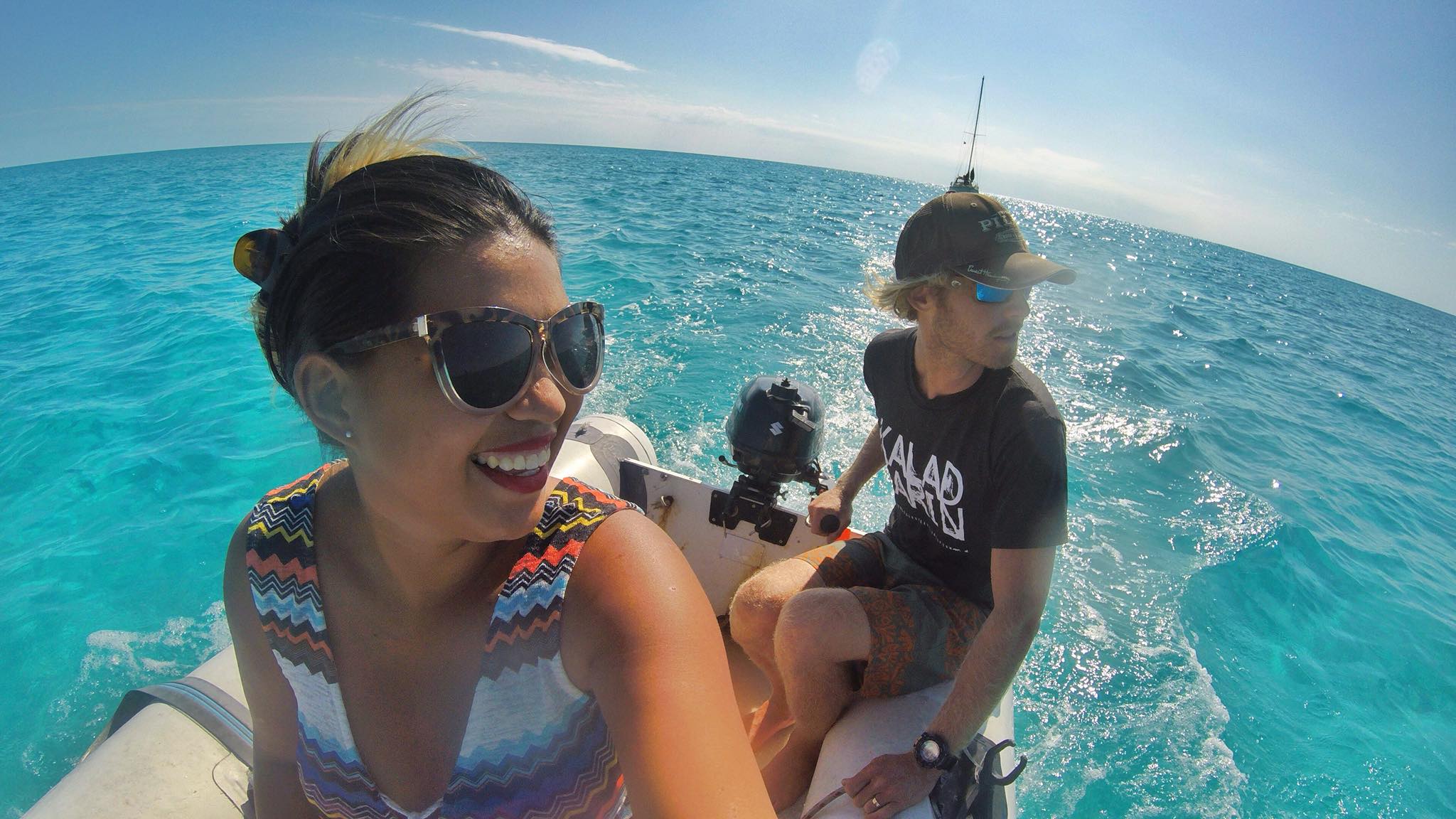
Before trying dinghy sailing , you need several things to prepare.
Other articles you can read:
- Learning to Sail in Turkey – RYA Sailing Courses in Turkey
- Your 20 Must-Have Sailing Clothing before You Sail!
- Satellite Phones for Sailing
- Tribit and iClever : The Perfect And Powerful Sailing Companions
- Our Travel Guide To Brac Island, Croatia – Sailing and Staying at Orvas Villas
Table of Contents
Choosing the Right Dinghy
To choose the right dinghy for you, you need to learn about the different types of dinghies. Based on performance and usage.
High-Performance Dinghies
As referred to the name, this dinghy boat has high performance, which is fast and powerful and designed for sailing at the most prestigious regattas. It has high maneuverability, even upwind since it’s usually equipped with a spinnaker. The International 505, the fireball, and the Thistle are the few names of a high-performance sailing dinghy.
Racing Dinghies
As the name suggests, this type of dinghy boat is designed for competitive racing. However, unlike the high-performance dinghies, not every racing dinghies offer the same level of performance. It needs the help of the crew and great tactics to optimize its functions. The most knowledgeable racing dinghy is “the Snipe International” which has accessibility for all kinds of sailors and its adaptability to the most weather conditions.
Cruising Dinghies
This type of dinghy boat is one of the most popular types to use for recreational purposes. It’s a lot more stable, which makes it suitable for leisure sails or someone who wants to learn the ropes. The dinghy is generally a lot smaller than other sailing dinghies to make it easier to handle. The hull is less rounded to make it steadier. The most popular name of cruising dinghy is the Wayfarer, which is mostly made from wood or fiberglass. The size is quite long and deep enough for three adults to comfortably sail for several hours.
Cruiser-Racer Dinghies
This type of dinghy is quite similar to the cruising dinghy but with several performance differences. It is designed for race sailing that offers a high performance yet very stable for cruising. The GP14 is one name of the most popular cruise-racer dinghy that can perform to a very high standard in racing, while also lending itself to stable cruising if required.
Classic Dinghies
This boat is different from the other dinghies. The versatility emphasized over actual sailing performance. Originally constructed from wood, but nowadays, many classic dinghies are manufactured from fiberglass and a little touch of wood to achieve the classic look. The Minto is one of the few names of the classic dinghy, which is the most recognizable classic dinghies.
Choosing the Proper Clothes
Dinghy sailing shouldn’t use random outfits. You need to consider the weather since it’s quite significant and crucial for dinghy sailing. Knowing the exact weather can help you to pack the proper clothes. Generally, the sea is more windy and cooler than the shore, so you need a pair of gloves to keep your hands warm, a pair of reliable shoes such as water shoes or boots, and the proper fabric of garments.
When the weather is windy and cool, you can use a diving suit or other warm fabric. Do not use a swimsuit/diving suit on sunny days since it will be very uncomfortable due to its thickness, which will make you sweat a lot.
Details and Pro’s and Con’s of Each Product
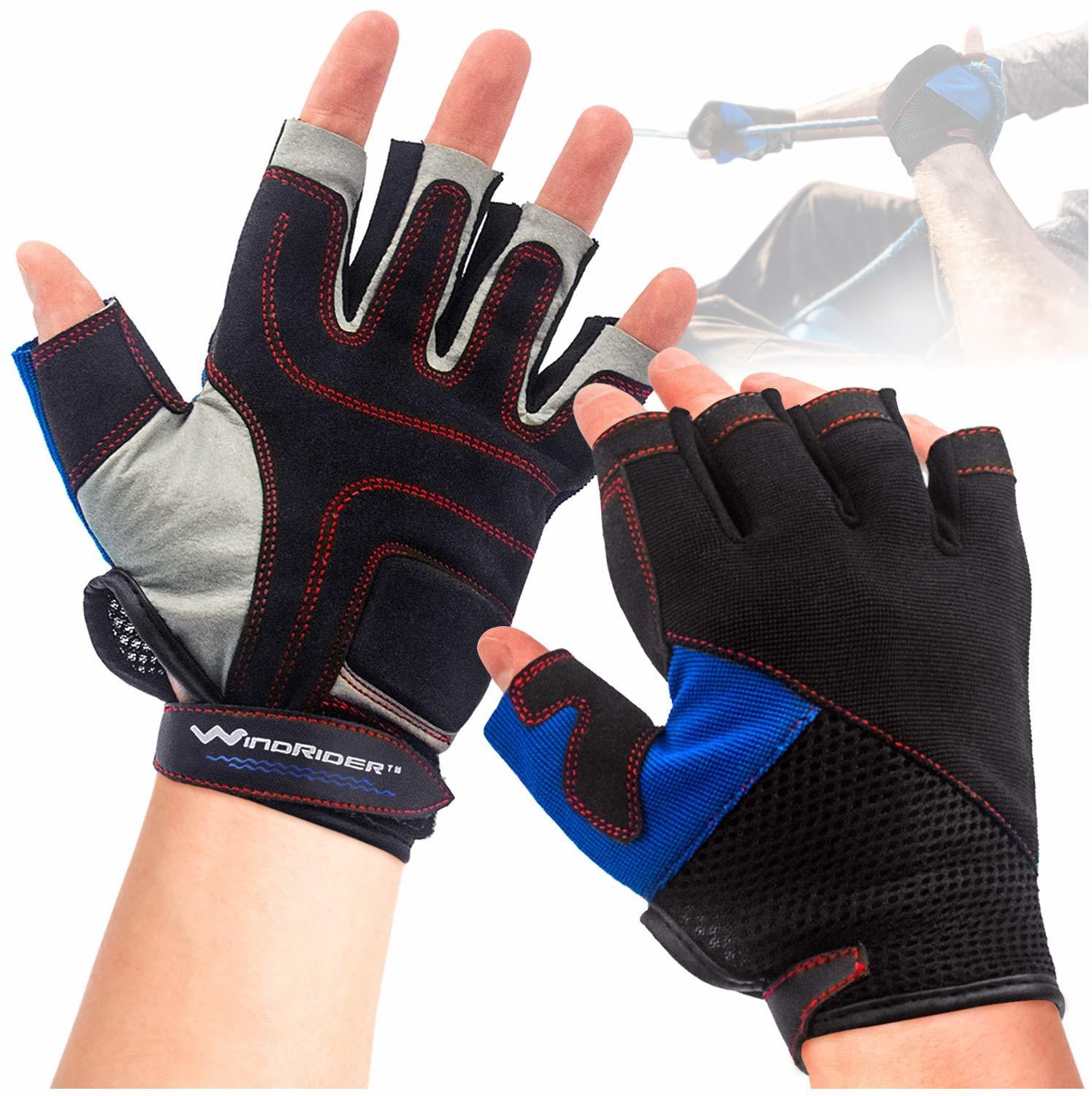
A pair of gloves is needed to protect your hands and fingers while sailing. Making direct contact with water regularly can also make the skin of your fingers and hands tangled. For this reason, gloves are an essential thing while doing water sports. Moreover, the weather in wild nature sometimes is very extreme. The gloves can protect you from all types of weather.
There are two types of gloves with different protection, those are fingerless gloves, which half of your fingers are free exposed and full finger gloves that will give you maximum protection since it’s covering all of your palms. One of the best sailing gloves that you can choose is provided by the WindRider , which is providing a glove with a premium design that will improve users’ confidence. It’s made from lycra spandex and has an excellent grip and protection that is comfortable for your hands. This glove is perfect for sailing, paddling, canoeing, wakeboarding, and other water sport activities. The gloves have both types that you can choose based on your preference and necessity.
- Lightweight, stretchy, breathable and easy to dry.
- All-day UV protection.
- Extra padding under the fabric.
- Superb durability under all kinds of weather.
- ¾ design is suitable for fishing.
- Best used to relax during water sport, not in the competition.
- Pay attention to the size carefully.
2. Water Shoes

Water shoes are suitable for activities such as water sports, hiking, and trekking. It fully covers your toes, unlike the sandals. It’s also not too stiff, unlike the water boots. When you’re participating in water sports, comfort has to be the priority. Once the shoes get wet, your feet have to deal with the wet shoes all day and it’s uncomfortable. Water shoes with a quick-drying feature will be the best option.
One of the best water shoes that you can wear is from SIMARI. They provide sports shoes with a unique design that is suitable to use for any beach sports, fishing, swimming, surfing, sailing, kayaking, yoga, and other occasions. The upper shoes are made from 92% polyester that breathable, lightweight, durable, and quick-to-dry. While the soles are made from rubber that is tough enough to use in rocky areas. It has a unisex design with a wide range of sizes that you can choose.
- Easy on and off.
- Ergonomically molded soles with 8 holes as drainage.
- Anti-slip, anti-scratch, and stab-resistance.
- Easy to carry and portable.
- Not recommended to dry it near fire-place.
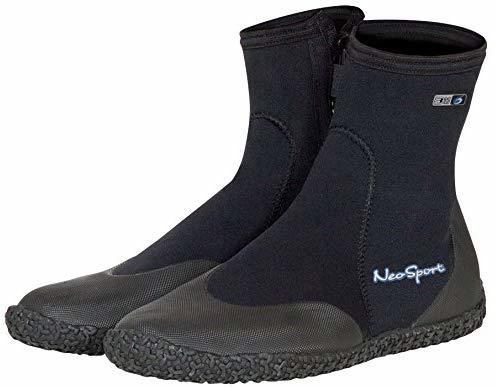
As for boots, there are two types of boots based on the height that you can choose, that is ankle high and knee-high boots. There are several things you need to consider before purchasing boots, such as the grip, snug-fit, and quick to dry features.
Neo Sport provides boots made from neoprene with puncture-resistant sole and thermal protection. It’s suitable for any water activities and equipped with tough zippers. The available thickness is 3mm for warm water, 5mm for moderate water, and 7mm for cold water. The boots are suitable for both adult men and women.
- Durable construction with thermal protection.
- Easy on and off the zipper.
- Suitable to use in cold water to warm water with different boots’ thickness.
- Large size range from 4 to 16.
- No fins holder.
- Double-check the size before purchasing.
4. Diving Suit
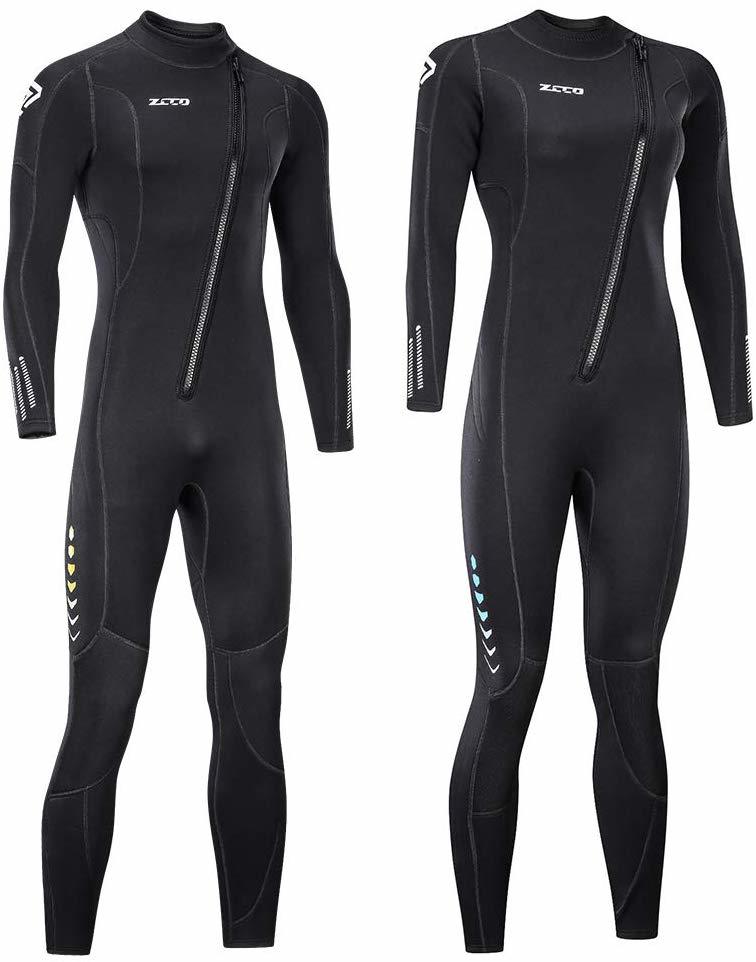
A diving suit is needed for you who wants to go sailing using a small boat. It is mostly made from neoprene that will prevent your skin from getting exposed to the water. With minimum contact with the water, you can keep your temperature warm.
ZCCO provides a full-body wetsuit that’s suitable to use for diving, snorkeling, and sailing. The wetsuit is made of neoprene and has unisex design and size. It has strong sewing-overlapped sewing to make sure that the diving suits are sturdy. More protection for your body is offered by featuring an anti-abrasion knee pad made from a very strong nylon pad.
- Ultra-stretch 3mm thick neoprene which is also sturdy and durable.
- Easy to take off or put on with 4 small zippers at the arms and legs.
- Leak-proof with water stop seal feature.
- Equipped with an anti-abrasion knee pad for better protection on your knee.
- The tighter you wear, the warmer you’ll be in the water.
- Make sure to properly measure your body to get the fittest diving suit.
- The zippers generate a very minor leak.
5. Sailing Jacket
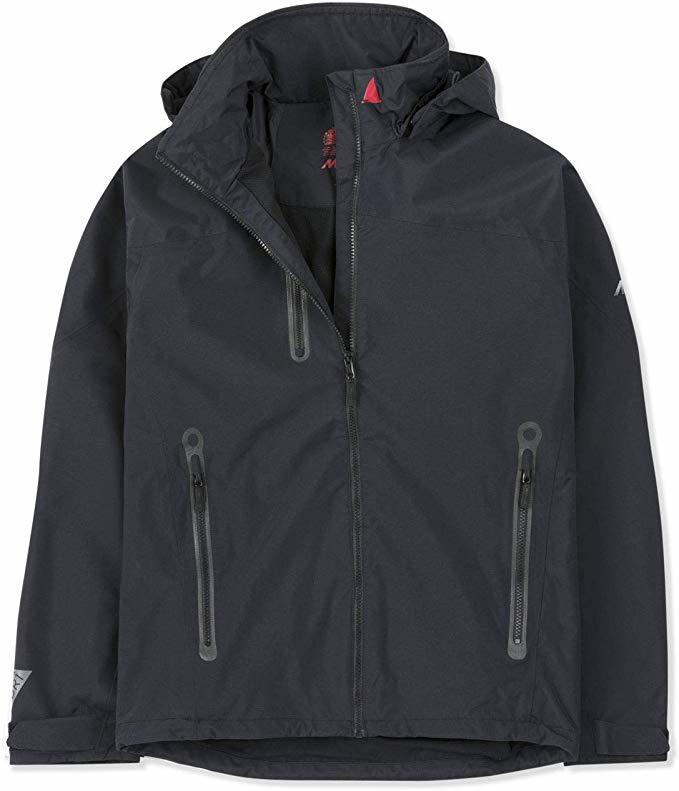
To add more protection and to keep your body warm, a sailing jacket will never be wrong. It does not only keep you from chilly and windy days but also keeps you from direct exposure from the harm UV-rays.
As an option, Musto provides a sailing jacket series BR1 Men’s Sardinia Inshore. It’s fully taped for 100% waterproof protection, polyamide shell, and polyester mesh lining to increase the air circulation to add comfort. The jacket’s equipped with external zippered pockets and a YKK Vislon main zipper with protective roll-over zip guard.
- Fully breathable fabric, making it suitable to use for sailing in warm climates when you encounter rain and spray.
- Featuring removable fold-away hood with two-way adjustment and stiffened peak.
- Adjustable cuff tab fastener made of molded rubber.
- Equipped with articulated sleeves and underarms which offers improved mobility to increase performance.
- Available in sizes XS to XX-large with various color options.
- Not delivering to some countries.
Additional Features
There are so many additional features that you can consider to use to ease your dinghy expeditions. That includes the buoyancy , oars or paddles , and launching wheels.
Buoyancy is crucial to pack no matter what kind of boat you use for sailing. Even though you have a very high skill in swimming, buoyancy is important. You can use several types of buoyancy, such as a wearable buoyancy or the regular one. The PFD is one of the wearable buoyancy that you can choose. It’s very helpful for snorkeling or emergency condition, inflatable buoyancy, or other.
6. Oars / Paddles
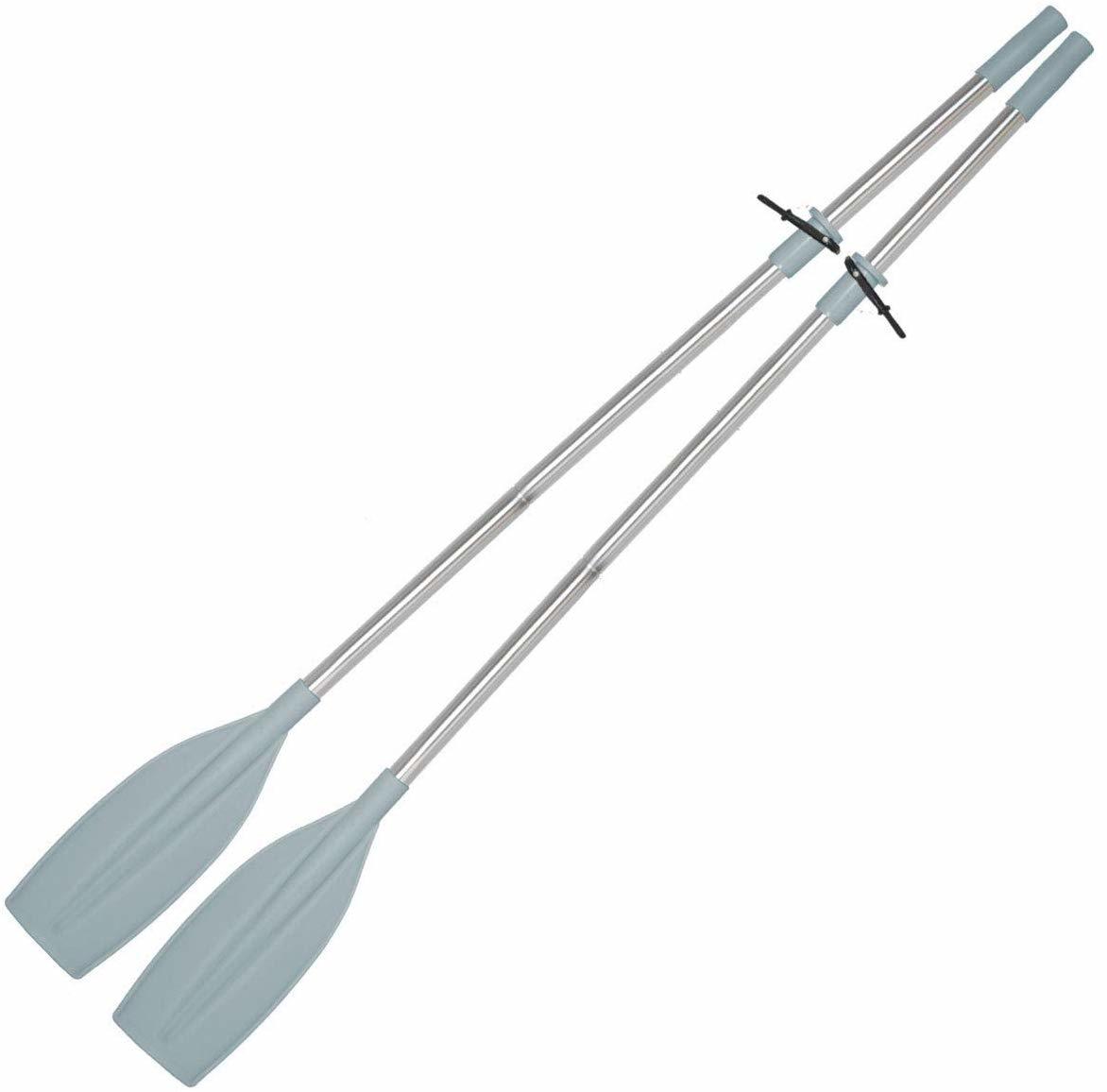
One of the most essential parts of dinghy accessories is the oars. Without the oars, you can hardly navigate your dinghy or move it faster. The oar has to be wide and flat at the endpoint. Unlike the kayak’s paddle that has a blade on both endpoints, oar only has a blade on one endpoint.
Oceansouth provides oars that come in a package of 2-piece detachable aluminum oars that are convenient and easy to store. It’s also very durable and sturdy. The handle is quite long, with 78 inches/ 2.2-meter length. The blades are made from engineer grade glass filled with polypropylene and are equipped with UV protection on the grip and oars endpoint.
- Two-piece design for convenient storage.
- Supplied in pair with oarlocks.
- Bright dipped aluminum tube handle.
- Lightweight and floatable.
- Didn’t come with oarlock pins.
7. Launching Wheels
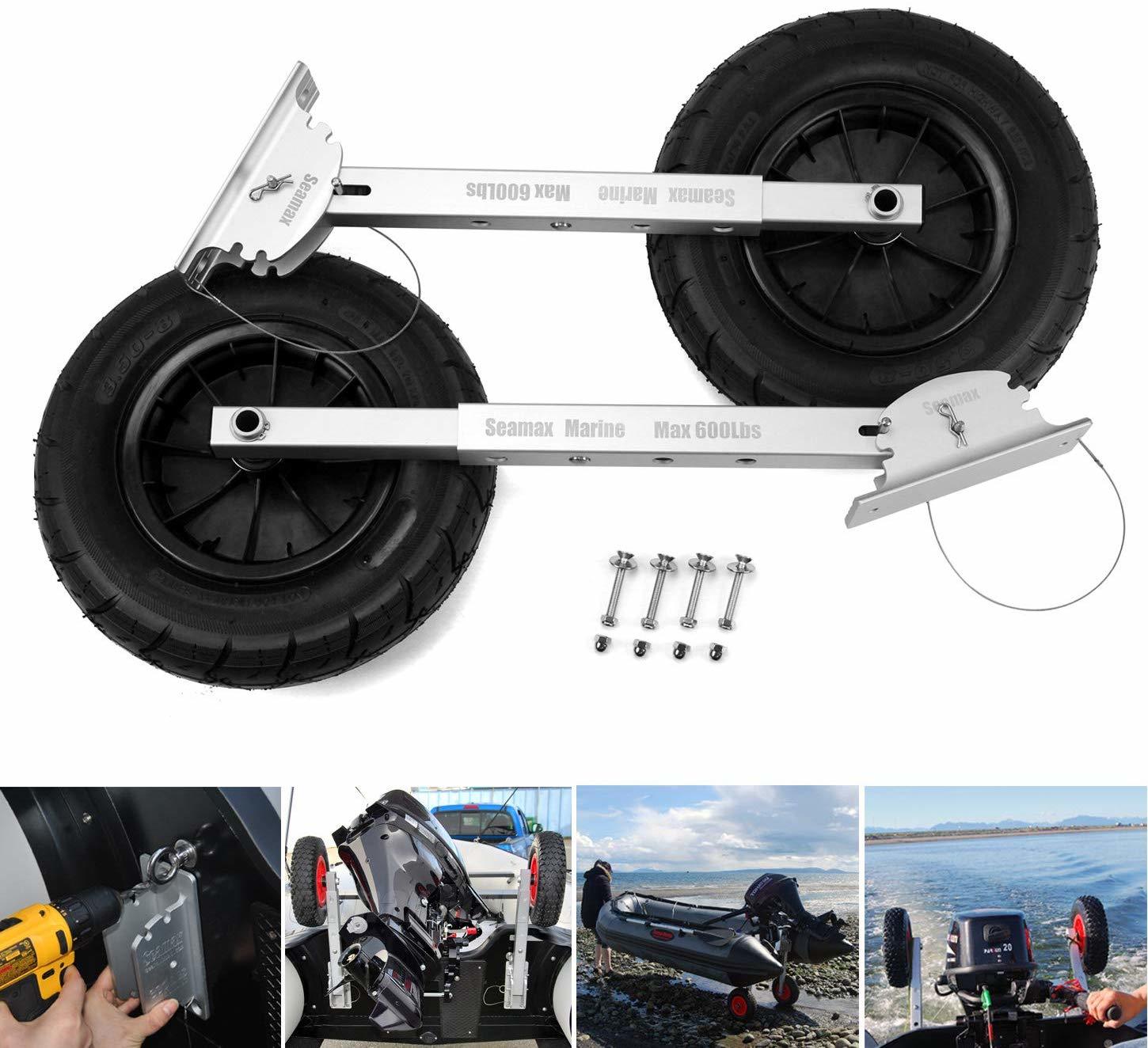
Dinghy wheels are usually constructed as a boat launching system, which is a set of wheels to help you launch your boat and transport it. Mostly it is used to move your dinghy from your car or trailer in the harbor or parking lot down to the water.
The launch wheels are usually installed on the transom of your dinghy. By installing this gear, you can easily transport your boat from and to land without much effort. You can also prevent your boat from getting damaged, such as scratched during the dragging back and forth throughout various surfaces.
Seamax provides deluxe launching wheels made from the strongest marine grade T6 aluminum alloy with CNC processing and is suitable to use in any water, even salt water. The small parts are constructed from stainless steel. The wheels’ diameter is 23 to 30 inches, and the maximum recommended load is 600 lbs in all conditions. It’s suitable to use for inflatable, aluminum, and fiberglass boats. The launcher has 4 stages of length and 4 wheel arm position. The dolly can be adjusted, while afloat in the boat leaving or coming into.
- Anti-rust material even for saltwater usage.
- Adjustable dolly while afloat in the boat leaving or coming into.
- Lightweight and sturdy.
- Easy to maintain.
- Large maximum load up to 600 lbs, including the boat and all gears.
- It’s hard to install for beginners.
Outboard Motor Parts
To make it easy for you to row, you can install outboard motor parts on your boat. The motor that is equipped with handle is more preferable since it will help you to handle the boat properly. Different motors feature different tiller handles, each design will make your sailing easy and comfortable.
Dinghy Anchor
An anchor is a crucial accessory. To choose the most suitable anchor, you have to understand the conditions of the area where you want to anchor your boat. The depth is determining the length of the anchor chain you’ll need.
You need comfortable seats since you’ll be spending a lot of time in your dingy boat. The proper seat will give you access to control and row your boat in a better way. You can choose inflatable, wood, or aluminum seat, but make sure that the cushion and backrest are comfortable enough for your body.
Dinghy Repair Kit
Dinghy repair kit consists of inflation pumps (whether manual or electric), inflatable bottom paint, boat cleaner / UV protection, keel guards, PVC, adhesives, tear-aid fabric, fastener kit, etc.
That was the basic point of dinghy sailing that you have to consider before you decide to try dinghy sailing. Regardless of those important points, your comfort and safety have to be the number one priority whether you’re sailing in a smaller boat or larger boat.

Are you on Pinterest? Pin these!
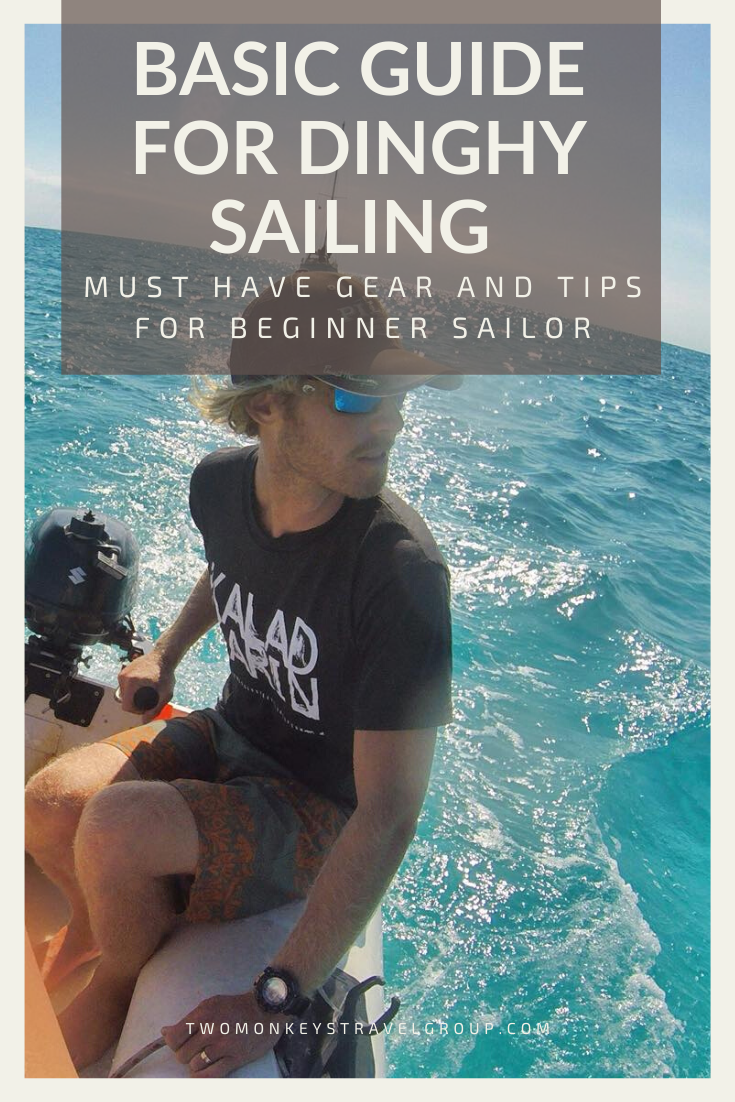
Leave a Reply Cancel reply
Your email address will not be published. Required fields are marked *
This site uses Akismet to reduce spam. Learn how your comment data is processed .
COPYRIGHT DISCLAIMER: Many of the articles on Two Monkeys Travel Group are guest posts by a number of Approved Contributors and are hosted by Two Monkeys Travel Group. Approved Contributors control their own work and post freely to our site. This includes all text and images that they use within their own work. All contributors are instructed to follow internationally recognised copyright and intellectual property guidelines. Two Monkeys Travel Group takes its own responsibilities very seriously, so if you feel that any part of this work is abusive in any way, please send us an email so that we can investigate - [email protected]
DISCLOSURE: Please note that some of the links above are affiliate links. So when you make a purchase we sometimes make a small commission, at no extra cost to you. The cost to you remains the same, sometimes even cheaper if we have negotiated a special deal for our readers.We use all of the companies we have listed here and that’s why they are in this list, but of course we need to keep Two Monkeys Travel Group running as well as it can, which is exactly what you’re helping with if you do decide to buy or book something through an affiliate link! If you have any more questions about the companies we use or any other companies you’re looking at, just email us and we’ll be happy to help. Please see our full disclaimer page for more information.
Written by Two Monkeys Travel - Contributor
Two Monkeys Travel Group – Community Travel Blog is a travel blog and website. We quickly grew into a valuable source of inspiring travel stories, advice, itineraries and travel guides, with the aim of demonstrating how to live a sustainable life of travel, whilst living your own definition of success. If you'd like to contribute and write a guest post, contact us at [email protected]
How to Find the Best Hotels in New York?
Top california destinations for families to enjoy, scuba diving and snorkeling in the philippines, what are the benefits of booking flight tickets in advance, unforgettable moments: maximizing your monaco vacation, related posts, sailing sv empress – how we bought our first live-aboard sailboat, top 8 kayak covers to protect your boat for outdoor storage, top 8 best dinghy wheels – best boat launching wheels, best liveaboards and scuba dive trips in galapagos, ecuador, previous post, 7 awesome things to do in lisbon, portugal [with suggested tours], british citizenship: guide on applying for a uk passport, subscribe to our newsletter.
Receive tips on how you can live a sustainable long-term travel lifestyle!
- First Name *
- Email This field is for validation purposes and should be left unchanged.
More From Forbes
Sail with ‘the love boat’ famous original tv cast on princess cruises.
- Share to Facebook
- Share to Twitter
- Share to Linkedin
Feeling the love? Seas the day and time travel to yesteryear with future-forward Princess Cruises , when the original cast of TV’s iconic The Love Boat show—which aired for a decade on ABC; now streaming on Paramount Plus , Apple TV+ and other channels—sets sail from New York City on a round-trip voyage that anchors at picturesque ports in New England and Canada aboard the Enchanted Princess, August 31 - September 7, 2024 .
Original cast of The Love Boat.
This romance-themed rendezvous reunites actors Jill Whelan (whose role as Vicki Stubing, the ship captain’s daughter, was delightful), Bernie Kopell (as Doc), Fred Grandy (as purser Gopher) and Ted Lange (as bartender Isaac). They will interact with passengers at multiple events: a jubilant sail-away; a meet-and-greet, photo-and-autograph session; guests’ activities replete with prizes; and Q&A gatherings. There will also be a symbolic renewal of passengers’ wedding vows, officiated by the cast, with commemorative certificates.
Princess Cruises arranges wedding vow renewals.
In addition, classic comedy-drama episodes of The Love Boat will be shown at its Movies Under The Stars program outdoors on a gargantuan screen. The Love Boat trivia contests will be cheered. And cocktails to complement The Love Boat vibe will be toasted. Ezra Freeman, Princess Cruises’ real-life bartender who starred on The Real Love Boat —a reality-dating series that premiered on CBS in 2022; now streaming on Apple TV+ and Amazon Prime —will join this spirited celebration.
One Of The Best Shows Ever Made Lands On Netflix Today For The Very First Time
Trump posts 175 million bond thanks to billionaire don hankey, apple just released a major upgrade for samsung galaxy watch 6, pixel watch.
The Reel Thing: Movies Under the Stars poolside.
The Love Boat: A Top Travel Influencer
This popular series (from the 1970s and ‘80s) introduced millions of American TV viewers to cruising, propelling the rise of passenger ships by showcasing life on the high seas as a fun, festive, fashionable, family-friendly and romantic vacation choice. It transformed travel horizons. Episodes spotlit a lively array of well-known guest-star celebrities. Story lines varied, but plots always concluded happily, further solidifying its audience draw. Now in worldwide syndication, reaching more than 90 countries, original The Love Boat episodes have been translated into more than 30 languages.
Ship-Shape Interview: Jill Whelan
Actor Jill Whelan, who is now a Celebrations Ambassador for Princess Cruises, and I talked about her passion for sailing.
Laura Manske: Two years ago, Princess Cruises orchestrated its first The Love Boat theme reunion, which sailed the Mexican Riviera. There continues to be strong sentimentality for its original cast.
Jill Whelan: Anytime I get together with my cast mates, it’s like coming home because we’re family. I truly mean that. This will be our second theme cruise since 2022. We were all touched and overwhelmed by the incredible response from guests. Nostalgia for the show still gets people excited. Princess was the ocean-going co-star of The Love Boat. That is unique.
Manske: Your key anticipated moments with passengers ahead?
Whelan: Well, certainly our cast reunion in the Princess Theater, when we will share our favorite memories, laugh a lot and take questions from the audience. The renewal of vows we host is also incredibly sweet. So many couples renew their love for one another on The Love Boat . We get to play a part in their special day.
Jill Whelan (as Vicki Stubing) with the late Gavin MacLeod (as Captain Stubing), her TV dad.
Manske: You starred on The Love Boat aboard the Pacific Princess from the age of 11 onward.
Whelan: I was so young. Gavin MacLeod welcomed me with open arms and such warmth and love, as I was playing his daughter. Remember, I was coming into an already hit show and I was the youngest. So romance wasn’t a cornerstone of my storyline just yet. But Gavin made me feel at ease, as did all of the cast members. I remember trying to take it all in, learn from everyone who came on set and appreciate the places we visited on our Princess cruises.
Manske: How did the show influence your views about romantic love as a teen growing up with this series.
Whelan: I did have my first kiss on The Love Boat . Let’s just say it wasn’t as magical as I’d hoped. As Gavin always said: ‘The show gave people something to dream about.’ I did fall in love with the romance of the sea and connecting with people on vacation. I guess as any teenager would, I did have fantasies about falling in love and sailing off into the sunset. And that did happen for me when I met my husband, Jeff, in 2016. We can’t cruise enough these days. We absolutely love it!
Manske: Share something, perhaps surprising, that brings you joy.
Whelan: Many of the Princess ships’ horns play The Love Boat theme song. I hear people singing the theme song when I’m onboard—and it makes me smile.
Enchanted Princess.
The 3,660-passenger Enchanted Princess ’s round-trip reunion itinerary from New York City includes days in Newport, Rhode Island; Boston; Rockland, Maine; Saint John, Canada (for the Bay of Fundy); and Halifax, Canada.
The Love Boat reunion trip embarks and disembarks in New York City.
- Editorial Standards
- Reprints & Permissions
San Diego resident last seen swimming to boat in choppy seas found dead off coast of Tijuana
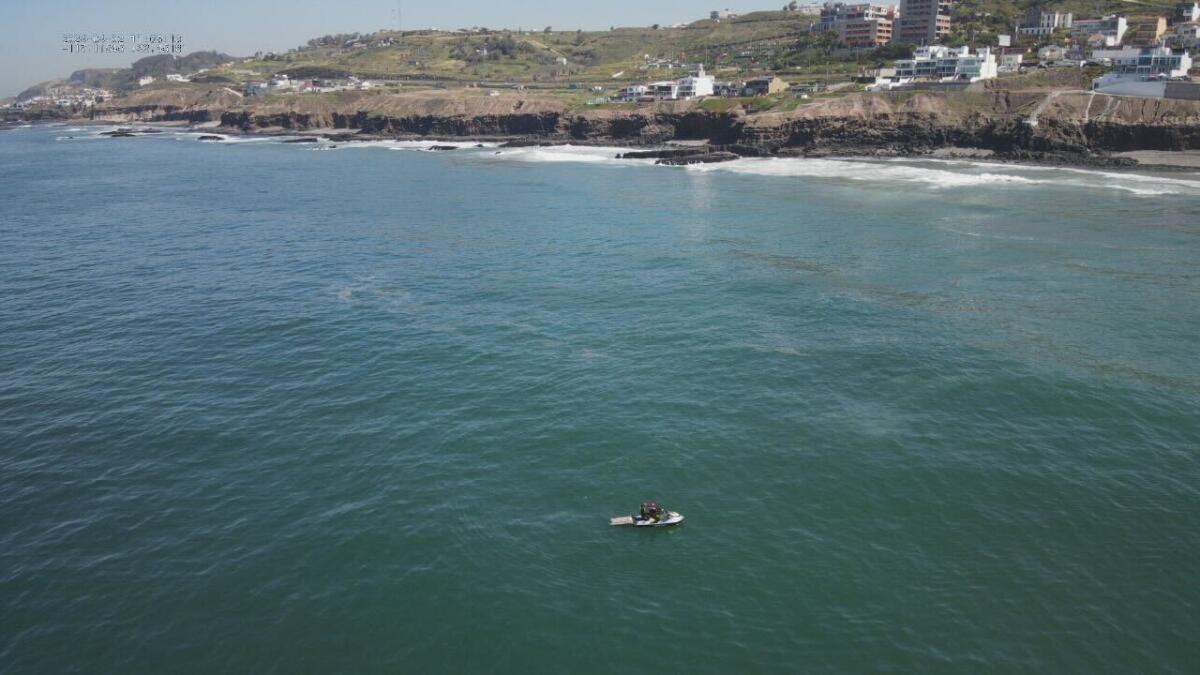
Víctor Oswaldo Villarreal had rented the boat to spend the day with his family in the Real Mediterraneo beachfront neighborhood of Tijuana
- Show more sharing options
- Copy Link URL Copied!
The body of a 27-year-old San Diego resident, reported missing over the weekend, was found Tuesday off the coast of Tijuana, according to Mexican officials and family members.
Víctor Oswaldo Villarreal was last seen Friday swimming to a sailboat he had rented in the U.S. to spend the day with his family in the Real Mediterraneo beachfront neighborhood of Tijuana.
He intended to return in a dinghy, but when it malfunctioned, Villarreal decided to try making the swim, officials said. At the time, it was high tide and the seas were rough, with the region on alert in preparation for a coming storm, said Juan Hernández, head of the Tijuana Fire Department’s water rescue division.
Rubén Ramos Jiménez, Tijuana’s regional prosecutor, confirmed that the body was found in Punta Bandera, and that a family member at the scene recognized Villarreal by his tattoos.
He said that although the man presumably drowned, investigators are still awaiting the results of an autopsy.
Tijuana Congressman Sammy Peña, uncle of Villarreal, thanked all the agencies and community members who helped during the search. “We have received a lot of support, and I’m very grateful,” he said.
Peña described his nephew as “a nice kid — an athlete, surfer and swimmer.”
The Tijuana and Rosarito fire departments, as well as Civil Protection, the State Prosecutor’s Office, the Mexican Navy and about 20 volunteers participated in the three-day search, officials said.
On social media, Villarreal’s family requested drones and jet skis to help in the search on both sides of the border.
Get Essential San Diego, weekday mornings
Get top headlines from the Union-Tribune in your inbox weekday mornings, including top news, local, sports, business, entertainment and opinion.
You may occasionally receive promotional content from the San Diego Union-Tribune.
More from this Author

Border & Baja
Murals from the old border wall were going to be destroyed. Now they will be given new life.
March 21, 2024

The most iconic stretch of border wall is being replaced. Here are the new murals with lots to say.
March 17, 2024

Immigration
Immigration detainees entitled to see judge within 11 days of arrest under class-action settlement
March 15, 2024

A La Mesa security guard accidentally drove into Mexico with a gun. It cost him a year in Tijuana prison.
March 13, 2024

Nearly 100 migrants cross into the U.S. from the Tijuana River canal
March 11, 2024

Tijuana adds cross-border students to its fast lane program — for a stiff price
March 9, 2024
More in this section
Public Safety
Six adults, one minor apprehended after suspected smuggling boat lands in Imperial Beach
The boat crossed the maritime border around 6 a.m. and landed near Cortez Avenue and Sea Coast Drive
April 2, 2024

Details released about 24-year-old Guatemalan woman who fell to her death from border wall
She reportedly clung to the top of the 30-foot border wall for over 20 minutes on March 21
April 1, 2024
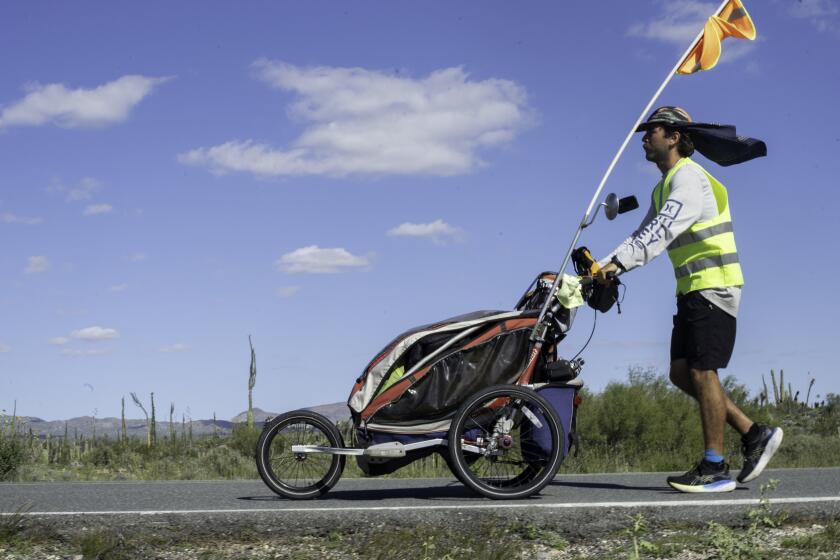
Traveler tackles the length of the Baja peninsula — on foot
Man attracts followers on his thousand-mile-plus journey of personal growth
March 30, 2024
Officials investigating after person found dead near border wall near San Ysidro
A person was found dead less than 3 miles from the San Ysidro Port of Entry Thursday night, according to federal officials
March 25, 2024

CBP officer with use-of-force history sentenced for injuring woman at San Ysidro port
Prosecutors said Andre Chevalier was terminated from two previous law enforcement jobs before he was hired as a CBP officer. He has resigned from CBP.
Homicide victim found dead in swollen Tijuana River Channel identified as resident of Mexico
Rodolfo Agosto Castillo-Ancona, 36, was found near a second dead man who has yet to be identified. It’s unclear if the deaths of the two men are related
March 20, 2024

Roblox: Build A Boat For Treasure Codes
Quick links, all codes for build a boat for treasure, how to redeem codes in build a boat for treasure, how to play build a boat for treasure, best roblox adventure games like build a boat for treasure, about the build a boat for treasure developers.
Build A Boat For Treasure has gained popularity on Roblox because of its fantastic concept, where players first have to build a boat and then test it on an obstacle course. It can often be quite challenging for Roblox players to make a good boat in the early stages of the game, which is where the Build A Boat For Treasure codes listed below can come in handy.
Roblox: Arm Wrestle Simulator Codes (March 2024)
Updated March 2, 2024, by Artur Novichenko: Although there aren't any new codes for Build a Boat for Treasure at this moment, there are still plenty of active codes, all of which have been verified as working for January. If any new codes are added over the coming month, they'll be added to this guide.
Roblox players looking to get some extra gold, blocks, and other building materials for creating a beautiful boat can use the following active codes.
These codes will expire at random intervals, so be sure to redeem them as soon as they become available. Codes can only be redeemed once per account. Be sure to check back frequently, as codes can be released anytime during the month.
Codes Checked on March 2, 2024.
All Active Build A Boat For Treasure Codes (March 2024)
- hi - Redeem for 5 Gold
- Squid Army - Redeem for 22x Ice and 22x Gold
- =D - Redeem for 5 Gold
- =P - Redeem for 5 Gold
- chillthrill709 was here - Redeem for a Firework
All Expired Build A Boat For Treasure Codes (March 2024)
- Happy Valentine's day - Redeem for free blocks
- Be a big f00t print - Redeem for free blocks
- fuzzy friend? - Redeem for free blocks
- Lurking Legend - Redeem for free blocks
- GGGOOOAAALLL - Redeem for a Football
- Free gifts - Redeem for a bunch of free gifts!
- 1B - Redeem for free blocks!
- voted code - Redeem for free blocks!
- Lurking Code - Redeem for 10x Balloons, 5x Super Fireworks, 1x Portal Block!
- 1M Likes - Redeem for free blocks!
- Big F00t Print - Redeem for 10x Balloons, 5x Cake, 25x Neon Blocks!
- The Sasquatch? - Redeem for 10x Balloons, 5x Circle Fireworks, 1x Portal Block!
- Fireworks - Redeem for free blocks!
- 2M members - Redeem for free Blocks!
- Hatched code - Redeem for Cookie Wheels!
- Happy Easter - Redeem for Balloons, Candy, & Cake!
- TTTRRREEEAAASSSUUURRREEE - Redeem for a Green Treasure Chest!
- BBBOOOAAATTTSSS!!! - Redeem for 1x Boat Motor, 1x Car Seat, 4x Wood Block, 1x Cake!
- The Yeti - Redeem for 25x Green Presents, 25x Neon Blocks!
- Cold Feet - Redeem for 25x Green Presents, 25x Neon Blocks!
- 500M Visits - Redeem for 4x Portal, 5x Cake, 25x Balloons, 20x Star Blocks!
- Veterans Day - Redeem for 10x Banners, 10x Star Blocks, 10x Balloons, 5x Circle Fireworks, 5x Cluster Fireworks, 5x Super Fireworks!
Roblox: Anime Champions Simulator Codes (February 2024)
To redeem codes in Build A Boat For Treasure, players will simply need to follow the steps outlined below. If a code does not work, they should be sure to check that it was entered correctly. Assuming it was, it may mean that the code has recently expired or has already been redeemed.
- Launch Build A Boat For Treasure
- Press the treasure icon located to the right of the screen
- Once the pop-up menu opens up, select the gear icon at the top right
- Paste the code into the field
- Press Redeem to collect the rewards
Build A Boat For Treasure is a game in which players need to make their own boat and sail as far as possible. First, players need to go to a special area where they can build and then select the tool in the second inventory slot. A menu of resources will appear there, and at first, there will be a few of them.
After the players have built their boat and placed a chair, they should sit in it and press launch. After that, players have to swim as far as possible through the obstacles. They need to be very careful because the boat can be destroyed. After reaching a certain distance, players will receive rewards and can then repeat the process.
There are many games similar to Build A Boat For Treasure. Below, players will find a list of the top five games like Build A Boat For Treasure :
- Anime Adventures
- Your Bizarre Adventure
- Dragon Adventures
- Boat Ride into a Better Life
- Build a Boat or Die
The team of developers, named Chillz Studios, who created Build A Boat For Treasure in 2016, has a lot of experience in creating games. Here is a list of other Roblox games from Chillz Studios that were popular before:
- REVENGE OF THE SLIMES!!!
- Mr. Cube The Boss Battle!
- Marble Maker
- Build and Burn
Roblox - Game
Developer(s) Roblox Corporation
Publisher(s) Roblox Corporation
Platform(s) PS4, PC, iOS, Android, Xbox One
Released September 1, 2006

Young girl talks about first ever trout, experts explain which baits to catch more fish

As trout season gets underway across Pennsylvania, anglers are looking forward to the excitement of catching a fish and experts are providing advice on what baits and lures are working the best.
Avery Keith, 6, of Somerset, caught her first ever trout during the Mentored Youth Trout Day on March 30 and is looking forward to fishing over the opening day weekend.
“It was exciting,” she said about watching the rainbow trout grab her bait and start pulling on the line.
She was fishing with her family in Fairhope, Somerset County. They didn’t get a chance to measure the fish as they quickly returned it to the water for someone to catch another day.
“It flopped off and we picked him up and got a picture quick and got him back into the water,” her mother Meagan said.
She was using butterworms for bait and her cousins caught fish on them, too. Avery was also fishing with her dad, Justin, and brother Camden, 9.
“We had a lot of fun, we try to do it every year with the kids,” her mother said. The family goes out Friday for fishing camp in a cabin and then goes fishing in the morning.
She said live bait like fishworms, meals and butterworms work well for kids who are learning to fish. “The butterworms seemed to work the best that day,” she said. They also used spinners and pink colored PowerBait.
Avery said she enjoys fishing and spending time with all the family members.
“I’m looking forward to having fun and catching fish,” she said about going again.
The statewide trout season runs April 6-Sept. 2, with anglers being able to keep five trout a day that are at least seven inches long.
There are plenty of options for those who want to fish with a spinning rod or fly rod.
Advice for your tackle box
In northwestern Pennsylvania, Dominic Ferrante, a salesman at Poor Richard’s Bait and Tackle , Fairview in Erie County, has a variety of bait options that work well for stocked trout.
For those using bait, he suggests minnows.
“Emerald shiners are the best. We have different kinds but Emerald shiners work very well,” he said.
Other baits that have proven themselves include waxworms and mealworms.
“Live bait is the most thing we sell for the first day of trout,” he said. “Live bait is the way to go.”
Are you ready?: A look at what you need to know to fish for trout this spring across Pennsylvania
In eastern Pennsylvania, Mike Schwartz, firearms and assistant fishing manager of Dunkelberger’s Sports Outfitter, also said live bait is a good choice.
“The popular baits are still mealworms, red worms, night crawlers, fatheads (minnows) are also very popular. PowerBait is one of the biggest sellers we have here and salmon eggs.”
Regarding PowerBait and eggs, Schwartz said yellow and orange have been popular choices for those targeted stocked trout. “For some reason garlic scent seems to work well, too, “ he said.
The company has locations in Stroudsburg and Brodheadsville in Monroe County. He said the smaller spinners are popular, too.
Ferrante also recommends small spinners like Rooster Tails or spoons like Kastmaster or Little Cleo that imitate minnows.
“For stocked trout I would go smaller,” he said about choosing lure size for fish that average 10 to 11 inches long. “I wouldn’t go too big. They might shy away or get spooked.”
For those using a fly rod, Ferrante said to use designs that mimic a minnow or fish eggs.
“The stone fly I believe just hatched. Stone flies would be a good go to right now,” he said.
Schwartz also likes to catch trout with a fly rod.
“Nymphs, streamers, woolly buggers are all good for early season fly fishing,” he said. “If there’s no hatches on the water, go to a woolly bugger or a streamer. A streamer is a fly fisherman’s spinner,” he said because it imitates a minnow. “Blacknosed Dace, Micky finns, they are all really great streamers for this part of the country.”
Something relatively new that’s been catching on with anglers is a product call Trout Magnet.
“That’s real hot. It’s a real tiny 1/32 ounce jig with a little rubber grub on the back. It’s not really that new but people don’t know about it and it’s something to try,” Schwartz said.
You can use the rubber split tails that come with the kit, but some anglers put live bait like wax worms on the hooks, too.
Color choices based on water clarity
Changing water levels are common with April rain showers and anglers need to be able to adjust to different conditions.
“If the creeks are high, ponds would be the best bet until it calms down,” Ferrante said.
If you decide to fish a stream when the water is cloudy or high, he said the deeper holds attract and hold fish.
“In the rapids, your bait will just fly by the fish,” he said about avoiding faster water.
“Clear water I do more flashy like silvers and golds, something that will shine off the light. When it’s darker, I would do chartreuses or pinks, anything brighter, UV, glow in the dark,” he said. “Trout and steelhead have pretty good eye vision, so they can find them pretty good.”
Darker lures, like blacks and browns, work in a variety of conditions.
“Black jigs are always a go to. I would say that anytime, sunny or cloudy,” Ferrante said.
Schwartz said anglers should change their lure colors based on the clarity of the water.
“If the water is dark, fish dark. If the water is light, fish light. It goes against what you think," Schwartz said. "A shiny lure in the dirty water would be more attractive, but it’s not real. If you fish a brass colored spinner blade in dark water, you’re going to do better. Silver for clear, dark for dirty is a simple thing to remember.”
The key is being willing to change colors and lures if the fish aren’t biting on what you have out there.
“Try a little bit of everything. When something works, stick with it,” Schwartz said.
More: Angler researches lowering lakes from the bottom to cool waters and help trout survive
New fishing line
There are many types of fishing line available for spinning rods, including monofilament and fluorocarbon
Ferrante said for stocked trout monofilament line ranging from four- to eight-pound test is a good choice.
“They are small fish. I wouldn’t go larger than eight pounds,” he said.
Fluorocarbon lines are clear in water but are more expensive than monofilament and they can tangle easier. To give anglers the best of both worlds, he recommends filling your spool with monofilament and then using a several foot long leader of fluorocarbon on the end of the line to connect your lure or bait.
“It’s a preference thing,” he said about the variety of choices that are available.
How many trout are in Pennsylvania?
About 4 million trout are being placed in waterways across the state this spring by the Pennsylvania Fish and Boat Commission and sportsmen groups who operate cooperative nurseries.
The PFBC plans to release 2.4 million rainbow trout; 702,000 brown trout, 132,000 brook trout and 14,000 golden rainbow trout. As with past practice, the average size of the trout produced for stocking is 11 inches in length with an average weight of .58 pounds.
In addition to trout raised at state fish hatcheries, PFBC cooperative nurseries operated by sportsmen’s clubs and other groups across the state will add another one million trout to waters open to public angling throughout the year.
The PFBC places trout in 697 streams and 129 lakes across the state for anglers to enjoy.
Who needs a license to fish in Pennsylvania?
Anglers 16 years of age or older must possess a valid Pennsylvania fishing license. The cost for a resident fishing license is $27.97 and the trout permit is $14.97.
Fishing licenses and permits can be purchased through the HuntFishPA online portal on the Pennsylvania Fish and Boat Commission (PFBC) website (Fishandboat.com), on your smartphone using the FishBoatPA mobile app, or by visiting one of nearly 700 retail license issuing agents like sports shops and county treasurer offices.
Dates to remember
There are several important dates for trout anglers this year:
- April 6 — Statewide Opening Day of Trout Season at 8 a.m., creel limit of five trout that are at least seven inches long.
- May 26 and July 4 are two Fish for Free Days when no license is required to fish on public waterways.
- Sept. 3 — Extended trout season begins with a creel limit of three.
- Nov. 1 through April 30 — Mandatory Life Jacket Requirement in effect for boats under 16 feet long, canoes, kayaks and paddleboards.
Catch and release
If you don’t want to keep your fish, the commission offers the following advice to give your catch the best chance for survival:
- Use barbless hooks.
- Play fish quickly.
- Try to land your fish as quickly as possible, don’t play the fish to exhaustion, and use a landing net.
- Keep the fish in the water. The chance of a fish being injured increases the longer it is held out of water.
- Wet your hands, net and other materials that may come in contact with the fish.
- Hold the fish upside down while removing the hook. This can often pacify the fish and reduce handling time.
- Remove hooks quickly. Hemostats or long-nose pliers are essential tools for quickly removing hooks.
- Cut the line. When it is not possible to remove the hook without harming the fish, cut the line.
- Don’t touch the gills. Do not handle fish by placing your fingers in the gill slits.
- Hold the fish upright underwater after hook removal and allow it to swim away under its own power. If necessary, hold the fish out of the current until it revives.
Brian Whipkey is the outdoors columnist for USA TODAY Network sites in Pennsylvania. Contact him at [email protected] and sign up for our weekly Go Outdoors PA newsletter email on this website's homepage under your login name. Follow him on Facebook @whipkeyoutdoors , and Instagram at whipkeyoutdoors.
The unspoken rules about how to behave on a superyacht
- The superyachting world is very small, with only 5,800 yachts longer than 30 meters at sea.
- That insularity has bred a specific etiquette, which is often hard for outsiders to know about.
- These are the de facto rules of the most expensive billionaire toys, superyachts .

For the owners of superyachts , privacy is often the most valuable thing money can buy. It's one reason centimillionaires and billionaires pay eight or nine figures for a palace at sea, far from the prying eyes of land dwellers.
Even the most gossipy crew members should stay tight-lipped about the name of a former owner or charter guest, and many brokers shy away from answering benign questions.
That means that, aside from basic safety guidelines, most of the rules of superyachting are unwritten. The very few who need to know them — there are only about 5,800 yachts longer than 30 meters at sea, according to SuperYacht Times — already know them.
But if you do happen to be a lucky guest at a party on a billionaire's $500 million ship or find yourself included in a $1 million-a-week vacation, there are a few things you need to know.
After four days of touring superyachts that sell for as much as $75 million and chatting with the people who buy, sell, and work on them at the Palm Beach International Boat Show , Business Insider gleaned a few key edicts. Given the discreet nature of the industry, almost all the people we spoke with requested anonymity to protect their working relationships, but here's what they had to say.
Take off your shoes
While it's a basic rule for anyone in boating, it may come as a surprise to an outsider that no matter how rich you are or how expensive your heels are, in the vast majority of cases, you can't wear shoes on board.
It's partly for safety — you don't want anyone slipping on a wet deck — but partly to keep the yacht clean. So expect to see barefoot billionaires, and if you forgot to get a pedicure, bring a set of special boat shoes.
Don't make any assumptions about money — but know the signs
In the superyacht world, it's safe to assume almost everyone you meet is very, very rich, and many brokers and builders say you can't judge a book by its cover when it comes to prospective clients.
"It has nothing to do with how they're dressed," one broker told BI. "It's the biggest mistake you can make because a complete slobby-looking guy or couple could be a multibillionaire."
There are, however, a few clues. Watches are one; new footwear is another.
"Rich people always have new shoes," a superyacht expert said. But because of the shoe rule mentioned above, this tip probably applies only when they're on land.
Book your massage early
Wellness areas, including spa rooms with a massage bed or two and a professional-grade facial machine, are becoming must-haves on superyachts . Most have a customized spa menu and a crew member who doubles as a trained masseuse or beautician — and they're usually in high demand.
One captain said he'd implemented a booking system to ensure people weren't fighting for the same spots. A broker said sometimes masseuses would be so busy they wouldn't leave the small spa cabin for hours on end.
Related stories
So if you want to make the most of your relaxing time on board, reserve your pampering slot as soon as you get your welcome cocktail.
Pirates are more real than you'd think, and many superyachts have hidden safe rooms
While you might dress up as a fake pirate for an onboard theme party, there are very real ones — and other dangers — on the high seas.
In certain areas, including parts of the Indian Ocean and the Gulf of Aden, pirates are a cause of concern . In the Red Sea, owners are concerned about the Houthis .
Superyachts can come equipped with sonic weaponry, lockdown systems, and anti-drone protection. Builders are even designing safe rooms — which are apparently just as plush as the rest of the ship.
The longer the boat, the closer to $1 billion
While you can't judge a buyer based on appearances, you can judge them on the length of their boat.
One rule of thumb: If someone has a brand-new 50-meter vessel, chances are they have $1 billion to their name. If it's over 100 meters, expect the owner to have at least $2 billion. And for a boat bigger than that — like Jeff Bezos' 127-meter megayacht Koru — it takes many, many billions.
Money can't buy you everything
The world's biggest, most expensive yachts are custom-built by shipyards that produce only a handful of boats a year.
But no matter how many tens of millions of dollars clients are spending, there are things to which builders will refuse to say yes.
"In the end, the boat has our name," an executive from one of the world's biggest shipyards told BI.
They recalled a client who requested a yellow hull to match his Lamborghini . The shipyard declined, steering the client in another direction.
"If I don't like it, I don't build it. I finalize two or three contracts a year," another builder said. "If somebody can say your vessel is ugly, my reputation is bad."
Yacht crews are trained to make the impossible possible. A guest requests fresh caviar flown into the middle of the Caribbean? No problem. Fresh flowers every day while at sea? It'll cost you, but it can be done.
But they can't time travel, and captains and crew members say the thing that causes the most friction is when a client or owner wants to go from point A to point B — right now.
"The hardest request is when they want the boat in a place — yesterday," one captain said.
The best person to know? A friend with a superyacht
Superyachts are expensive to build and expensive to maintain . According to the industry standard, owning a superyacht will cost 10% of its new-build price annually. For a $100 million yacht, that's at least $10 million yearly going to crew, regular maintenance, insurance, fuel, and dockage.
Chartering, too, is costly . Beyond the list price, which can be hundreds of thousands a week, guests must pay for provisions, which are pegged at 35% of the charter fee, and are expected to tip between 10% and 20%.
So the most important unspoken rule of superyachting is actually that the only thing better than owning a superyacht is knowing someone else who does — and invites you along, of course.
Watch: Why it costs $1 million a day to run one of the world's biggest cruise ships
- Main content

IMAGES
VIDEO
COMMENTS
Mar 15, 2024. Original: Aug 5, 2016. A rigid-bottom inflatable with a powerful outboard is the tender of choice for many cruisers. Before choosing which inflatable dinghy is right for you, there are many factors to consider. Some sailors claim that the inflatable boat has killed the traditional rowing sailing tender.
Generally speaking, fully inflatable dinghies that measure around 10-feet in length support a 5-8 horsepower outboard, which is sufficient for the basics. For a more capable inflatable, look for a 10-25 horsepower outboard. Just be cautious, as too much power can flip a lightweight dinghy.
The larger the tube, the greater the boat's reserve buoyancy and the better its handling and carrying capacity is. The more air chambers it has, the safer it will be should one chamber spring a leak or get punctured. A cruising sailors dinghy should have a minimum of three air chambers, but four is even better.
These tough, abrasion-resistant hulls have a bumper boat tolerance thats a big plus when it comes to kids learning to sail. Best of all, owners can start with a learn-to-sail rig and upgrade to a more performance-oriented mast and sail package (41 or 56 square feet) that kicks performance into the fast lane.
Cons of Cruising in an Wanderer Sailing Dinghy. While the Wanderer is a great boat for sailing, a potential downside to this dinghy is the need to have multiple crew onboard. While sailing a Wanderer can undoubtedly be done solo, for most sailors, having some extra hands on deck will make sailing the 2-3 person Wanderer dinghy much more pleasant.
1. Twelve of the best training boats Sailing schools, clubs and training centers use a variety of boats with beginners, including singlehanders such as the Pico, Hartley 10 and the RS Quba, the latter having three rigs catering from entry level to more experienced sailors. There's also a range of larger training dinghies from builders such as RS, Topper, Laser and Hartley Boats.
Sailing World's Boat of the Year judges praised it for its performance and universal appeal. The Happy Cat Hurricane is an 18-foot inflatable sailing catamaran built of high-quality rubber.
The boats weighs 68kg for the 3.3m or 74kg for the 3.5m, while the sailing components add just 15kg. Both are also available in carbon versions (a NZ$4,000 upgrade). The slight catch may be the ...
Release the dinghy and use a paddle or oar to push away if needed. Paddle or row to navigate away from obstacles and into open water. Once a safe distance from shore, raise the sails if applicable, following proper procedures. Adjust the sails and tiller as necessary to control the direction and speed of the dinghy.
Short answer: Sailing dinghy types A sailing dinghy is a small boat with sails used for recreational or racing purposes. There are various types, including single-handed, double-handed, and trailerable dinghies. Examples include the Laser, 420, and Optimist. Exploring the Different Sailing Dinghy Types: A Comprehensive GuideIntroduction: Sailing dinghies are small boats that are commonly used
Sailing World Magazine's Best Dinghy of 2024 is the RS Toura, a 15-foot rotomolded plastic dinghy designed for sailing schools and community boating, yacht clubs and adult and junior sailing ...
Tiwal 3R 2023 Best Dinghy. Stated purpose: Recreational sailing, one-design and rally racing. Crew: One to two. Praise for: Performance, comfort, portability. Est. price as sailed: $8,900. The ...
1. Stability. Opt for a dinghy that offers stability, allowing you to learn and build confidence in your sailing skills. Look for boats with a wide hull and a low centre of gravity. 2. Size. As a beginner, it's recommended to start with a smaller single handed sailing dinghy. Smaller boats are easier to handle and manoeuvre, making it simpler ...
Short answer: Sailing Dinghy A sailing dinghy is a small, lightweight boat designed for recreational or competitive sailing. It typically has a single mast and sails, and can be sailed by one or two people. Dinghies offer an accessible way to learn and enjoy sailing, with various types available including the popular Laser, Optimist, and
Understanding trade-offs is the key to selecting the right dinghy. Each type of dinghy has both strong points and limitations. Charter companies love the durability and ease of repairs that comes with fiberglass dinghies. From the main boat they are easy to get in and out of. In addition, they carry loads easily and stand up well to the wear ...
Best Dinghy for Small Sailboat. Thread starter SailorElliot; Start date Jul 19, 2021; Tags dinghy flicka 20 inflatable dinghy; Forums. Forums for All Owners. ... do not think there is a best dinghy. I like a low cost, lightweight (52-53 lbs) rollup dinghy like a West Marine PRU-3 for $1000 WEST MARINE PRU-3 Performance Roll-Up Inflatable Boat ...
Tie the boat securely on the trolley. Put the detachable items inside the Dinghy. Fit the boat cover over the top and make sure that it is fastened firmly. Secure it under the Hull, Bow, as well as the sidedecks. To prevent your Dinghy from being blown over, tie the Sailboat down to securing points on the ground.
What is a Dinghy Sailboat? Dinghy sailboats are small, single-person boats with a sail to add power. Dinghies can be rowed or sailed, but if you're new to the sport of dinghy sailing, it's best to find a boat that has both options. Most dinghies have a rudder for steering and are made of lightweight materials like aluminum or fiberglass.
Sailing. The dinghy is one of the few boats left that offer a sailing configuration. If you're into boating on lakes or thinking about sailing competitively, the dinghy is the best choice. Any of the sailing models listed above are a great choice. Pick the boat that offers you the best utility for your sailing needs. Minimal Noise
420. The 420 is a small, two-person racing dinghy that's ideal for beginners. It's also a great boat for experienced sailors looking to get into competitive sailing. With its fast hull design and lightweight rig, the 420 can travel faster than most other dinghies. The 420 is simple enough that you'll be able to learn how to sail it in ...
The West Wight Potter 19 could potentially be the best cabin sailboat for beginners, and certainly one of the safest—the West Wight Potter 19, according to the manufacturer, is quite literally unsinkable. The hull is filled with buoyant materials, allowing the boat to be flooded and remain afloat.
The sails, foils, trim of the boat, the dingy's balance on the windy weather, and the predetermined routes are the main important things to control. The term "dinghy" came from East India and referred to a rowing boat that is used to sail on India's river. Before trying dinghy sailing, you need several things to prepare.
Check to ensure you have oars in your dinghy. If not, locate them and place them inside. *Given the numerical order of 'Step #1', it is safe to assume the author has reason to consider this a vital step. Lower the engine into the water. For troubles lowering your engine, refer to The Outboard Motor Won't Tilt Down below.
The pleasure derived from sailing is largely contingent on the kind of boat employed and, crucially, the sailor's ability to navigate it. A sailor will find it greatly more enjoyable to sail a ...
The Love Boat: A Top Travel Influencer This popular series (from the 1970s and '80s) introduced millions of American TV viewers to cruising, propelling the rise of passenger ships by showcasing ...
Víctor Oswaldo Villarreal was last seen Friday swimming to a sailboat he had rented in the U.S. to spend the day with his family in the Real Mediterraneo beachfront neighborhood of Tijuana ...
Build A Boat For Treasure, Launch Build A Boat For Treasure. Press the treasure icon located to the right of the screen. Once the pop-up menu opens up, select the gear icon at the top right. Paste ...
1. Twelve of the best training boats Sailing schools, clubs and training centres use a variety of boats with beginners, including singlehanders such as the Pico, Hartley 10 and the RS Quba, the latter having three rigs catering from entry level to more experienced sailors. There's also a range of larger training dinghies from builders such as RS, Topper, Laser and Hartley Boats.
Regarding PowerBait and eggs, Schwartz said yellow and orange have been popular choices for those targeted stocked trout. "For some reason garlic scent seems to work well, too, " he said. The ...
Superyachts are expensive to build and expensive to maintain. According to the industry standard, owning a superyacht will cost 10% of its new-build price annually. For a $100 million yacht, that ...